

Tourism Through the Ages: The Human Desire to Explore
- Read Later
Although taking a summer vacation is now a standard aspect of modern-day civilization for many, it wasn’t always that way. Tourism was far less common in ancient times than it is today, but that certainly doesn’t mean it didn’t occur at all. Even in ancient times, people had a natural curiosity about the world around them and yearned to explore.
However, tourism didn’t necessarily look the same then as it does now. So what did tourism look like, and where did ancient peoples like to travel the most? What was the perception of tourists in ancient times versus today?
What was Ancient Tourism Like?
Tourism as we think of it has not always existed. In fact, travel was not possible for most people in ancient times. Travel was often difficult and full of dangers such as disease , starvation, dehydration, or death by wild animals. Because of this, travel was often seen as too risky unless absolutely necessary, such as for relocation, or religious, political, or medical purposes.
However, travel did still happen. Armies would travel to take over new lands or conquer new cities. Tradesmen would travel to popular trade spots throughout their countries to sell goods for profits, while others would travel there to buy utilitarian or luxury items for their homes. Others would travel for important religious ceremonies that they were required to attend. Travel of this nature was considered a need within society, rather than a want, so not tourism as such.
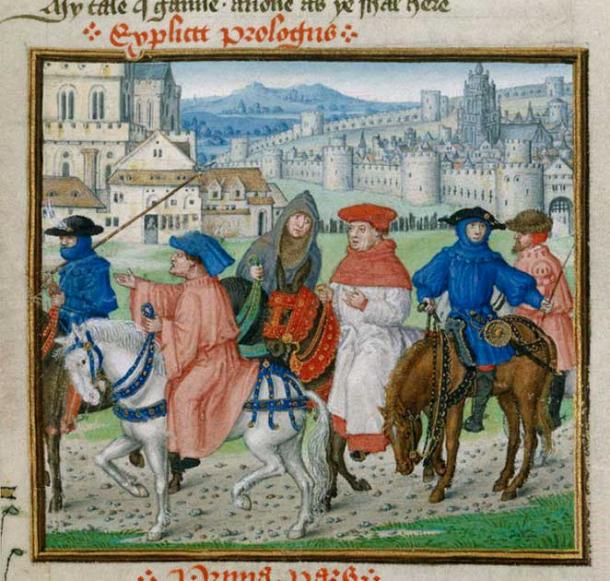
Lydgate and Pilgrims to Canterbury. Early ‘tourism’ was frequently for religious ceremonies and pilgrimages. (Jim Forest / CC BY NC ND 2.0 )
As time went on, technology advanced. With the expansion of roads and the development of more efficient travel using boats , chariots , and carriages, travel for leisure, or tourism, became an intriguing possibility. However, many individuals struggled with the same tourism questions we do today: if they could even afford to travel, and if they could, where they would go.
Early tourists tended to avoid cities with political or civil unrest as it could be dangerous in the event of an uprising. It’s unsurprising these would be eliminated as tourism destinations . They would also avoid cities their own regions had hostility towards, as that was also considered risky business. They would instead choose regions that were not known to be dangerous, just to see what was out there.
Although technological advancements made travel easier than walking or horseback, it was still perilous and time-consuming. Travelers would often bring small weapons for protection, along with any money they planned to spend. Travel would take from a few days to a few weeks (or even a few months!), depending on how far they planned to venture out. This also meant having to take preserved food with them to last the journey, or knowing where to stop along the way to find food when hungry. There were few to no establish tourism ‘rest stops’ in ancient times.
- Colosseum Will Have a Floor For The First Time in 1500 Years!
- Ancient Journeys: What was Travel Like for the Romans?
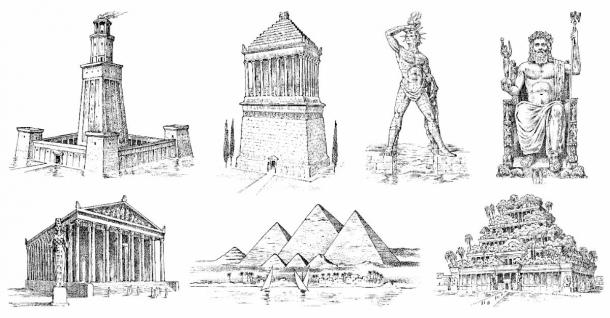
The Seven Wonders of the Ancient World ( artbalitskiy / Adobe Stock)
Tourism Destinations of the Ancient World
There were many tourism destinations available in ancient times, but some were more popular than others. Particularly, ancient tourists enjoyed tourism spots that served multiple purposes. This started as early as the times of the ancient Egyptians , who often traveled for government activities but would stay in foreign areas longer than necessary to enjoy the local shops, restaurants, games, and other forms of entertainment.
This desire to stay abroad for entertainment continued with the Roman Empire. The Romans developed a system of roads that covered approximately 50,000 miles, in order to make travel easier. At the time, traveling 30 miles would take about a day, and they used that information to establish an inn system. Through this system, an inn would be placed approximately every 30 miles, so that you always knew you had a place to rest in the evenings as you traveled out.
With more tourism establishments like inns along the roads , travel felt safer as well. There would be more people present in case of an emergency, and a lower chance of running out of food or water. The risk of natural predators would be lower as well, since travel would no longer take place through endless plains or overgrown wilderness. The Roman system became so well-established that people from surrounding areas would visit Rome, just to see the roads, inns, and other established infrastructure.
Language and currency were an important part of tourism at this time as well. If your destination used a different currency or spoke a different language, you would likely be a bit reserved about spending much time there (if any time at all!). As a result, common tourism areas did business in several common languages, so they could be more inclusive of visitors and receive more tourism.
Tourism in the Middle Ages: Risky Business
After the fall of the Roman Empire , tourism was not the same. In fact, tourism hardly happened at all anymore because there was too much risk involved. Nations were at war with one another, and traveling to a new place meant inevitable danger for the traveler and their family. Lots of the efficient transportation infrastructure were now destroyed, and languages were more separated than ever.
Travel returned to being a necessity rather than a vacation. Religious and political motives were the primary causes of any travel, as nations attempted to overtake one another. Trade routes had to be re-established, although many were still unwilling to risk the trek. It wasn’t until Marco Polo took the risk and began to write about his solo tourism in the 13th century that people began taking interest in exploration again.
By the Renaissance , trade began to take hold once more, and so merchants were willing to travel further than before. Additional trade and tourism businesses opened, and commercialism steadily increased, especially in Europe. People that would visit these trading posts to purchase new and luxury goods would wonder what the rest of the world was like, especially the sources of their favorite goods. This then ushered in the Grand Tour Era.
- Why Did Ancient People Travel Thousands of Kilometers for Incense?
- The Surprising and Iconic Bronze Age Egtved Girl: Teenage Remains Tell a Story of Trade and Travel

Exotic new products entering Renaissance markets fed a desire for tourism, Jan van Kessel the Elder 1650-1660 ( Public Domain )
The Grand Tour Era: Tourism for the Rich and Famous
The Grand Tour Era, as can be assumed by its name, was a major point in history for tourism. Between 1613 and 1785, the Grand Tour Era established tourism as a norm throughout many societies. However, it wasn’t always easy. Traveling at this time was mostly reserved for the upper classes, as travel and lodging had increased in price due to high demand. Rooms that could be provided for an average family were instead reserved for those able to pay the most.
Tourism was also held in high regard at this time because it was often used as a form of education. The children of the wealthy would travel abroad to gain an understanding of the world around them, making them more knowledgeable and well-rounded. Someone who’d had the opportunity to engage in tourism was seen as having a higher status than most, since they were perceived as more educated.
The most popular tourism regions at this time included Germany, Italy, France, and Switzerland. Europeans would often travel to these countries by carriage because it was more comfortable. Their carriage would be driven by an experienced chauffeur familiar with the routes, to make travel as efficient as possible. Tourists would frequently bring someone with them that would care for them, whether a servant or a more experienced traveler.
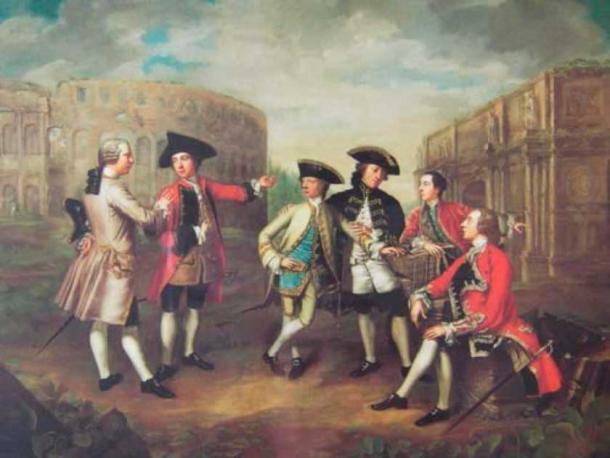
British Gentlemen in Rome, circa 1750 ( Public Domain )
Ushering in a New Era: The Industrial Revolution to Modern Times
Towards the end of the 18th century, tourism faced new challenges. The Industrial Revolution had changed tourism forever. Since people had more stable employment, they couldn’t take off for long periods of time to travel. Workers were stuck in their factories and businesses all week, unable to leave without jeopardizing the entire organization. Teamwork was essential and left no flexibility for vacationing.
However, the Industrial Revolution also helped people to travel more easily too. With new technology, travel became more efficient. Plus, for many workers, higher salaries contributed to their ability to go on a nice vacation. Additionally, business trips were increasing, to open more businesses and factories.
After several decades tied down to work and missing out on tourism experiences, workers began tiring of their overworked schedules. With more money came greater desire to expand one’s worldview. Planes, cars, and boats could be used to travel more quickly and comfortably than before. Office jobs also became more popular for their greater flexibility, and paychecks began to be used to see the world.
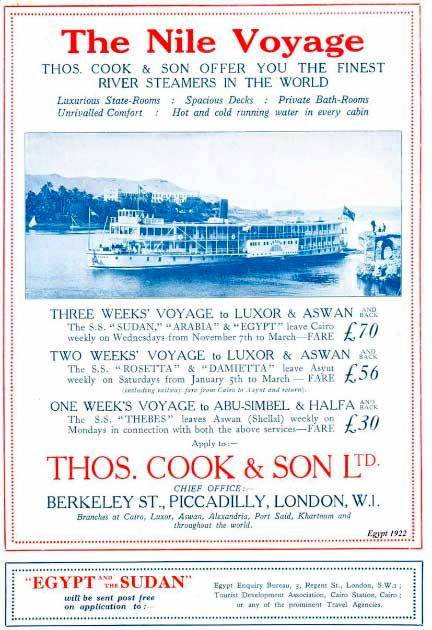
A 1922 Thomas Cook ad for a three-week trip on the Nile for £70 ($80) ( Public Domain )
At this point, tourism became an essential part of a fulfilling life. Countries such as France became hot spots for tourism because they had advanced technology and roads compared to other regions. Thomas Cook, an English businessman, inspired those without tourism experience to take a leap and go on an adventure. Later, paid work leave established for many in the 20th century ensured that more families could take the time to travel. It was the biggest increase in tourism since the Grand Tour Era.
Throughout the 20th century, hotels and motels became more common businesses worldwide, further fueling the tourism industry. Later, the development of credit cards helped lower-income families afford vacations more easily. Credit cards also helped universalize currency, so traveling between countries and buying necessities became more efficient. In the 21st century, traveling has become more accessible than ever.

1957 postcard showing tourism airline interior (Joe Haupt / CC BY SA 2.0 )
Tourism Today: Roadside Attractions, Cruises, #VanLife, and more
Tourism in ancient times could be difficult, but those early tourists certainly made the most of it. Today, travel and tourism are certainly much simpler than they were back then. There is more available information about different countries that can be considered before taking a trip, and most frequent travelers are looking for more than just new scenery. Tourism agencies now seek to put together packages for those looking for adventure, romance, or knowledge.
The biggest difference between ancient and modern tourism is purpose. While ancient people traveled as a way to learn about the world around them, modern tourists seek to gather and savor experiences. Experiencing new places and cultures is more fulfilling than simply learning about the place online. If nothing else, travel nowadays is certainly much more efficient and luxurious than ever before. After all, aren’t you glad you don’t have to take a chariot everywhere?
Top image: Vintage postcard showing European tourism destinations. Source: Freesurf /Adobe Stock
By Lex Leigh
A Historical View of Tourism . Study.com. (n.d.). Available at: https://study.com/academy/lesson/a-historical-view-of-tourism.html
Gyr, U. (December 13, 2010). The History of Tourism: Structures on the Path to Modernity . EGO. Available at: http://ieg-ego.eu/en/threads/europe-on-the-road/the-history-of-tourism/ueli-gyr-the-history-of-tourism
Rodriguez, C. P. (June 16, 2020). Travelling for Pleasure: A Brief History of Tourism . Europeana. Available at: https://www.europeana.eu/en/blog/travelling-for-pleasure-a-brief-history-of-tourism
Stainton, H. (May 27, 2022). The Fascinating History of Tourism . Tourism Teacher. Available at: https://tourismteacher.com/history-of-tourism-2/
Tourism . (n.d.) Encyclopedia Britannica. Available at: https://www.britannica.com/topic/tourism

Lex Leigh is a former educator with several years of writing experience under her belt. She earned her BS in Microbiology with a minor in Psychology. Soon after this, she earned her MS in Education and worked as a secondary... Read More
Related Articles on Ancient-Origins
New Tour: Brazil - Rock Art & The Pantanal

Autumn Saver Offer - Save up to $770
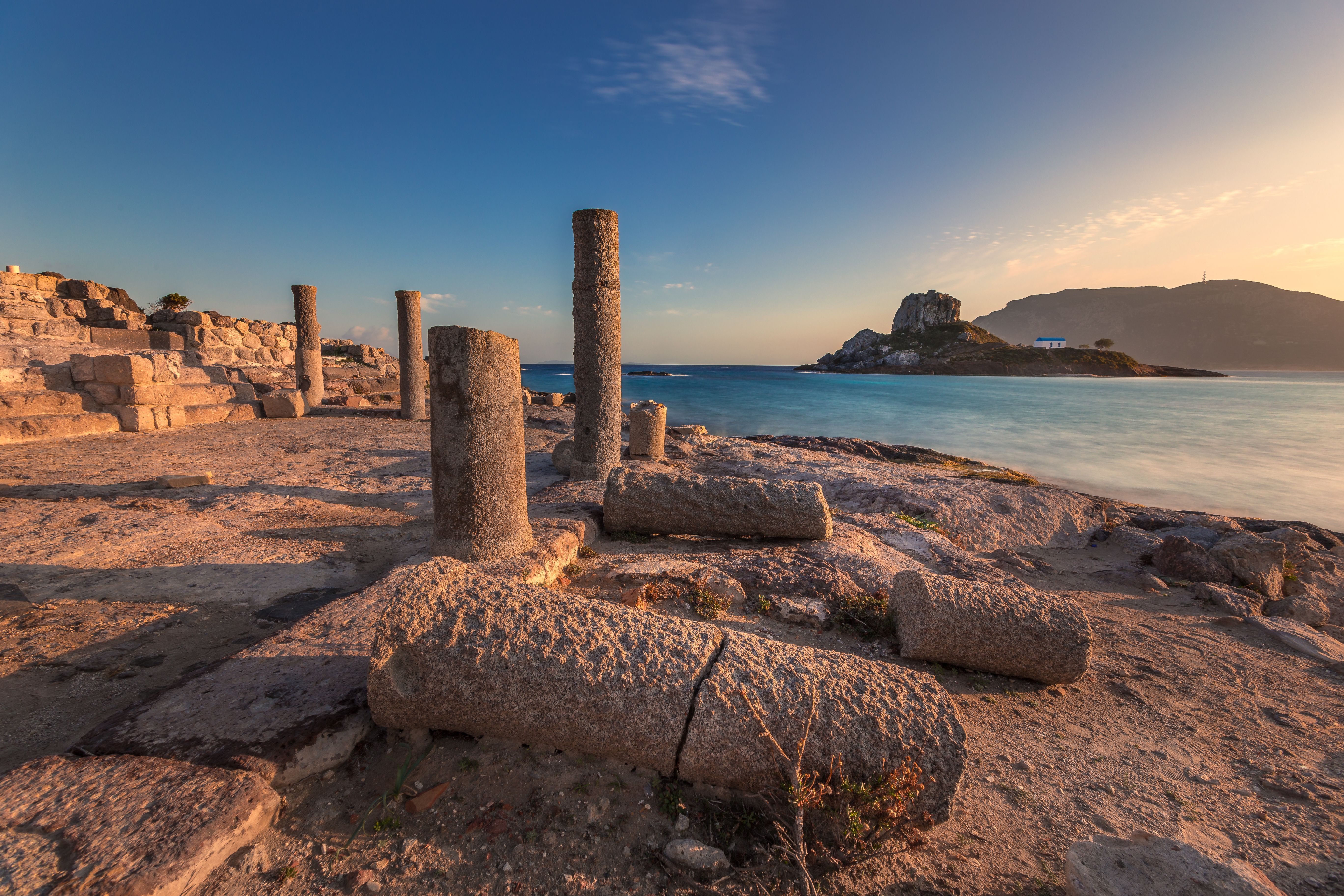
New 2025 Tours
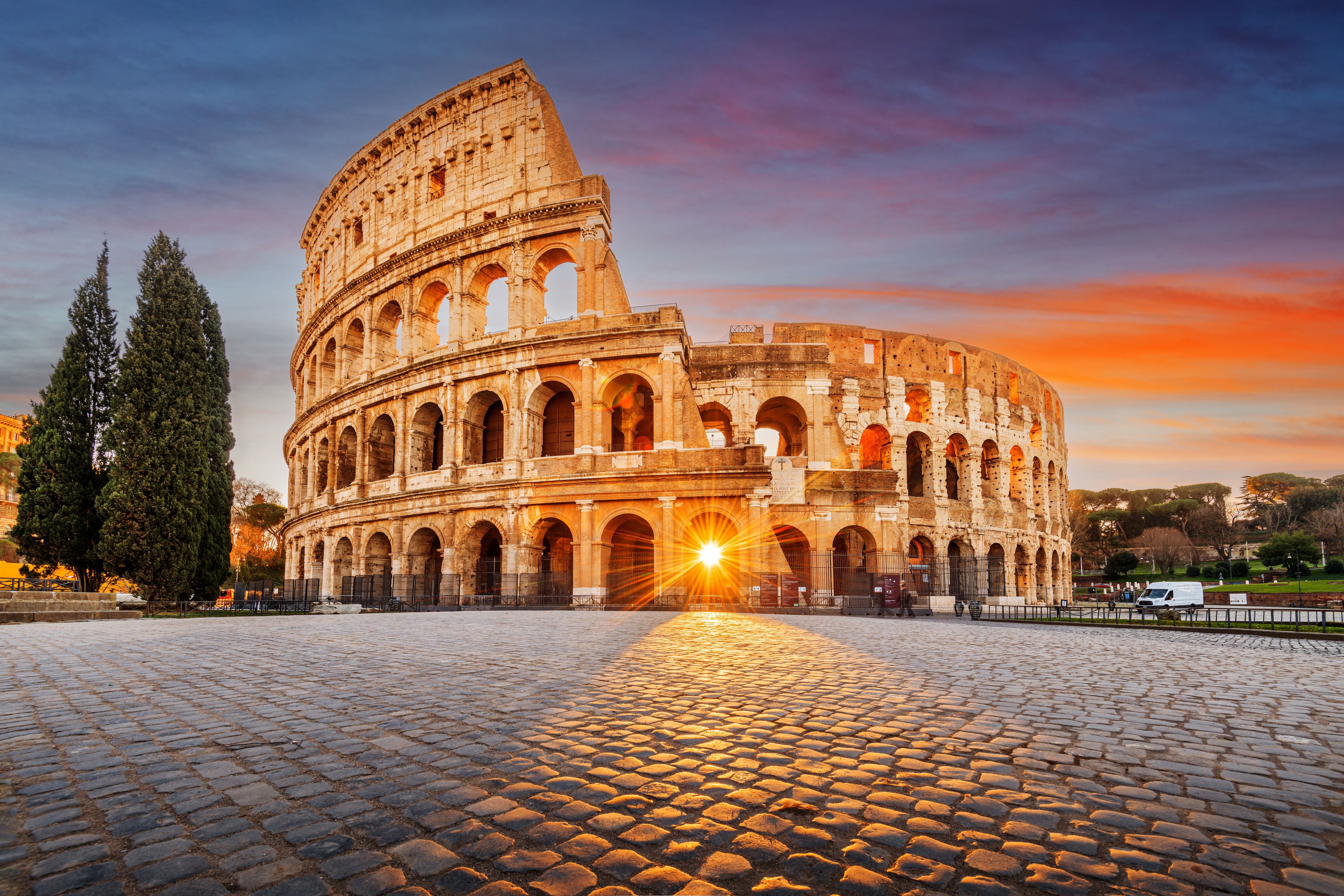
ADVENTURES IN ARCHAEOLOGY
New Rock Art Tour
Autumn Saver Offer
View 2025 Tours
2024/2025 Tours
Journey into the ancient world
An archaeological adventure with Andante Travels brings the past vividly to life, in a way no ordinary encounter with ancient cultures can do. Let our passionate experts explain todays link with yesterday’s civilisations and use their privileged and profound knowledge to satisfy your curiosity.
Immerse yourself in the ruins, relics, rock art, henges, barrows, forts, temples, castles and keeps that testify to the miracle of human ingenuity they represent, making lifelong memories along the way.
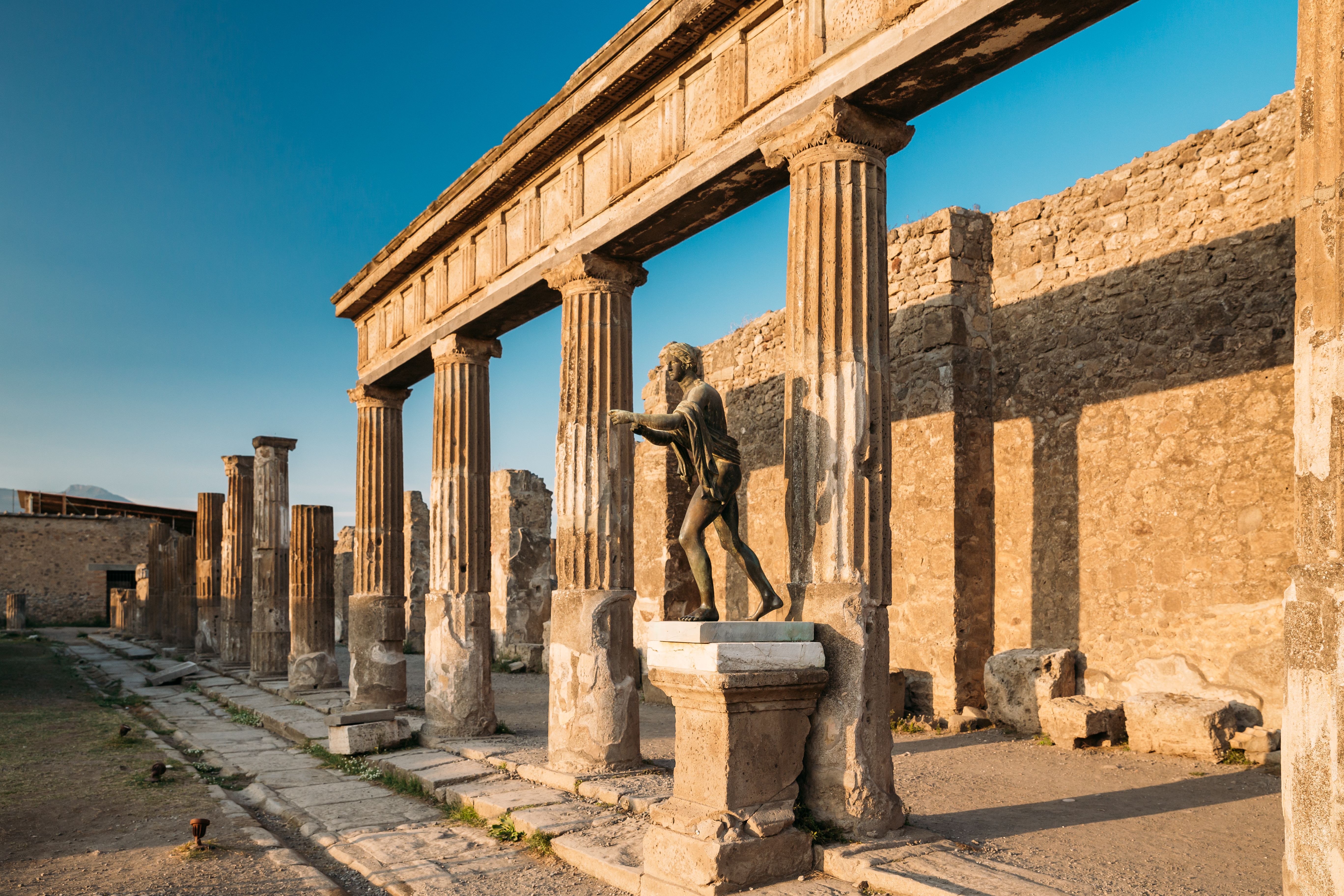
Peloponnese
Pompeii Guided Tours
Join our expert-led tours and uncover the secrets of this remarkable ancient city.
TRAVEL IN THE COMPANY OF AN ESTEEMED EXPERT:
All our tours that include visits to Pompeii are led by expert Guide Lecturers. Our roster of experts ranges from published authors to a specialist in ancient glass, and from an archaeologist who has excavated in Pompeii, to a Roman Empire specialist with a particular interest in Roman coinage.
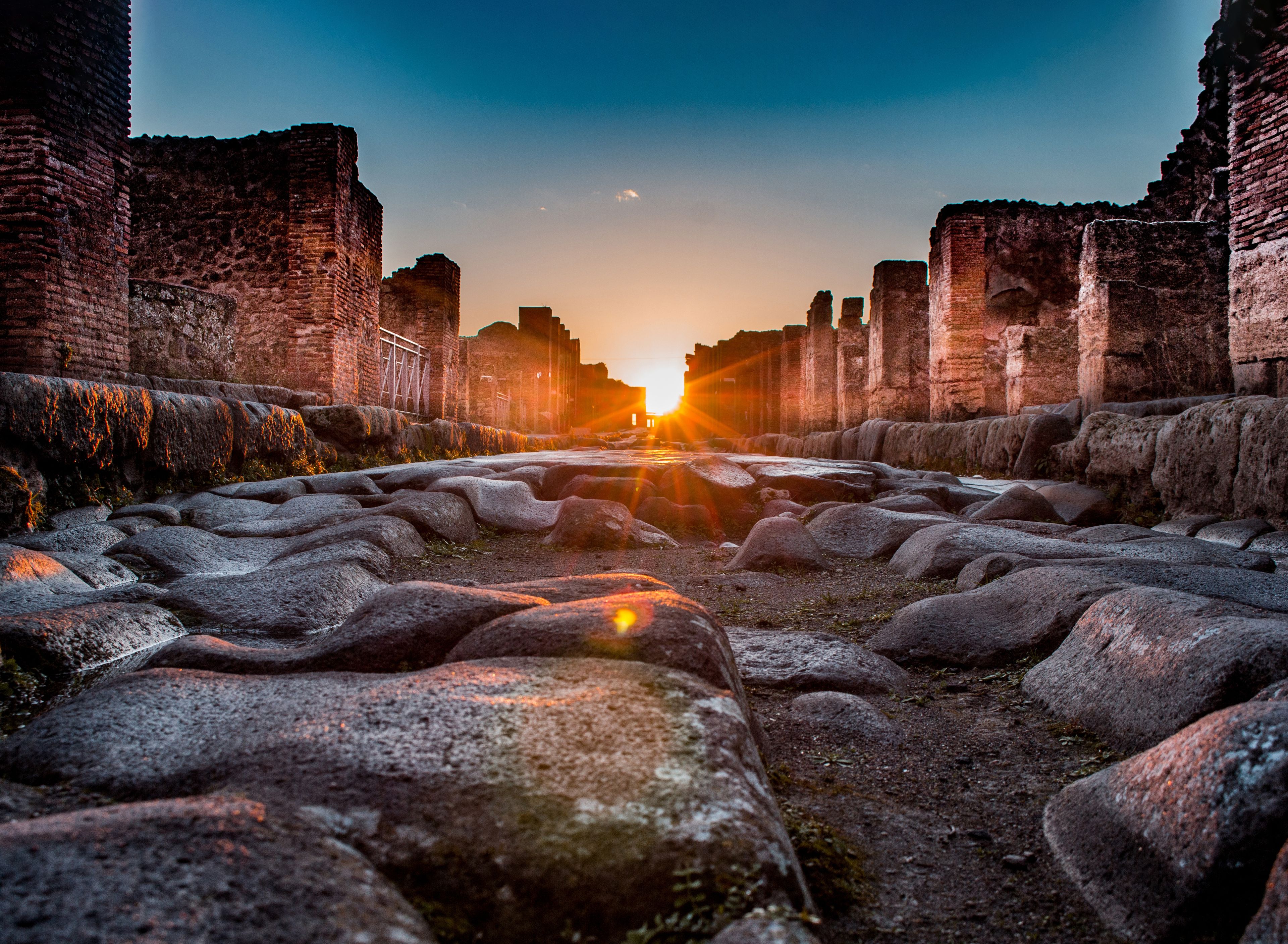
Popular Countries
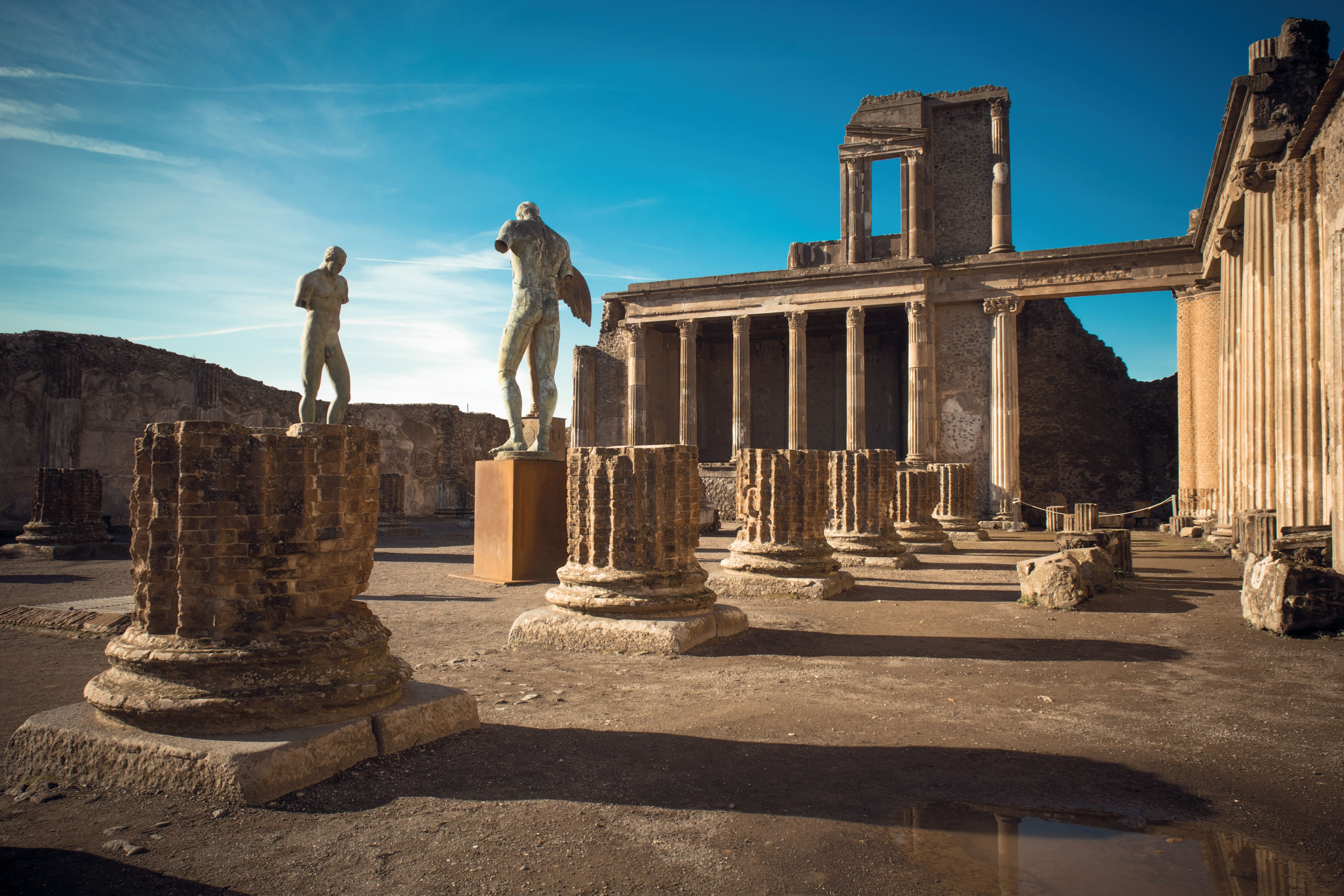
Tour Inspiration
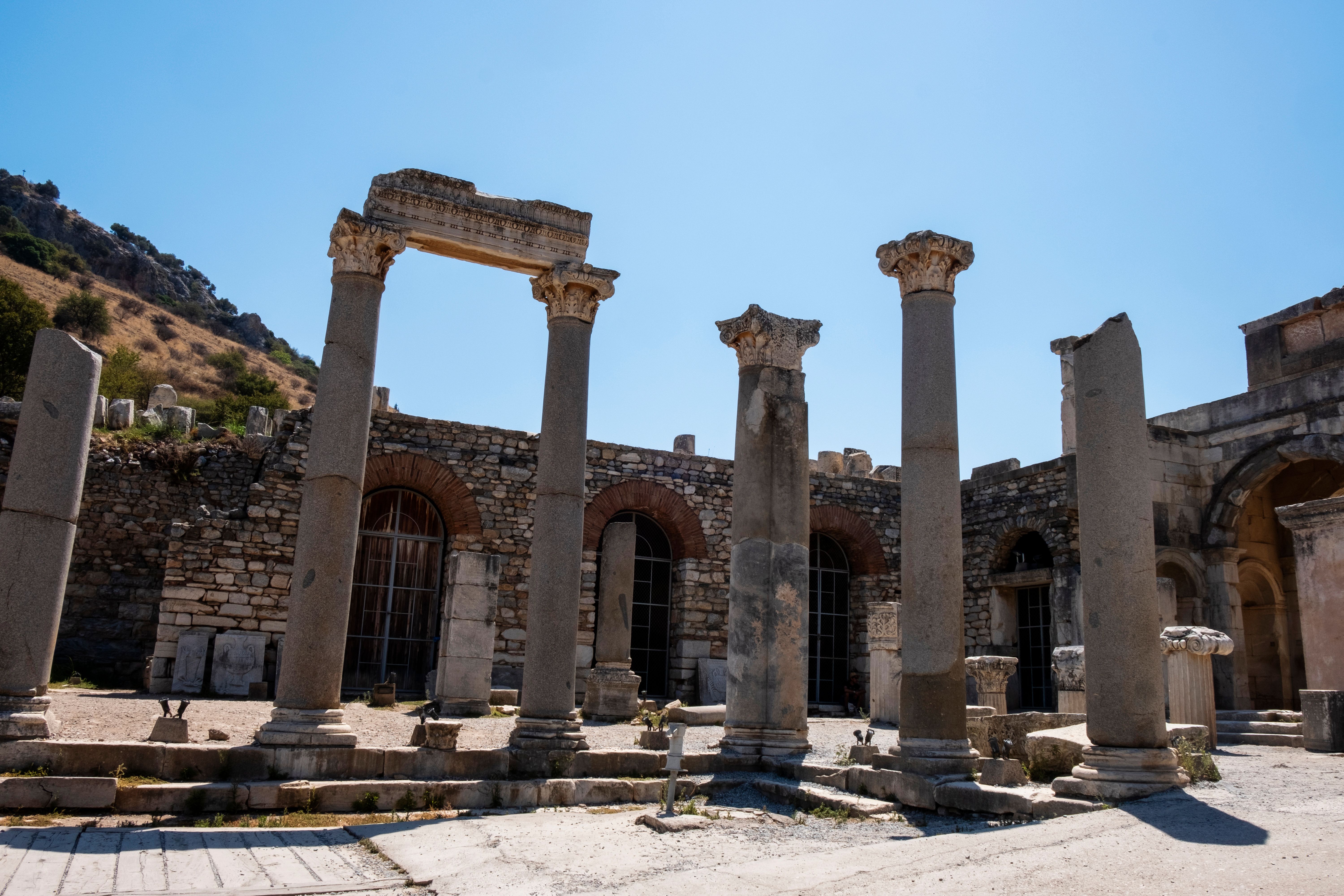
10 Things To Do In Europe If You Love Archaeology
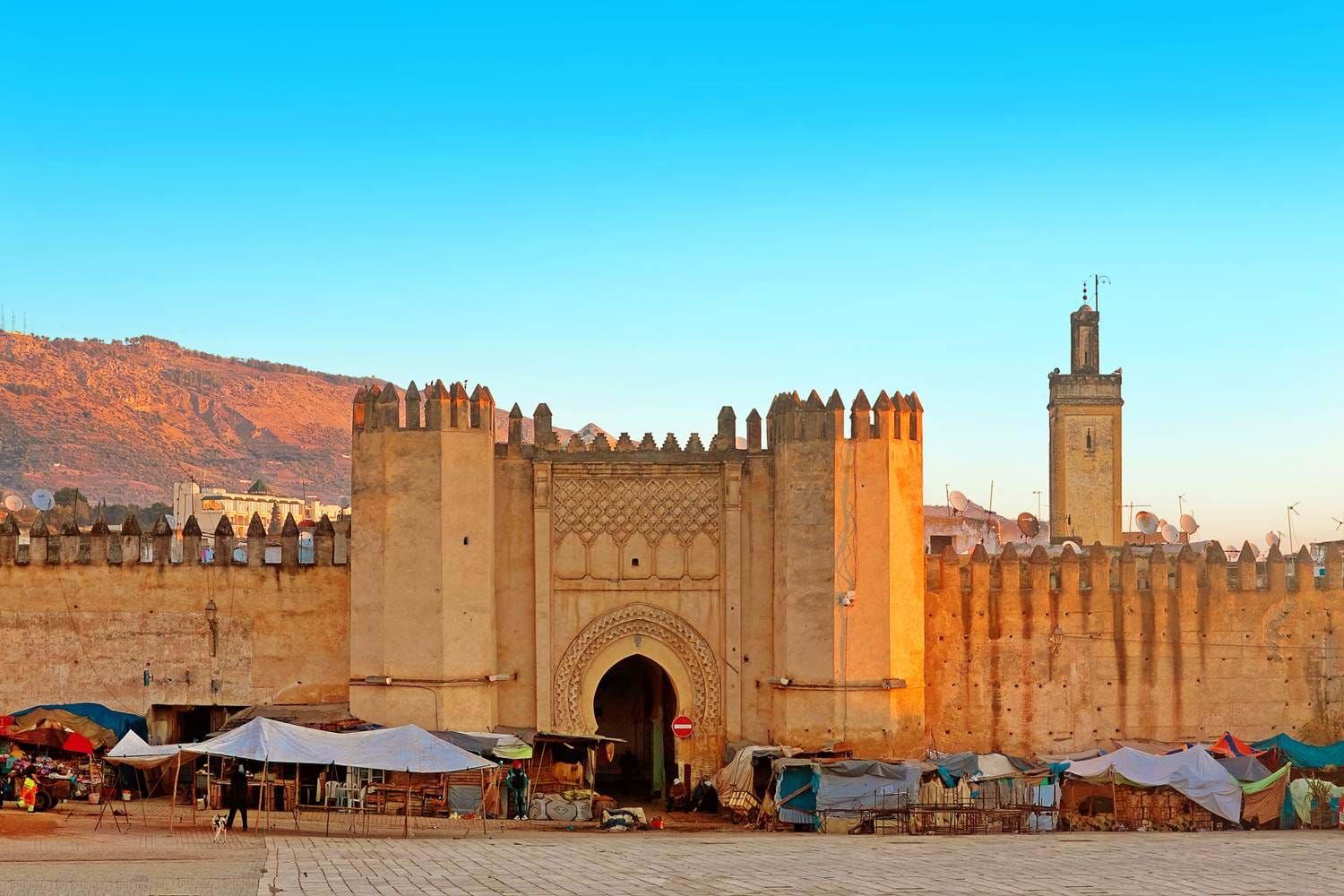
The Shared History of Morocco and Spain
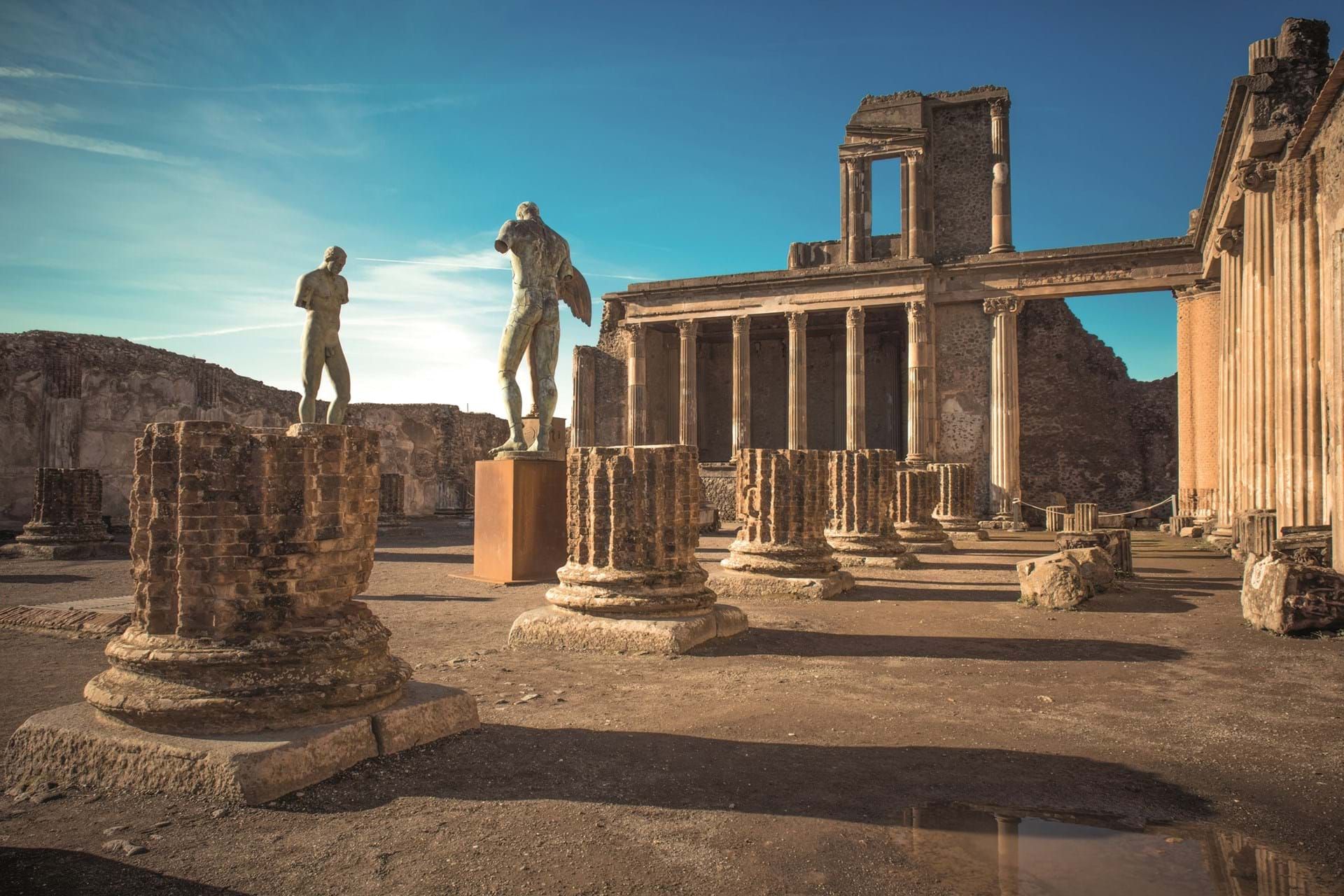
Everything you ever wanted to know about Pompeii
Popular tours, why choose andante, our awards and accolades.
The past year has been a tremendous one for us here at Andante. Not only did we win a Feefo 2023 Gold Trusted Service Award for excellence in customer service, but we also won a silver for the Best Travel Company to Italy/Western Mediterranean Islands. Plus of course, our very own John Shepherd won the Wanderlust World Guide Award – History & Culture 2023. Historically, we have also seen our tours included in National Geographic’s ‘Trips of a Lifetime’ feature. Here’s to continued success throughout the year!

Opt-in to our email newsletter and hear about new offers first – view our privacy policy for details.
This site is protected by reCAPTCHA and the Google Privacy Policy and Terms of Service apply.

Andante Travels is part of Specialist Journeys, an award winning UK-based tour operator.

Tour Enquiry
The team is available Monday to Friday from 8am – 6pm (GMT)
Call us: 646 802 1528
Ancient Greece

- 1.1 Greek heritage
- 2.1 Mainland Greece
- 2.2 Greek Islands
- 2.5 Bulgaria
- 2.6 Romania
- 2.8 Georgia
Ancient Greece or Classical Greece was a civilization which emerged around the 8th century BC, and was annexed by the Roman Empire in the second century BC. Ancient Greece is remembered for its architecture, philosophy and other ideas, which became the foundation of modern Europe . The Olympic Games are originally an ancient Greek tradition.
Classical Greece was not the first civilization around the Aegean Sea. Since the 27th century BC, the Minoan culture had flourished on Crete, until displaced by the Mycenaeans around the 16th century BC. They left behind plenty of artifacts, but the only legible written records known to posterity was the cryptic Linear B script.
The first written records from the Greek city-states, poleis , date to the 9th century BC. Among them are the Iliad and the Odyssey, two epic poems describing the Trojan War , supposedly fought in the 12th century BC, and part of the Greek foundation myth. The Graeco-Roman mythology is part of the oldest European literature, with a pantheon later adopted by the Roman Empire.
The period of the 5th and 4th centuries are today known as Classical Greece . During this period, the Greeks defended themselves against the mighty Persian Empire in a series of wars which became legendary in Western culture. Greece later entered a golden age for philosophy, drama, and science. Through colonization and conquest, Greek language and culture came to stretch far beyond the territory of modern Greece , with especially strong footprints in Sicily and across Asia Minor (today, the Asian part of Turkey ). In Ancient Greece's apogee, the dominant cities of Greece were Athens and Sparta , which often were at war against each other.
Starting with the conquests of Alexander the Great in the 4th century BC, the Greek culture spread as far east as modern-day Afghanistan, and Egypt was ruled for three centuries by the Greek Ptolemaic dynasty, which was founded by one of Alexander's generals. This late bloom of Greek culture, which was later partially supplanted by the Roman Empire , is known as the Hellenic era.
According to the Biblical book of Acts, the Apostle Paul traveled to the region in the 1st century AD and brought Christianity to the area.
Greek heritage
Some elements of Greek culture endured for centuries after the last Greek polity had disappeared. For instance Coptic, the language that Ancient Egyptian evolved into, was written in Greek-derived letters until it died out as a vernacular in the 17th century; Coptic still survives as a liturgical language for Egyptian Christians . Other examples include Greek authors and philosophers, such as Homer and Socrates, that were and are still widely read among a certain subset of Europeans. Greek terms have entered the general lexicon of many European languages including English, mostly relating to things the Greeks were known for (theatre, politics, democracy) or scientific terms. Sometimes Greek and Latin terms have been mixed, such as in the case of "automobile" which derives from Greek "autos" (~self) and Latin "mobilis" (~movable, moving). For these reasons and the fact that the Christian New Testament was written in Ancient Greek, Ancient Greek is still taught in many secondary schools and universities throughout Europe. The Roman Empire held Greek culture in high regard, particularly in the eastern parts, and Greek was a co-official language alongside Latin in the Roman Empire.
Although in modern times the Greek alphabet itself is only used to write Greek (and the individual letters as symbols in maths and science), the Latin and Cyrillic alphabets that are used by many other European languages were originally derived from the Greek alphabet. The very word "alphabet" is also derived from the first two letters of the Greek alphabet (alpha and beta) and its importance in being the first known phonetic script, a script to encode all vowel and consonant sounds (as opposed to other scripts that only encoded consonants or had ideographic and/or syllabic aspects), cannot be overstated.
The Byzantine Empire survived as a bastion of Greek heritage until it fell in 1453. Some Byzantine scholars moved west, and contributed to the Italian Renaissance . From the 17th century, the Grand Tour became a customary voyage where north Europeans visited the Greek ruins in southern Italy. Over time, tourism expanded to Greece proper.
Greece became independent from the Ottoman Empire in the 1820s, adopting a monarchical constitution largely on the urging of the Great Powers of Europe, and initially enthroning a Bavarian Wittelsbach prince, hence the – still used – blue and white colors of the Greek flag.
Destinations
The Seven Wonders of the Ancient World were listed in some of the earliest guides for travellers, written in Greek a few centuries BCE.
Mainland Greece

- 37.9667 23.7167 1 Athens ( Attica ). One of the most important poleis in Ancient Greece, Athens was a naval power and a center of learning and philosophy. While it was eventually surpassed militarily by Sparta and Thebes, its immense wealth meant that some of its classical architecture is still standing. Due in part to its history Athens later became the capital of modern Greece.
- 37.6167 22.7167 2 Argos ( Peloponnese ). Major stronghold during the Mycenaean era, this city may be older than Mycenae itself. In classical times was a powerful rival of Sparta for dominance over the Peloponnese. Nowadays, there are still several interesting remains, among them a ruined temple to goddess Hera. ( updated Feb 2016 )
- 39.15863 20.98764 3 Arta ( Epirus ). Historic capital of Epirus, famously associated with King Pyrrhus, opponent of the Roman Republic, after whom the phrase "Pyrrhic victory" was coined. There's an extensive archeological site, with ancient walls, the ruins of a temple of Apollo, a small theatre, among other things. ( updated Feb 2016 )
- 37.9333 22.9333 4 Corinth ( Peloponnese ). One of the largest and most important cities of Classical Greece, with a population of 90,000 in 400 BC. In classical times and earlier, Corinth had a temple of Aphrodite and rivaled Athens and Thebes in wealth. ( updated Sep 2015 )
- 38.483333 22.5 5 Delphi ( Sterea Hellada ). Famously nested on a shoulder of Mount Parnassus, Delphi was believed to be determined by Zeus when he sought to find the omphalos (navel) of his "Grandmother Earth" (Ge, Gaea, or Gaia). Site of the Apollo cult, oracle, and eternal flame. ( updated Jun 2015 )
- 39.546415 20.788211 6 Dodona ( about 6 km southwest of Ioannina , Epirus ). The oldest recorded Hellenic oracle. There's a well preserved theater, built by King Pyrrhus, a must-see, which hosts theatrical performances. ( updated Feb 2016 )
- 39.641667 22.416667 7 Larissa ( Thessaly ). Historic Thessalian capital; the name means "stronghold" in ancient Greek. One of the oldest settlements in Greece, with artifacts uncovered dating at least the Neolithic period (6000 BC) and two ancient theaters, one Greek, the other Roman. ( updated Feb 2016 )
- 40.085556 22.358611 8 Mount Olympos ( Thessaly ). The highest mountain in Greece (2917 m), the abode of the Gods. ( updated Feb 2016 )
- 38.15 23.95 9 Marathon ( Attica ). Site of the famous battle against the Persians, 490 BC, and starting point of the First modern Olympiad's eponymous foot race, 1896. ( updated Feb 2016 )
- 37.730833 22.75611 10 Mycenae ( Peloponnese ). Royal seat of Agamemnon, High King of the Greeks and undisputed leader of the anti-Trojan coalition, according to the Iliad . Its prominence from about 1600 BC to about 1100 BC was such that it lends its name to this period of Greek history, habitually referred to as "Mycenaean". Its acropolis, continuously inhabited from the Early Neolithic onwards, in Roman times had already become a tourist attraction.
- 37.566667 22.8 11 Nafplio ( Peloponnese ). Said to have been founded by and named after the Argonaut Nauplios, father of Palamidis who fought in the Trojan War, this town is a good base to head out to the numerous archeological sites surrounding it. UNESCO World Heritage sites Epidaurus with its gorgeous theater, Tiryns the Mighty-Walled (Homer's words), and Mycenae are just some of them. ( updated Feb 2016 )
- 37.638 21.63 12 Olympia ( Peloponnese ). Site of the original Olympic Games and the Temple of Zeus. Hosted the shot put event in the 2004 Olympic Games - the very first time women athletes competed in the venue.
- 37.952 23.6358 13 Piraeus ( Attica ). Athenian harbor from time immemorial, still is the Greek capital's chief point of entry and exit by sea. There's a nice archeological museum here. ( updated Feb 2016 )
- 40.754669 22.52105 14 Pella ( Central Macedonia ). Alexander the Great 's Macedonian capital and birthplace. In 168 BC, it was sacked by the Romans, and its treasury transported to Rome. Nowadays it's a rich archeological site. ( updated Feb 2016 )
- 36.916667 21.7 15 Pylos ( Peloponnese ). The "Sandy Pylos" mentioned very often in both the Iliad and the Odyssey , home to King Nestor, eldest of Agamemnon's advisers. The remains of the so-called "Palace of Nestor" have been excavated nearby. ( updated Feb 2016 )
- 37.081944 22.423611 16 Sparta ( Peloponnese ). Even contemporaries agreed, that Athens would be perceived to have been much more important than Sparta. This is mostly because the Spartan society was very militaristic and invested in war rather than monuments or temples. A famous quote sums up the Spartan attitude towards building, even if for war: "Sparta has no walls. The Spartans are the wall of Sparta"
- 38.316667 23.316667 17 Thebes ( Central Greece ). From time immemorial, this city is featured in an abundant mass of legends which rival the myths of Troy. In Classical times, it was largest city of the ancient region of Boeotia, the leader of the Boeotian confederacy, and a major rival of Athens. It sided with the Persians during the 480 BC invasion, and formed a firm alliance with Sparta during the Peloponnesian War (431–404 BC). The modern city contains an archaeological museum, the remains of the Cadmea pre-Mycenaean citadel, and scattered ancient remains. ( updated Feb 2016 )
- 38.805278 22.562778 18 Thermopylae ( Central Greece ). The battlefield where King Leonidas and his 300 Lacedaemonians made their stand against the Persian army, immortalized in song, prose, comics and movies, in 480 BC. Today it's bisected by a highway, and right beside it, are the Spartans' burial mound, with a plaque containing the famous epitaph by Simonides: Ὦ ξεῖν', ἀγγέλλειν Λακεδαιμονίοις ὅτι τῇδε κείμεθα, τοῖς κείνων ῥήμασι πειθόμενοι. ("Go tell the Spartans, passerby, that here, obedient to their laws, we lie.") and a statue of Leonidas, under which an inscription reads laconically: Μολὼν λαβέ ("Come and take them!" — his answer to Xerxes' demand that the Greeks give up their weapons). ( updated Feb 2016 )
- 39.3667 22.9333 19 Volos ( Thessaly ). Identified with Iolkos , the alleged birthplace of mythical hero Jason, leader of the Argonauts. Features several archeological sites nearby. ( updated Feb 2016 )
Greek Islands
- 37.74 23.44 20 Aegina . The famous Aegina Treasure (between 1700 and 1500 BC), now in the British Museum, came from this island. There stand the remains of three Greek temples. ( updated Feb 2016 )
- 39.583333 19.866667 21 Corfu ( Corcyra, Korkyra ). An island bound up with the history of Greece from the beginnings of Greek mythology. Famous sights, like the cave where Jason and Medea were married ( Argonautica ), or the beach where Ulysses met Nausicaa ( Odyssey ), remain very popular tourist attractions. ( updated Feb 2016 )
- 37.393333 25.271111 22 Delos . This island, the alleged birthplace of Apollo and Artemis, was already a holy sanctuary for a millennium before the establishment of this piece of Olympian Greek mythology; a very significant archaeological site. ( updated Jun 2015 )
- 35.333 25.1333 23 Heraklion ( Crete ). Known in ancient times as Knossos ; the ceremonial and political centre of the Minoan civilization and culture (3650 to 1400 BC).
- 36.89476 27.29093 24 Kos . Famously associated with native-born physician Hippocrates of Kos, the "Father of Western Medicine". Major historic attractions include the Asklepeion sanctuary, where he most probably studied, and the Platanus tree under which he taught his pupils the art of medicine. ( updated Feb 2016 )
- 36.0833 28.0833 25 Lindos ( Rhodes ). Beautiful hilltop town with a nice acropolis archeological site. ( updated Feb 2016 )
- 39.1 26.55 26 Mytilene ( Lesbos ). The historic capital of Lesbos island was briefly the home of master philosopher Aristotle. The island was also the home of Sappho, who is famous for her poetry with homoerotic features, which gave rise to the term 'lesbian' after the island's name. Nowadays, there is more than one archeological museum worth visiting. ( updated Feb 2016 )
- 37.05 25.483333 27 Naxos . Herodotus describes Naxos circa 500 BC as the most prosperous of all the Greek islands. According to Greek mythology, the young Zeus was raised in Mt. Zas's cave. Besides some nice ruined temples to Apollo and Demeter, the island is considered as perfect for windsurfing, as well as kitesurfing. ( updated Feb 2016 )
- 37.75 26.8333 28 Samos . Birthplace of Pythagoras, the famous mathematician. Features the remains of a once-famous sanctuary to goddess Hera.
- 40.4833 25.5167 29 Samothrace . Site of the Sanctuary of the Great Gods , the centre of a mystery cult that rivaled Delos and Delphi. Here was unearthed the Victory of Samothrace statue, a highlight of the Louvre.
- 37.316667 13.583333 30 Agrigento ( Sicily ). Site of the ancient Greek city of Akragas (Ἀκράγας), famous for its seven monumental Greek temples in the Doric style, constructed during the 6th and 5th centuries BC. Now excavated and partially restored, they constitute some of the largest and best-preserved ancient Greek buildings outside of Greece itself. ( updated Sep 2015 )
- 40.633333 17.933333 31 Brindisi ( Apulia ). Allegedly founded by King Diomedes of Argos, after he lost his route back home from the siege of Troy. Its name comes from the Greek Brentesion (Βρεντήσιον) meaning "deer's head", which refers to the shape of its natural harbor. Some columns, most likely from the Roman period, still stand. ( updated Sep 2015 )
- 40.848611 14.053611 32 Cumae ( Campania ). Kumai (Κύμαι) was the first Greek colony on the mainland of Italy, founded by settlers from Euboea, allegedly led by the legendary gadget-maker Daedalus, in the 8th century BC. It's most famous as the seat of the Cumaean Sibyl, a priestess of Apollo with prophetic powers, very respected and consulted among the Romans. Her sanctuary is open to visitors. ( updated Feb 2016 )
- 38.036944 12.586389 33 Erice ( Sicily ). Ancient Eryx (Eρυξ) is today a gorgeous hilltop destination, where less than 500 people live close to a mediaeval fortification ("Venus Castle", built on the foundations of a temple to Aphrodite) on top of the 715 m high Mount Eryx. Local tradition places the lair of cyclops Polyphemus, Ulysses' foe in the Odyssey , on the side of this mountain. The town itself has wonderful views. There's a cable car that comes up from Trapani to the hilltop. ( updated Feb 2016 )
- 37.0667 14.25 34 Gela ( Sicily ). founded around 688 BC by colonists from Rhodes and Crete; playwright Aeschylos, the "father of tragedy", died in this city in 456 BC.
- 40.419667 15.005028 35 Paestum ( Campania ). Widely considered to have the best and most extensive ancient Greek relics in the former Magna Graecia. ( updated Sep 2015 )
- 38.111389 15.661944 36 Reggio di Calabria ( Calabria ). A Greek colony at first, under the name Rhégion (Ῥήγιον, "Cape of the King"), Reggio is home to the National Archaeological Museum of Magna Græcia, one of the most important archaeological museums of Italy. ( updated Sep 2015 )
- 37.9333 12.8333 37 Segesta ( Sicily ). Said to have been founded by Trojan refugees, welcomed by the Elymians, right after the end of the Trojan War, Segesta is home to a beautiful Greek theater and an unusually well preserved Doric temple. ( updated Feb 2016 )
- 37.5833 12.8167 38 Selinunte ( Sicily ). Its Greek name was Selinous (Σελινοῦς). Features an extensive acropolis archeological site with several temples, one of which has been reconstructed. ( updated Feb 2016 )
- 37.0833 15.2833 39 Syracuse ( Sicily ). Famously besieged by an Athenian expedition (415-413 BC) during the Peloponnesian War. The siege was a failure and spelled the doom of the Athenian hegemony over the Greek world. It's also the birthplace of Archimedes, the famous philosopher and mathematician.
- 40.466667 17.233333 40 Taranto ( Apulia ). Taras (Τάρας) was founded as a Spartan colony. The modern city has been built over the Greek city; a few ruins remain, including part of the city wall, two temple columns dating to the 6th century BC, and tombs. ( updated Feb 2016 )
- 38.016667 12.516667 41 Trapani ( Sicily ). Founded as early as the 13th century BC, as Drepanon (Δρέπανον), by the same Greeks who called themselves the Elymian people and also founded Erice and Segesta. Recent scholarship formulates the hypothesis that princess Nausicaa, a highlighted character of the Odyssey , is the real author of the epic poem, and was born and raised in Drepanon - refer to Homeric translator Samuel Butler's The Authoress of the Odyssey and novelist Robert Graves' Homer's Daughter for further details. ( updated Feb 2016 )
- 37.708333 28.723611 42 Aphrodisias ( Southern Aegean ). Site of the Temple of Aphrodite. Now it's one of the best preserved ancient cities in Turkey, and without the usual crowds of Ephesus. ( updated Sep 2015 )
- 39.487778 26.336944 43 Assos ( Northern Aegean ). The Doric order columns of the hilltop Temple of Athena here are the only one of this type on the Asian mainland. Assos was also the site of the academy established by philosopher Aristotle. ( updated Oct 2015 )
- 39.1167 27.1833 44 Bergama ( Northern Aegean ). The UNESCO-listed Pergamon was once the capital of the Kingdom of Pergamon, ruled by a Hellenistic dynasty and held sway over most of western Anatolia. The ruins of Pergamon are among the most popular archaeological sites in Turkey, and there is much to see in two separate areas — although the impressive altar was taken to Germany in the late 19th century, and is now in display in the Pergamon Museum in Berlin . ( updated Oct 2015 )
- 39.2 29.61 45 Çavdarhisar ( Central Anatolia ). Features the impressive ruins of Aizanoi , site of the awesome Temple of Zeus . ( updated Sep 2015 )
- 37.385 27.2565 46 Didyma ( Southern Aegean ). The sanctuary of the then great city of Miletus was once the site of an oracle that was as renowned as that of Delphi. Go there to see the ruins of the colossal Temple of Apollon, adorned with much ancient Greek art. ( updated Oct 2015 )
- 37.939139 27.34075 47 Ephesus ( Central Aegean ). A famous and prosperous polis in Classical times, birthplace of philosopher Heraclitus, now a large world heritage-listed archeological site and one of Turkey's major tourist attractions. ( updated Sep 2015 )
- 38.6667 26.7667 48 Foça ( Central Aegean ). Phocaea was the home of the sailors who ploughed the waves in the far-flung areas of the Western Mediterranean, founding a number of colonies along the coasts of Iberia, Italy, and France, Marseille being one of them. Some believe the offshore islands were the domain of the Sirens, beautiful sea fairies who doomed the sailors to death, found in Homer's Odyssey along with other Greek stories - actually, there was a huge colony of Mediterranean monk seals ( Monachus monachus ) — after which, known as fokia in Greek and fok in Turkish, the town was named in the first place; the seals may or may not have been cofused with sirens. Nowadays the seals are nearly extinct, and only scant ruins of Phocaea exist on a hillside some distance away from the modern town. However, the cobbled streets of Foça are lined by Greek civic architecture of the 19th century throughout the town. ( updated Sep 2016 )
- 39.5356 26.1183 49 Gülpınar ( north of Babakale , Northern Aegean ). The site of the lonely ruins of the Temple of Apollon Smintheion, the major sacred site of the Troad Peninsula extending south of Troy. ( updated Oct 2015 )
- 38.419 27.139 50 Izmir ( Central Aegean ). Ancient Smyrna has always been famous as the birthplace of Homer, thought to have lived here around the 8th century BC. Its agora (central market place) is now an open-air museum. ( updated Sep 2015 )
- 36.6863 27.3742 51 Knidos ( Southern Aegean ). This was the site of the Aphrodite of Knidos , a statue depicting a nude goddess of love created in the 4th century BC, which became so famous that it sparked one of the earliest forms of tourism in the classical world. Nowadays Knidos doesn't have as many visitors, as it lies at the end of a remote peninsula and had its statue long since lost to oblivion. ( updated Oct 2015 )
- 37.5312 27.2792 52 Miletus ( Southern Aegean ). Considered to be the largest and the wealthiest of the Greek cities prior to the Persian invasion of the 6th century BC, Miletus is also the birthplace of mathematician and philosopher Thales. ( updated Oct 2015 )
- 36.5242 30.552 53 Phaselis ( south of Kemer , Lycia ). Once the major harbor of the region, the ruins of Phaselis overgrown by a pine forest are now the destination of many daily cruises departing from the nearby resort towns. ( updated Feb 2016 )
- 37.659 27.2981 54 Priene ( Southern Aegean ). The earliest city built on a grid plan, Priene was once a major harbor on the Ionian coast. Its hillside ruins now overlook a fertile plain, formed by the silting up of its harbor by the Meander River in the meantime. ( updated Oct 2015 )
- 42.0333 35.15 55 Sinop ( Black Sea Turkey ). Σινώπη (Sinōpē), where an important stopover on the Argonauts' journey to Colchis took place, is also the birthplace of king Mithridates VI Eupator of Pontus and seminal philosopher Diogenes the Cynic. ( updated Oct 2015 )
- 36.9825 30.464722 56 Termessos ( Pamphylia ). One of the best preserved of the ancient cities of Turkey, 1,665 m (5,463 ft) above sea level among the surrounding travertine mountains of Antalya. Alexander the Great besieged it in 333 BC; he likened the city to an eagle's nest, and in one of few cases, failed to conquer it. ( updated Jan 2021 )
- 41 39.733333 57 Trabzon ( Black Sea Turkey ). Τραπεζοῦς (Trapezous) was the first Greek city reached by Xenophon and the Ten Thousand mercenaries, when fighting their way out of Persia, as described in the Anabasis . Most of the city's defense walls and a few towers remain standing. ( updated Oct 2015 )
- 42.5 27.466667 60 Burgas ( Bulgarian Black Sea Coast ). The present city's territory features the Aquae Calidae hot springs, already used in the Neolithic between the 6th and 5th millennium BC. In the 4th century BC, Philip II of Macedon conquered the region and, according to legend, he was a frequent guest here. ( updated Oct 2015 )
- 42.65 27.7333 61 Nesebar ( Bulgarian Black Sea Coast ). Founded as a Greek colony, the ancient city of Mesembria was located on a former island, which has sunk under water. However, some remains from the Hellenistic period are extant, including the acropolis, a temple of Apollo, a market place, and a fortification wall, which can still be seen on the north side of the peninsula. ( updated Oct 2015 )
- 42.15 24.75 62 Plovdiv ( Upper Thracian Plain ). Ancient Philippopolis was the historic capital of Thracia. Several ruins can be seen in or near the downtown area, including an aqueduct and a very well preserved theater. ( updated Sep 2015 )
- 42.4167 27.7 63 Sozopol ( Bulgarian Black Sea Coast ). Anciently known as Apollonia Pontica (that is, "Apollonia on the Black Sea", the ancient Pontus Euxinus) and Apollonia Magna ("Great Apollonia"), founded in the 7th century BC by colonists from Miletus. A part of the ancient seaside fortifications, including a gate, have been preserved, along with an amphitheater. ( updated Oct 2015 )
- 43.2167 27.9167 64 Varna ( Bulgarian Black Sea Coast ). Started to exist as a Greek colony named Odessos (Ὀδησσός). Home to the remains of a large bathing complex, and an archeological museum. ( updated Aug 2015 )
- 44.172997 28.658287 65 Constanța ( Northern Dobruja ). Originally a Greek colony, named Tomis . ( updated Aug 2015 )
- 43.817222 28.582778 66 Mangalia ( Northern Dobruja ). Started to exist as a Greek colony named Callatis in the 6th century BC. Today, it's a rich archeological site, with ruins of the original Callatis citadel and an archeological museum. ( updated Oct 2015 )
- 44.61054 33.48899 67 Chersonesus Taurica ( "Taurica" stands for the Crimean Peninsula ) ( Sevastopol , about 3 km from the city centre ). Χερσόνησος was founded by settlers from Heraclea Pontica in Bithynia in the 6th century BC. On the site are various Byzantine basilicas, including a famous one with marble columns. It's listed as a UNESCO World Heritage Site .
- 41.638611 41.637222 71 Batumi . This was the Greek colony of Bathys in the land of Colchis, the final destination of Jason and his Argonauts in their pursuit of the "Golden Fleece" around Pontos Axeinos , "the inhospitable sea". While not much remains of Bathys, in 2007 the city has erected a large statue in honour of Medea, mythical Colchian princess and the wife of Jason, depicting her while holding what appears to be the Golden Fleece. ( updated Jan 2016 )
- 42.2774 42.7043 72 Kutaisi . Identified as Aea , King Aeëtes' capital in Colchis, from whence the Golden Fleece was seized. Nearby, the so-called Prometheus's Cave is reported to have amazing stalactites. ( updated Feb 2016 )
- 34.7667 32.4167 73 Paphos . Renowned in antiquity as the birthplace of Aphrodite, the goddess of love. A few miles outside the city, the rock of Aphrodite ( Petra tou Romiou , "Stone of the Greek") emerges from the sea. According to legend, Aphrodite rose from the waves in this strikingly beautiful spot.
- 31.19929 29.90925 74 Alexandria . Egyptian capital until the Islamic conquest, the best known of several towns founded by and named for Alexander the Great , nicknamed by him "my window on Greece". A center of learning in antiquity as well as the seat of the Ptolemaic dynasty.
- 32.827778 21.862222 75 Cyrene . Ancient Cyrene was the oldest, largest and the most important of the five Greek cities (" pentapolis ") of the greater Cyrenaica region. Prospered with the trade of its rich agricultural products, the city became one of the most influential centres of ancient Greek culture and art, gave rise to the hedonistic "Cyrenaics" movement, and was nicknamed the "Athens of Africa". Ruins of several temples dedicated to the Greek gods dot the site.
- Ancient Egypt
- Persian Empire
- Wonders of the Ancient World
- Has custom banner
- Has mapframe
- Maps with non-default size
- Has map markers
- European history
- Topic articles
- Usable topics
- Usable articles
- Pages with maps
Navigation menu
S panning one-ninth of the earth's circumference across three continents, the Roman Empire ruled a quarter of humanity through complex networks of political power, military domination and economic exchange. These extensive connections were sustained by premodern transportation and communication technologies that relied on energy generated by human and animal bodies, winds, and currents.
Conventional maps that represent this world as it appears from space signally fail to capture the severe environmental constraints that governed the flows of people, goods and information. Cost, rather than distance, is the principal determinant of connectivity.
For the first time, ORBIS allows us to express Roman communication costs in terms of both time and expense. By simulating movement along the principal routes of the Roman road network, the main navigable rivers, and hundreds of sea routes in the Mediterranean, Black Sea and coastal Atlantic, this interactive model reconstructs the duration and financial cost of travel in antiquity.
Taking account of seasonal variation and accommodating a wide range of modes and means of transport, ORBIS reveals the true shape of the Roman world and provides a unique resource for our understanding of premodern history.
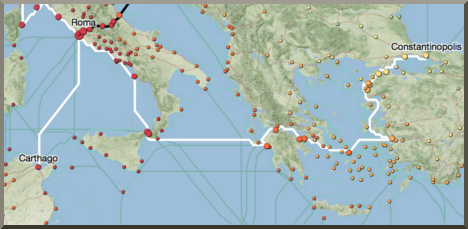
In the aggregate, our model simulations make it possible to reconfigure conventional maps of the Roman Empire to express the relative cost of transfers from or to a central point as distance. This perspective captures the structural properties of the imperial system as a whole by identifying the relative position of particular elements of the network and illustrating the impact of travel speed and especially transport prices on overall connectivity. Distance cartograms show that due to massive cost differences between aquatic and terrestrial modes of transport, peripheries were far more remote from the center in terms of price than in terms of time.

A comma-separated date file. You can:
'Open with...' a spreadsheet program or text editor, or Choose 'Save as...' and rename with and extention of '.csv' -- for example, routes01.csv

Sign Up Today
Start your 14 day free trial today

The History Hit Miscellany of Facts, Figures and Fascinating Finds
15 Amazing Ancient Cities to Visit in the World
Discover ancient history: these 15 metropolises, from the ruins of pompeii to the mountainous machu picchu, are must-visit relics of the ancient world..

Harry Sherrin
24 sep 2021.
The ancient world was rich with complex civilisations, sprawling metropolises and diverse cultures. Countless cities built in the ancient era, between roughly 3000 BC to 500 AD, still stand – albeit in varying states of preservation.
From the remains of the ancient city of Babylon to lost Roman metropolises, Mayan centres and grand Egyptian settlements, the ancient cities of the world are as varied as they are numerous.
Here are 15 of the most amazing ancient cities to visit.

1. Angkor Wat
Angkor Wat is an enormous 12th-century temple complex in Cambodia and the best preserved of its kind. Incredibly grand and ornately decorated, Angkor Wat’s sand-coloured buildings rise up to form five towers, representing the home of the Hindu deities. Friezes and sculptures are found throughout, depicting both day-to-day life from the time it was built and religious events.
Today, Angkor Wat is one of Cambodia’s most popular tourist sites. There is an incredible amount to see and it’s a good idea to get a licensed tour guide. Angkor Wat has been a UNESCO World Heritage site since 1992.

2. Machu Picchu
Machu Picchu is an extraordinary ancient stone city along the Inca Trail in Peru. Believed to have been constructed by the Inca Yupanqui people sometime during the mid-15th century, the ruins of Machu Picchu sit high atop a granite mountain. Some of the most impressive structures include the semi-circular Temple of the Sun, the Temple of the Three Windows, the mausoleum and the upper cemetery.
The main Machu Picchu city is surrounded by other sites forming the Inca Trail and some of which take some serious hiking, but are well worth it. It’s also a good idea to stop at the Museo de Sitio Manuel Chávez Ballón at the base of the mountain.

Ephesus is a treasure trove for enthusiasts of Ancient Roman and Greek history, allowing them to walk through its streets and view its magnificent houses, community buildings, temples and stadiums. Some of the most impressive sites include the Library of Celsus, the ruins of which stand two storeys high, the Temple of Hadrian and the Cave of the Seven Sleepers.
A trip to Ephesus usually takes at least half a day – some tours include other local sites such as Priene and Miletus – but history enthusiasts will probably want to enjoy this site for a whole day. There is also a great Ephesus Museum displaying artefacts found in the old city.

4. Abu Simbel
Abu Simbel is an archaeological site in Egypt housing a series of incredible Ancient Egyptian monuments, especially a number of rock temples. The most famous sites at Abu Simbel are the two Temples of Ramesses II. The site was rediscovered in 1813. One of the most startling sights at Abu Simbel is the main hall of the Great Temple.
Incredibly, the temples at Abu Simbel were once located elsewhere, but were moved – with the help of UNESCO – to their current location in order to protect them from flooding. The place they once stood is now under water.

5. Teotihuacan
Teotihuacan was a holy Mesoamerican city built in around 400 BC in what is now Mexico and forms one of the country’s oldest archeological sites. Characterised by looming stepped pyramids, indeed one of the most impressive aspects of Teotihuacan is the sheer size of these monuments, including the Pyramid of the Sun, which rises 75 metres high. Incredibly well-preserved, Teotihuacan is a UNESCO World Heritage Site.
Today, Teotihuacan is one of the most popular tourist sites in Mexico and includes numerous museums, including the Museo del Sitio, just south of the Pyramid of the Sun where visitors can see various artefacts from the site. Visitors to Teotihuacan can manoeuvre their way through the city via its original streets, although take note that the site is enormous.

Jerash is one of the world’s best preserved ancient Roman sites. Today, tourists flock to see Jerash’s extensive and impressive ruins, including the Temple of Artemis and the Forum with its large ionic columns. Jerash’s original main street, the Cardo, runs through the centre of the site and, with its visible chariot marks and underground drainage system, is fascinating in its own right.
Other must-see aspects of Jerash include its still-functioning 3,000 seat South Theatre, its 2nd century AD North Theatre and its Nymphaeum fountain. Visitors can also see many of the artefacts found during the excavation of the site at the Jerash Archeological Museum.

7. Carthage
Carthage was one of the most powerful cities of the ancient world and spawned the powerful Carthaginian Empire which dominated much of the western Mediterranean. The ruins of this famed city can be found on the outskirts of modern day Tunis.
The best way to begin exploring these ruins is probably by visiting Byrsa Hill and the Carthage Museum . The museum hosts a collection of Carthaginian and Roman artefacts including marble sarcophagi and a model of Punic Carthage. Other key points of interest include the impressive Antonine Baths , the Roman Amphitheater , Roman villas and reconstructed Roman theatre of Carthage .

8. Chichen Itza
Stunningly well-preserved and imposingly beautiful, Chichen Itza is one of Mexico’s most impressive historical sites. A UNESCO World Heritage site based in the forests of the Yucatan Peninsula, Chichen Itza is actually made up of two cities built by two peoples, the Mayas and the Toltecs.
The site is made up of several surviving buildings including the Warriors’ Temple, El Castillo and a circular observatory known as El Caracol. Accounts vary as to the date of the first settlement at Chichen Itza, placing it between the 6th and 9th century AD when the Mayas built the original city.

One of the best known ancient sites in the world, Pompeii was an ancient Roman city founded in the 6th to 7th century BC. Famously, it was destroyed by the eruption of the volcano Mount Vesuvius in 79 AD. The people of Pompeii were completely unprepared for this disaster and its impact, which covered Pompeii in 6-7 metres of ash.
Today, Pompeii is one of the world’s most famous archeological sites. It is a ghost town filled with the bodies of its tragic citizens, many of whom died from asphyxiation and who were preserved by the ash and cinders which buried them.

10. Mesa Verde
Mesa Verde National Park or ‘green table’ national park is a breathtaking Native American site dotted with over 4,000 archaeological treasures, including 600 exceptionally well preserved cliff dwellings dating back to 600 AD. Mesa Verde National Park was once the home of the Pueblos, a Native American people who lived there for over 700 years before migrating to New Mexico and Arizona.
Some of the sites, such as the Cliff Palace and Balcony House with its over 150 rooms can only be viewed as part of a ranger tour, for which you can buy tickets at Far View Visitor Centre before attending the sites. It’s also well worth viewing the large collection of artefacts on display.

11. Herculaneum
Herculaneum was a port town established by the ancient Romans in what is now modern Ercolano, Italy. At its peak, Herculaneum would have had around 4,000 citizens and served as a holiday town for wealthy Campanians and Romans.
Like nearby Pompeii, Herculaneum was engulfed by the lava and mud which spewed from the eruption of Mount Vesuvius in 79 AD and, as a result, much of the town was preserved throughout the centuries. Herculaneum arguably withstood the natural disaster better than Pompeii with many of its upper floors still being intact. This, combined with the fact that Herculaneum is less crowded and easier to walk through, makes it a great site to visit.

Apamea (Afamia) is an ancient site in Syria boasting Roman colonnades and a range of other ruins. Said to have been one of the largest Seleucid cities and built in around the 4th century BC, Apamea flourished and thrived as a commercial hub. Indeed, at its peak under the Romans it had a population of some 117,000 people.
Today, most of the remains at Apamea are from the Roman period, but there are also some fascinating structures from its time under the Seleucids, many of which have been restored.

Taxila, also known as the Ancient Gandhāran city of Takshashila, is an ancient site in the Punjab Province of Pakistan, dating back as far as the 6th century BC. It witnessed the evolution of numerous civilizations, including the Persians, Greeks and Hindus.
Taxila is a UNESCO World Heritage site and a great place to discover the roots of Buddhism, the art of Gandhara and the ancient culture of the subcontinent. If you’re only planning a day’s visit, the Taxlia Museum is probably the best place to get an overview and to see some of the relics as well as the artwork.

14. Taos Pueblo
Taos Pueblo is a Native American settlement in New Mexico’s Rio Grande, USA. The Pueblo community in Taos Pueblo is known to date back to the 14th century, although some archeologists think it was established as far back as the 1st century AD. The Pueblo tribe is one of the most secretive and enigmatic of the Native American communities, meaning that little is known about their culture, however around 150 Pueblos still live in Taos Pueblo.
Incredibly well preserved, Taos Pueblo’s buildings form a beautiful, oft-photographed site. In 1987, Taos Pueblos was added to the UNESCO World Heritage list due to its authentic architecture and original layout. Visits can be somewhat restrictive, particularly as regards Taos Pueblo’s beautiful church, but tours are available offering an insight into the Pueblo culture.

15. Leptis Magna
Leptis Magna (Lepcis Magna) is an incredibly well preserved archaeological site in Tripoli, Libya. Originally founded by the Phoenicians as the port of Lpgy in the 1st millennium BC, Leptis Magna later became part of the Carthaginian Empire and was then incorporated into the Roman Empire in 46 BC.
Among the many ruins at Leptis Magna are the marketplace, Severan Basilica, the Forum, the Amphitheatre and the Severan Arch. These structures remain visible today, despite the many invasions that befell Leptis Magna from the 4th century onwards. Leptis Magna is a UNESCO World Heritage site.
The Top Ten Most Influential Travel Books
Even before there were armchairs, voracious bookworms traveled the world just by reading
/https://tf-cmsv2-smithsonianmag-media.s3.amazonaws.com/accounts/headshot/tony.png)
Tony Perrottet
Contributing writer
/https://tf-cmsv2-smithsonianmag-media.s3.amazonaws.com/filer/top-ten-travel-books-631.jpg)
William H.H. Murray's guidebook to the Adirondacks “kindled a thousand camp fires and taught a thousand pens how to write of nature,” inspiring droves of American city-dwellers to venture into the wild and starting a back-to-nature movement that endures to this day. Of course, Murray's slender volume was part of a great literary tradition. For more than two millennia, travel books have had enormous influence on the way we have approached the world, transforming once-obscure areas into wildly popular destinations.
A detailed selection would fill a library. So what follows is a brazenly opinionated short-list of travel classics—some notorious, some barely remembered—that have inspired armchair travelers to venture out of their comfort zone and hit the road.
1. Herodotus, Histories (c.440 BC)
Homer's Odyssey is often referred to as the first travel narrative, creating the archetypal story of a lone wanderer, Odysseus, on a voyage filled with mythic perils, from terrifying monsters like the Cyclops to seductive nymphs and ravishing sorceresses. As may be. But the first real “travel writer,” as we would understand the term today, was the ancient Greek author Herodotus, who journeyed all over the eastern Mediterranean to research his monumental Histories. His vivid account of ancient Egypt, in particular, created an enduring image of that exotic land, as he “does the sights” from the pyramids to Luxor, even dealing with such classic travel tribulations as pushy guides and greedy souvenir vendors. His work inspired legions of other ancient travelers to explore this magical, haunted land, creating a fascination that reemerged during the Victorian age and remains with us today. In fact, Herodotus qualifies not just as the Father of History, but the Father of Cultural Travel itself, revealing to the ancient Greeks—who rarely deemed a foreign society worthy of interest—the rewards of exploring a distant, alien world.
2. Marco Polo, The Travels of Marco Polo (c.1300)
When the 13th-century Venetian merchant Marco Polo returned home after two decades wandering China, Persia and Indonesia, the stories he and his two brothers told were dismissed as outright fiction—until (legend goes) the trio sliced open the hems of their garments, and hundreds of gems poured to the ground in a glittering cascade. Still, Polo's adventure might have remained all but unknown to posterity if an accident had not allowed him to overcome his writer's block: Imprisoned by the Genoans in 1298 after a naval battle, he used his enforced leisure time to dictate his memoirs to his cellmate, the romance writer Rustichello da Pisa. The resulting volume, filled with marvelous observations about Chinese cities and customs and encounters with the potentate Kublai Khan (and including, admittedly, some outrageous exaggerations), has been a bestseller ever since, and indelibly defined the Western view of the Orient. There is evidence that Polo intended his book to be a practical guide for future merchants to follow his path. The vision of fabulous Chinese wealth certainly inspired one eager and adventurous reader, fellow Italian Christopher Columbus, to seek a new ocean route to the Orient. (Of course, Islamic scholars will point out that the 14 th -century explorer Ibn Battuta traveled three times as far as Polo around Africa, Asia and China, but his monumental work Rihla , “The Journey,” remained little known in the West until the mid-19th century).
3. Laurence Sterne, A Sentimental Journey Through France and Italy (1768)
When the author of Tristram Shandy penned this extraordinary autobiographical novel, the Grand Tour of Europe as a rite of passage was in full swing. Wealthy young British aristocrats (almost invariably male), took educational expeditions to the great cultural sites of Paris, Venice, Rome and Naples, seeking out the classical sites and Renaissance artworks in the company of an erudite “bear leader,” or tour guide. Sterne's rollicking book suddenly turned the sober Grand Tour principle on its head. The narrator deliberately avoids all the great monuments and cathedrals, and instead embarks on a personal voyage, to meet unusual people, seeking out new and spontaneous experiences: (“'tis a quiet journey of the heart in pursuit of NATURE, and those affections which arise out of her, which make us love each other—and the world, better than we do.”) His meandering journey across France and Italy is filled with amusing encounters, often of an amorous nature (involving assorted chamber maids and having to share rooms in inns with member of the opposite sex), which prefigures the Romantic era's vision of travel as a journey of self-discovery. Even today, most “true travelers” pride themselves on finding vivid and unique experiences, rather than generic tourist snapshots or lazy escapes.
4. Mark Twain, The Innocents Abroad (1869)
Writers of the Gilded Age (a term Mark Twain incidentally coined) produced thousands of earnest and tedious travel books, a tendency that Twain deftly deflated with Innocents Abroad. Sent as a journalist on a group cruise tour to see the great sights of Europe and the Holy Land, Twain filed a series of hilarious columns to the Alta California newspaper that he later reworked into this classic work. With its timely, self-deprecating humor, it touched a deep chord, lampooning the naïveté of his fellow Americans (“The gentle reader will never, never know what a consummate ass he can become until he goes abroad”) and the modest indignities of exploring the sophisticated Old World (“In Paris they just simply opened their eyes and stared when we spoke to them in French! We never did succeed in making those idiots understand their own language.”) The result was to embolden many more of his fellow countrymen to fearlessly cross the pond and immerse themselves in Europe, and, hardly less importantly, to begin a new style of comic travel writing that echoes today through hugely popular modern authors such as Bill Bryson. Today, Innocents Abroad is one of the few 19th-century travel books that is still read eagerly for pleasure. (Its perfect companion is, of course, Roughing It , Twain's account of his misspent youth as a miner in the wild American West).
5. Norman Douglas, Siren Land (1911)
The Italian island of Capri began its proud reputation for licentiousness in ancient Roman times, and by the mid-19 century was luring free-living artists, writers and bon vivants from chilly northern climes. (It was even said that Europe had two art capitals, Paris and Capri). But its modern reputation was sealed by the libertine writer Norman Douglas, whose volume Siren Land offered an account of the carefree southern Italian life “where paganism and nudity and laughter flourished,” an image confirmed by his 1917 novel South Wind , where the island is called Nepenthe, after the ancient Greek elixir of forgetfulness . (Siren Land gets its title from Homer’s Odyssey; Capri was the home of the Sirens, ravishing women who lured sailors to their deaths by shipwreck with their magical voices). Millions of sun-starved British readers were captivated by the vision of Mediterranean sensuality and Douglas' playful humor. (“It is rather puzzling when one comes to think of it,” he writes, “to conceive how the old Sirens passed their time on days of wintry storm. Modern ones would call for cigarettes, Grand Marnier, and a pack of cards, and bid the gale howl itself out.”) Douglas himself was flamboyantly gay, and liked to scamper drunkenly around Capri’s gardens with vine leaves in his hair. Thanks largely to his writings, the island in the 1920s entered a new golden age, luring exiles disillusioned by post-war Europe. The visitors included many great British authors who also penned travel writing classics, such as D.H. Lawrence (whose marvelous Etruscan Places covers his travels in Italy; Lawrence also showed drafts of the torrid Lady Chatterly’s Lover to friends while on holiday in Capri in 1926), E.M Forster, Christopher Isherwood, Aldous Huxley, Graham Greene and W.H. Auden. (The renowned poet wrote a travel volume on Iceland, of all places). The collective vision of Mediterranean freedom has inspired generations of travelers to those warm shores ever since.
6. Freya Stark, The Valley of the Assassins (1934)
The Victorian age produced a surprising number of adventurous women travel writers—Isabella Bird, for instance, wrote about exploring Hawaii, the Rocky Mountains and China—but the authors were regarded as rare and eccentric exceptions rather than role models by female readers. In the more liberated era of the 1930s, Freya Stark's tome revealed just how far women could travel alone and live to write about it. Her breakthrough book, The Valley of the Assassins , was a thrilling account of her journey through the Middle East. Its highlight was her visit to the ruined stronghold of the Seven Lords of Alamut, a medieval cult of hashish-eating political killers in the Elburz Mountains of Iran whose exploits had been legendary in the West since the Crusades. (The singular escapade made her one of the first women ever inducted into the Royal Geographical Society.) The bestseller was followed by some two dozen works whose freshness and candor inspired women to venture, if not by donkey into war zones, at least into exotic climes. “To awaken quite alone in a strange town is one of the pleasantest sensations in the world,” she enthused in Baghdad Sketches . “You have no idea of what is in store for you, but you will, if you are wise and know the art of travel, let yourself go on the stream of the unknown and accept whatever comes in the spirit in which the gods may offer it.”
7. Jack Kerouac, On the Road (1957)
This thinly veiled autobiographical novel, about a group of young friends hitch-hiking and bumming their way across the United States, has inspired generations of restless readers to take a leap into the unknown. Although the publisher made Kerouac change the actual names (Kerouac became Sal Paradise, the wild driver Neal Cassady became Dean Moriarty and poet Allen Ginsberg became Carlo Marx), its episodes were almost entirely drawn from life, qualifying it as a classic of travel writing. It was also a cultural phenomenon: Kerouac legendarily hammered out the whole lyrical work on a giant scroll of paper (possibly on one speed-induced binge), and carried it about in his rucksack for years before it was published, becoming an instant icon of the rebellious “beat” era, thumbing its nose at the leaden conformity of the cold war era. Today, it is still a dangerous book to read at an impressionable age (at least for younger males; women tend to be left out of the boyish pursuits, except as sex objects). The delirious sense of freedom as Kerouac rides across the wheat fields of Nebraska in the back of a farm truck or speeds across the Wyoming Rockies toward Denver is infectious.
8. Tony and Maureen Wheeler, Across Asia on the Cheap (1973)
It was one of history's great self-publishing success stories. When two young travelers roughed it in a minivan from London to Sydney, they decided to write a practical guide about their experiences. Working on a kitchen table, they typed out a list of their favorite budget hotels and cheap restaurants from Tehran to Djakarta, stapled the copied pages together into a 90-page booklet and sold it for $1.80 a pop. Their instincts were correct: There was a huge hunger for information on how to travel on a budget in the Third World, and the modest booklet sold 1,500 copies in a week. The hit became the basis for Lonely Planet, a vast guidebook empire with books on almost every country on earth. The young and financially challenged felt welcomed into the exotic corners of Nepal, Morocco and Thailand, far from the realm of five-star hotels and tour groups, often for a few dollars a day. The guidebooks' power quickly became such that in many countries, a recommendation is still enough to make a hotelier's fortune. (Having sold 100 million copies of their guidebooks, the Wheelers finally sold Lonely Planet for £130 million in 2010 to the BBC. (The BBC recently confirmed plans to sell the franchise to NC2 Media at a loss for just £51.5 million. Nobody ever claimed Across Asia was high literature, but the Wheelers now help fund a literary institution, The Wheeler Center, in their home city of Melbourne, Australia, to promote serious fiction and non-fiction).
9. Bruce Chatwin, In Patagonia (1977)
Along with Paul Theroux's wildly entertaining Great Railway Bazaar , Chatwin's slim, enigmatic volume became widely credited with the modern rebirth of travel writing. A former Sotheby's art auctioneer, the erudite Chatwin famously quit the London Sunday Times Magazine via telegram to his editor (“Have gone to Patagonia”) and disappeared into the then little-known and remote tip of South America. In a stylistic first for the genre, In Patagonia weaves a personal quest (for a piece of prehistoric skin of the mylodon, which the author had seen as a child) with the region's most surreal historical episodes, related in a poetic, crisp and laconic style. Focusing on god-forsaken outposts rather than popular attractions, Chatwin evokes the haunting ambiance with deftly drawn vignettes from Patagonia's storybook past, such as how Butch Cassidy and the Sundance Kid lived in a cabin in southern Argentina, or how a Welsh nationalist colony was begun in the windswept town of Trelew. And thus the quirky travel pilgrimage was born.
10. Peter Mayle, A Year in Provence (1989)
Mayle's breezy account of his mid-life decision to escape dark and sodden England to renovate a farmhouse in Ménerbes, a village in the south of France, created an entire sub-genre of do-it-yourself travel memoirs filled with charmingly quirky locals. It also inspired thousands to physically emulate his life-changing project, flooding Provence and other sunny idylls with expats in search of a rustic fixer-upper and supplies of cheap wine. Aided by the relaxed residency laws of the European Union, discount airlines and France's super-fast TGV trains, the once-impoverished southern France quickly became gentrified by retirees from Manchester, Hamburg and Stockholm, until it is now, in the words of one critic, a “bourgeois theme park for foreigners.” (Tuscany became equally popular, thanks to Frances Mayes' beguiling books, with the shores of Spain and Portugal following suit). Things got so crowded that Mayle himself moved out – although he has since returned to a different tiny village, Lourmarin, a stone's throw from his original haunt. In recent years, Elizabeth Gilbert's wildly successful Eat Pray Love (2007) offered a similar spirit of personal reinvention, inspiring a new wave of travelers to follow her path to the town of Ubud in Bali in search of spiritual (and romantic) fulfillment
A Smithsonian Magazine Contributing Writer, Tony Perrottet is the author of five travel and history books, including Pagan Holiday: On the Trail of Ancient Roman Tourists and The Sinner's Grand Tour: A Journey Through the Historical Underbelly of Europe; www.tonyperrottet.com
Get the latest Travel & Culture stories in your inbox.
/https://tf-cmsv2-smithsonianmag-media.s3.amazonaws.com/accounts/headshot/tony.png)
Tony Perrottet | READ MORE
Tony Perrottet is a contributing writer for Smithsonian magazine, a regular contributor to the New York Times and WSJ Magazine , and the author of six books including ¡Cuba Libre!: Che, Fidel and the Improbable Revolution that Changed World History , The Naked Olympics: The True Story of the Ancient Games and Napoleon's Privates: 2500 Years of History Unzipped . Follow him on Instagram @TonyPerrottet .
- World Topics
- Early Man and Ancient History - Ancient Egyptian Government, Infrastructure and Economics
TRAVEL IN ANCIENT EGYPT
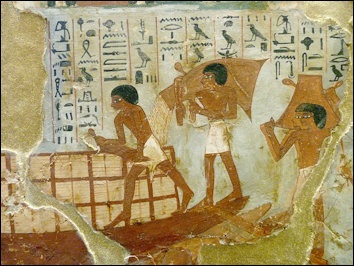
Heidi Köpp-Junk of Universität Trier wrote: “Travel was a crucial element of ancient Egyptian culture. An extensive traffic system by land and by water already existed as early as the Old Kingdom, including various means of transport that did not fundamentally change right through to the New Kingdom. Traveling activity attested for various professions demonstrates that Egyptian society exercised a high degree of mobility. In the majority of cases, a journey was undertaken within the scope of the traveler’s work and on behalf of the pharaoh. Travel had a significant impact on the Egyptian world-view as well as on the development of the identity of Egyptian society as an entity. [Source: Heidi Köpp-Junk, Universität Trier, Germany, UCLA Encyclopedia of Egyptology, 2013 escholarship.org ]
“The concept of travel in ancient Egypt differed greatly from our modern understanding of the term, which is largely associated with tourism. Today, people frequently travel for touristic reasons—namely, their need for rest and relaxation and their curiosity regarding foreign countries and peoples. However, this is a phenomenon that has developed only within the last 130 years. Up to the European Middle Ages and early modern era, traveling mostly took place for economic reasons rather than for pleasure. The same applies to ancient Egypt. From Pharaonic times there is little evidence of journeys for pleasure, or what we would interpret as “touristic” travel today. Due to this fact, travel in ancient Egypt must be defined in a broader sense: it is the movement of a person from A to B, where B lies outside his usual radius of action. Other determining factors are absence from home and staying in other surroundings. Furthermore, the traveler’s intention to return to his point of departure is important, for this distinguishes travel from emigration, where no return is intended.
“Archaeological evidence, in addition to non-fictional and fictional texts, demonstrates how ancient Egyptians traveled. Depictions of Egyptian travelers are rare in Pharaonic Egypt. Occasionally Egyptian means of locomotion and transport appear in wall paintings, and reliefs in tombs and temples. Some sledges, chariots, and wagons, as well as one carrying chair, have been recovered archaeologically.
“Non-fiction sources referring to travels and travelers include biographies, expedition texts, official documents, and visitors’ graffiti. But travel is not the core motif in these texts; it is mentioned only in passing. Therefore the information on travel is rather fragmentary. Typically an inscription will mention only a journey’s starting point or destination, very seldom both. Harkhuf’s explicit reference to his travel routes to the land of Yam— namely, the Oasis Road and the Elephantine Road—is an exception. The means of transport or locomotion used on a voyage were scarcely mentioned. A rare exception occurs in the biography of Weni, where reference is made to the ships in which Weni traveled. The motif of travel appears often in Egyptian literature, for example in The Shipwrecked Sailor, Sinuhe, The Eloquent Peasant, The Letter of Wermai, and Wenamun.”
See Separate Article TRANSPORTATION IN ANCIENT EGYPT
Categories with related articles in this website: Ancient Egyptian History (32 articles) factsanddetails.com ; Ancient Egyptian Religion (24 articles) factsanddetails.com ; Ancient Egyptian Life and Culture (36 articles) factsanddetails.com ; Ancient Egyptian Government, Infrastructure and Economics (24 articles) factsanddetails.com
Websites on Ancient Egypt: UCLA Encyclopedia of Egyptology, escholarship.org ; Internet Ancient History Sourcebook: Egypt sourcebooks.fordham.edu ; Discovering Egypt discoveringegypt.com ; BBC History: Egyptians bbc.co.uk/history/ancient/egyptians ; Ancient History Encyclopedia on Egypt ancient.eu/egypt ; Digital Egypt for Universities. Scholarly treatment with broad coverage and cross references (internal and external). Artifacts used extensively to illustrate topics. ucl.ac.uk/museums-static/digitalegypt ; British Museum: Ancient Egypt ancientegypt.co.uk ; Egypt’s Golden Empire pbs.org/empires/egypt ; Metropolitan Museum of Art www.metmuseum.org ; Oriental Institute Ancient Egypt (Egypt and Sudan) Projects ; Egyptian Antiquities at the Louvre in Paris louvre.fr/en/departments/egyptian-antiquities ; KMT: A Modern Journal of Ancient Egypt kmtjournal.com ; Ancient Egypt Magazine ancientegyptmagazine.co.uk ; Egypt Exploration Society ees.ac.uk ; Amarna Project amarnaproject.com ; Egyptian Study Society, Denver egyptianstudysociety.com ; The Ancient Egypt Site ancient-egypt.org ; Abzu: Guide to Resources for the Study of the Ancient Near East etana.org ; Egyptology Resources fitzmuseum.cam.ac.uk
Ancient Egyptian Travelers

Heidi Köpp-Junk of Universität Trier wrote: “A high degree of mobility is attested in ancient Egypt from the earliest times. Expeditions are already attested in the Predynastic Period. Visitors’ inscriptions from Dynasty 0 were found at the Gebel Tjauti. There is further evidence dating to King Hor Aha and Khasekhemwy in Nubia, and for Djer at Gebel Sheikh Suleiman. Expeditions are attested up to the 30th Dynasty. Travelers, however, were not only members of expeditions: they came from very different professions ranging across the whole of Egyptian society. Besides those professionals requiring a high degree of mobility, such as merchants, messengers, and members of the army, there is documentary evidence of many others, such as traveling physicians, architects, scribes, craftsmen, workers, and priests, who were frequently but not exclusively on the move as members of expeditions. [Source: Heidi Köpp-Junk, Universität Trier, Germany, UCLA Encyclopedia of Egyptology, 2013 escholarship.org ]
“Thus the textual evidence, as demonstrated in these few examples, reveals significantly that travelers came from very different professions from the whole of Egyptian society. A sizable amount of them represented the lower levels of the population, such as the common workers recruited for building the pyramids and other large-scale state building projects, as well as low-ranking soldiers or unskilled laborers, illustrating that a high degree of mobility apparently existed not just for the elite. Moreover, it is evident that the great majority of the travelers were on the move not only in connection with their profession, but on official duty through the order of the pharaoh.
“Most travelers were men; women are only seldom attested. Although there is little explicit evidence for women traveling, frequently their mobility can be deduced, if indirectly. Egyptian marriage customs normally required that women move to their husband’s house, indicating a degree of mobility. Women were also included in corvée labor, for example at a temple of Seneferu. Rare textual and pictorial evidence for women using chariots and carrying chairs demonstrates that they used the same means of transport as men.”
Motivations for Traveling in Ancient Egypt
Heidi Köpp-Junk of Universität Trier wrote: “Throughout history there have been a variety of practical, psychological, and sociological motivations for undertaking a journey, the causal factor of utmost importance being the search for food and attainment of provisions. A secondary reason was to expand territory for settlement due to demographic pressure or military motivations. Trade and aspirations of profit-making were also highly important, coupled with the desire for new raw materials, exotic products, and luxury goods. Curiosity and the thirst for adventure were other motives to start a journey, as well as health reasons and the desire to educate oneself and broaden one’s horizon by visiting foreign lands and peoples. Other travels had a religious impetus, such as pilgrimages, or were of a social nature, such as marriage. [Source: Heidi Köpp-Junk, Universität Trier, Germany, UCLA Encyclopedia of Egyptology, 2013 escholarship.org ]

“Some of these motivations are attested for ancient Egypt, others not. According to textual sources the search for food was never a primary driving factor of Egyptian mobility, although there is evidence of foreign travelers, such as Nubians, who came to Elephantine in search of employment and subsequently reported that “the desert is dying of hunger”. Military motivations are well documented through various war campaigns, like those described in the Annals of Thutmose III. Egyptian travels to Punt or Byblos were motivated by reasons of economics and prestige. The exchange of luxury goods and objects of prestige was already important in the Nagada I Period. The travels of Harkhuf were prompted by a mixture of economic and military reasons.
“Exploratory voyages equivalent to those of Christopher Columbus, or to those of the eighteenth and nineteenth century CE made in search of the source of the Nile, are not known from ancient Egypt. Rather, the textual evidence shows that the ancient Egyptian traveler never journeyed at random but always had a fixed destination. Curiosity as a motive is attested, such as at the Temple of Philae, where visitors’ inscriptions demonstrate an interest in ancient buildings. The desire for education as a stimulus for starting a journey is very rare. It is shown, for example, by New Kingdom school excursions to temples and other monuments, as attested from visitors’ graffiti. Travel for religious purposes is attested from the earliest times. Pilgrimages in the truest sense of the word are known only from the New Kingdom, and possibly from the Middle Kingdom. Because a pilgrimage is defined as a voyage motivated exclusively by religious reasons and expanding the traveler’s usual sphere of action , the en passant inscriptions of expedition members at religious sites do not attest to pilgrimages per se, since religious reasons did not constitute the only impetus for their journey. Examples of involuntary travel (exile or flight) are known as well.”
Traveling Speed in Ancient Egypt
Heidi Köpp-Junk of Universität Trier wrote: “Information regarding the speed of overland travel in ancient Egypt is very seldom evidenced in the texts. Nevertheless, it was extremely important for the traveler for it enabled him to calculate the journey’s duration to the next stop or lodging place. Evidence for running is found on a stele of Taharqa of the 25th Dynasty (684 B.C.). The text states that the route from Memphis to the Fayum, a distance of about 50 kilometers, was covered by soldiers at a speed of 9.2 kilometers/hour to 14.6 kilometers/hour. From the Megiddo campaign of Thutmose III, an average daily travel rate for large troops is attested to be 20 kilometers or even 24 kilometers. The daily rate of marching by a Medjai soldier on patrol was 42 kilometers per day. These texts apply to soldiers, however, and not to ordinary travelers. [Source: Heidi Köpp-Junk, Universität Trier, Germany, UCLA Encyclopedia of Egyptology, 2013 escholarship.org ]
“The speed of travel in ancient Egypt can be reconstructed by comparison with similar means of locomotion and transportation known from the Middle Ages, the modern era, and from experimental archaeology. For walking, one can assume an average speed of 4 - 6 kilometers/hour, allowing for a distance of 25 - 40 kilometers/day. Similar speeds can therefore be extrapolated for se-dan chairs carried by men. Edel suggested an average speed of about 15 kilometers/day for Harkhuf’s donkey-accompanied caravan, including breaks for resting and feeding. Stadelmann and Kuhlmann assume that the daily travel rate for donkeys was about 40 kilometers/day.
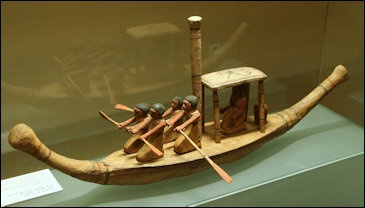
“Medieval four-wheeled freight wagons drawn by horses achieved 23 - 30 kilometers/day—that is, 2.5 - 3.75 kilometers/hour, traveling 8 hours/day. A four-wheeled oxen-drawn wagon, equipped with disk wheels and weighing about 670 - 700 kilogramsfrom the third millennium B.C., is assumed to have achieved about 3.2 kilometers/hour; in an 8-hour travel day, a daily travel rate of 25.6 kilometers/day can be calculated. The speed of Egyptian wagons, and probably carts as well, can therefore be estimated at about 3 kilometers/hour.
“The speed of a horse is 4 - 7 kilometers/hour at a walking pace and 45 - 52 kilometers/hour at a full gallop. An experiment conducted over a distance of 1000 meters with a replica of a chariot determined a speed of 38 kilometers/hour. It was calculated that chariots 3 and 5 from the tomb of Tutankhamen could reach speeds of 40.1 – 87.4 kilometers/hour before the wheel rims would break (adds that in modern trotting races about 50 kilometers/hour was reached). It is therefore realistic to suppose a maximum speed of about 40 kilometers/hour for Egyptian chariots. With the introduction of the horse obviously a new dimension of speed became available to the traveler. Before that, the speed of donkeys and traveling by foot was more or less equally slow.
“The speeds of river travel (i.e., traveling on the Nile) reached even greater extremes, varying considerably between 17 kilometers/day, 73 kilometers/day (Herodotus II: 4 - 9), and 140 kilometers/day, depending on the type of vessel the traveler used, the wind direction, and the stream velocity.
“When determining travel speeds, it is necessary to consider that a combination of different modes of transport and locomotion were often used to reach a destination. The speed of a traveling group consisting of different means of transport and locomotion was determined by the slowest element of the mission. The traveling speed and the distance covered per day also depended on the terrain the traveler had to pass through, on climate and temperature, on the constitution of the traveler himself and his pack or riding animals, the weight they had to carry, and the resting periods they needed.: [Source: Heidi Köpp-Junk, Universität Trier, Germany, UCLA Encyclopedia of Egyptology, 2013 escholarship.org ]
Maps, Guides and Means of Orientation in Ancient Egypt
Heidi Köpp-Junk of Universität Trier wrote: “In ancient Egypt, the traveler could find his way in unknown terrain with the help of a local guide, or with maps or geographical lists, or even route markers. Egypt’s oldest surviving map is on a Ramesside papyrus, now in the Museum of Turin. Depicting a gold mine area with mountains and tracks, it bears geographical and even geological information. The landscape depicted in the map is the Wadi Hammamat, though the concrete relationship to the site is debated. [Source: Heidi Köpp-Junk, Universität Trier, Germany, UCLA Encyclopedia of Egyptology, 2013 escholarship.org ]
“Several geographical lists are known from ancient Egypt. Those geographical lists are not merely a listing of place names in varying order—they also give the names of lands, cities, and villages in the exact geographical sequence in which the traveler passes through them. One geographical list is inscribed on a statue from the mortuary temple of Amenhotep III, describing the travel route from Mykene, via Pylos and Kythera, to Crete. Papyrus Anastasi I gives not only geographical lists but also some detailed information, important to the traveler, concerning Palestine and Syria, including background on the surroundings, and even a description of possible threats, like robbery.
“For orientation in nearer surroundings, route markers were used along the way, such as stone piles called alamat, solitary stone blocks, or stelae. Roads and paths served as guidelines as well.”
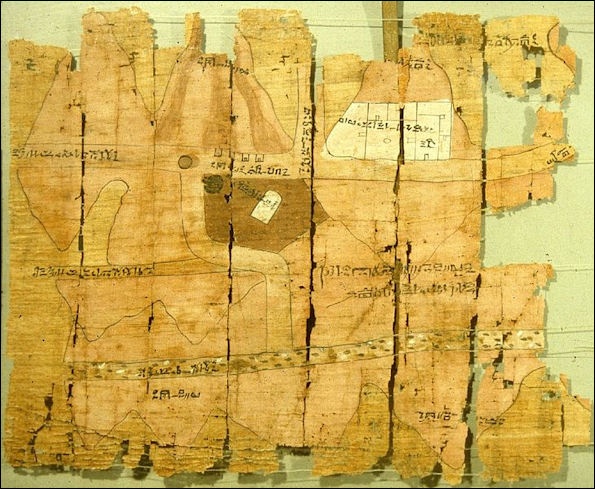
Ancient Egyptian mining map
Accommodation for Ancient Egyptian Travelers
Heidi Köpp-Junk of Universität Trier wrote: “In the desert, the traveler found primitive accommodations in the form of semicircular wind huts built with irregular stones. Two of these camps were found near the road from Gebel el-Asr to Tushka. Other options were to sleep outdoors or in tents. Even pharaohs lodged in tents on their military campaigns and expeditions, as did Thutmose III during his Megiddo campaign, Ramesses II during the battle of Kadesh, and also Pije. Akhenaton slept in a tent when he first visited Amarna. [Source: Heidi Köpp-Junk, Universität Trier, Germany, UCLA Encyclopedia of Egyptology, 2013 escholarship.org ]
“In the Hetepheres deposit, as well as in the tomb of Tutankhamen, royal travel equipment was found. The latter had a light folding bed. Hetepheres’s complete traveling ensemble was found in Giza, including a tent, traveling bed, chair, and even the palanquin.
“Special stations for the lodging of the king’s messengers are known from the New Kingdom at the latest. Diodorus Siculus (first century B.C.) mentioned one hundred horse relay stations between Memphis and Thebes. At these stations the messengers found food and accommodations and exchanged their tired horses for refreshed ones, which improved the traveling speed. In contrast, the elite, the royal retinue, and those who journeyed on official duty were supplied by state-owned institutions, such as temples, chapels, and special storage facilities. The concept of hospitality existed in ancient Egypt in much the same manner that it appeared in the European Middle Ages: the traveler was supplied with food and water and accommodated by the local residents when passing through foreign but inhabited terrain.
Travelers took clothing, sandals, sticks, and weapons with them, as well as food and water for themselves and their pack or riding animals. If the journey was of any great length, the traveler had to consequently depend on wells, cisterns, or water deposits along the way. There is archaeological evidence for chains of water supplies along desert tracks, such as the Old Kingdom water depots in the Libyan Desert on the Abu Ballas Trail The route the traveler chose was of course determined by the existence of such water depots.”
Obstacles and Dangers Faced by Ancient Egyptian Travelers
Heidi Köpp-Junk of Universität Trier wrote: “ Traveling was dangerous. Natural obstacles such as cataracts, deserts, or mountains delayed or even prevented the traveler’s return. He could lose his way or find a watering place dried out, or he could run out of supplies in the event of hindrances. Further dangers derived from extreme weather, such as violent storms and intense heat. Diseases threatened as a result of hunger, thirst, bad weather, or overexertion. Papyrus A nastasi vividly illustrates how exhausting traveling could be in its description of a traveler, weary after crossing a mountain and the River Jordan , arriving home to Egypt with his tired horses, only to be robbed and to find his food supplies gone . The danger of being robbed while traveling was clearly very high. The Admonitions of Ipuwer , although a text of exaggerated literary form, shows that the occurrence of robbery was a known phenomenon. The text explicitly warns of plunderers along the road: “O, but the plunderer [rob]s everywhere” and “they sit in bushes until a night traveler comes to seize his load, and what he carried is taken; he is treated to blows of a stick, and is falsely slain”. [Source: Heidi Köpp-Junk, Universität Trier, Germany, UCLA Encyclopedia of Egyptology, 2013 escholarship.org ]
“Due to the imminent dangers on the way, the undertaking of a journey implied the possibility of not returning home. The inscription of the second Hammamat stela of Ramesses IV mentions 900 de ad on an expedition of 8,368 members —that is, approximately ten percent of the total number of members. To the ancient Egyptian, it was very important not to die abroad or, even worse, be buried in a foreign land, for fear that an adequate afterlife would only be possible if he were buried in Egypt. This becomes clear from the tale of The Shipwrecked Sailor and of Sinuhe . In The Shipwrecked Sailor, the importance of dying in Egypt is explicitly mentioned: “Then, a ship shall come from the Residence with sailors that you (would) recognize. You shall leave with them to the Residence; you shall die in your city”. In The Tale of Sinuhe the protagonist states: “What could be more important than that my body be buried in the land where I was born?”
“Travelers nevertheless died abroad. The inscrip tions of the Old Kingdom expedition leaders Sabni and Pepinakht state that both went on a journey to bring back the bodies of Egyptians who died far from home on expeditions. It was therefore not unusual, in this period at least, to bring deceased members of the elite or high-ranking officials home to be buried in Egypt.”
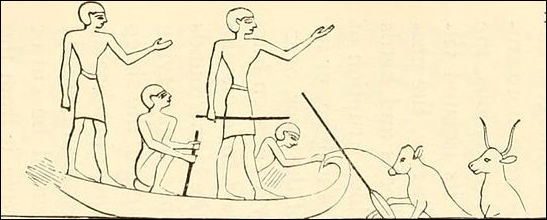
cattle rescued from flooding
Expeditions in Ancient Egypt
Heidi Köpp-Junk of Universität Trier wrote: “Two important categories of travelers were members of expeditions and members of the army, both consisting of a variety of occupational categories. Expeditions to Sinai could include “twenty-five different types of government officials, eleven types of specialized local mining officials, eight types of artisans and nine types of laborers”. The same range is evidenced at the Wadi el-Hudi and the Wadi Hammamat in the Middle Kingdom. The officials referred to in the expedition texts are not only high- ranking but from lower ranks as well . Hunters, fowlers, brewers, sandal makers, bakers, scribes, millers, servants, physicians, priests, and mayors are mentioned in the texts. In the New Kingdom, professions connected with horses and chariots, such as charioteers, were attested. [Source: Heidi Köpp-Junk, Universität Trier, Germany, UCLA Encyclopedia of Egyptology, 2013 escholarship.org ]
“Expeditions differed in size and in the profession of their members, depending on the type of material they were sent out to retrieve, or on the goods they were going to trade. For example, quarrying expeditions for precious stones and gems required a greater number of specialists, whereas expeditions for large, heavy blocks required a majority of lessor- skilled workers for the quarrying, and especially the transport, of the stones. In the Old Kingdom, the number of expedition members lies between 80 und 20,000. Senusret I sent to the Wadi Hammamat an expedition that included “18,660 skilled and unskilled workers”. A mission under the reign of Ramesses III counted 3,000 members, including 2,000 common workers and 500 masons. An expedition under Ramesses IV consisted of 408 members in total, among them 50 stone-carriers and 200 transport-carriers. Already from these few pieces of evidence it becomes clear that expedition members came from various professions with a sizable number of common workers among them.
“A calculation of the figures given in the expedition texts reveals that there is evidence for approximately 23,400 members of expeditions in the Old Kingdom, nearly 40,000 in the Middle Kingdom, and 13,622 in the New Kingdom. The explanation as to why the number of expedition members in the New Kingdom is lower in comparison with that of the Old and Middle Kingdoms lies in the fact that there are fewer expedition-related inscriptions from the New Kingdom that survive and they are less detailed than those from the Middle Kingdom. It is assumed nevertheless that the number of travelers increased with the expansion of the Egyptian empire in the New Kingdom, since the expansion promoted a higher degree of mobility within several professions, such as the military and the administration. “Not every expedition that took place is documented; thus the total number of travelers who were on the move as members of expeditions is higher than the documented figures we possess. Furthermore, since the expedition texts frequently mention only the higher ranking members, while the lower grades are often not mentioned, the total figures may conceivably have been much higher.”
Workers on the Move in Ancient Egypt
Heidi Köpp-Junk of Universität Trier wrote: “Apart from members of expeditions and of the army, other travelers with a variety of occupations are mentioned in the texts. Egyptian physicians not only took part in expeditions, but they were sent out by the pharaoh on building projects and to foreign royal courts, due to the considerable repute they enjoyed. [Source: Heidi Köpp-Junk, Universität Trier, Germany, UCLA Encyclopedia of Egyptology, 2013 escholarship.org ]
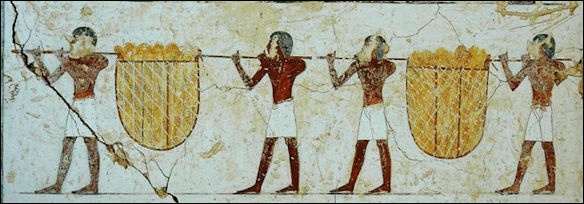
“Architects were on the move for professional reasons and on behalf of the pharaoh to supervise official building projects. One such architect was Nekhebu of the 6th Dynasty. He was sent out several times by Pepy I to Upper and Lower Egypt to oversee the digging of a canal in Qus and the royal building projects in Heliopolis, where he stayed for six years. During this time, he made a few official trips to the residence in Memphis.
“The mobility of scribes arose from the fact that, being part of the bureaucracy, they were transferred by official order to new places of employment as required. This could be sent within Egypt but abroad as well. Such a widely traveled scribe was Nebnetjeru, whose graffiti is found between Kalabsha and Dendur, near Tonkalah, and possibly even at Toshka.
“Craftsmen were also on the move. There is evidence of craftsmen in the service of private individuals and of pharaoh. They were not necessarily tied to a particular workshop but were sent out on expeditions and large-scale royal building projects. Even higher-ranking craftsmen with titles such as Hmw wr, jmj-rA kAt, and jmj-rA nbjw n pr Ra are among those whose project-related work orders caused them to travel.
“Priests traveled not only as members of expeditions but also in order to fulfil special duties for temples or to organize religious festivities, as did Ikhernofret at Abydos in the 12th Dynasty. A high official’s occupational move to a different location is frequently mentioned. Mayors , viziers, as well as the pharaoh traveled on official government business—e.g., inspections, and diplomatic or military missions. Royal journeys are shown to have taken place beginning in Predynastic times from several sources including annals. Furthermore, the so-called Smsw 1rw, the “following of Horus,” took place every two years and led the king through the whole land . In the New Kingdom, Pharaoh traveled yearly for religious reasons to Thebes to celebrate the Opet Festival. Royal travels are further attested in the annals of Thutmose III reporting his war campaigns or the inscriptions at the temple of Kanais recording a visit by Sety I to the Eastern Desert.”
Personal Travel in Ancient Egypt Rare?
Heidi Köpp-Junk of Universität Trier wrote: “The most frequent reason to start a journey, according to the texts, was not of a personal nature, but rather occupational and on behalf of the king. Constituting an exception were traders, who had high occupational mobility and traveled because of their own work- related interests, without having been explicitly sent out by the king. [Source: Heidi Köpp-Junk, Universität Trier, Germany, UCLA Encyclopedia of Egyptology, 2013 escholarship.org ]
“Evidence for private journeys is rare. One of the few known pieces of evidence for private travelers is in a tomb biography of Sabni, the 6th-Dynasty governor of the territory of Aswan . Upon being informed of his father’s death, Sabni embarked on a journey to fetch the corpse . The text does not mention an explicit royal order that Sabni undertake the journey. During his voyage, Sabni sends out a courier with a message. Although the recipient of the note is not mentioned, it is to be assumed that it was addressed to the royal residence, for a high-ranking official like Sabni was certainly not allowed to leave his position and travel abroad without official permission. It appears, therefore, that his journey was undertaken for private reasons (the death of his father), but that he needed official dispensation to leave. Another private traveler was perhaps Heqanakht of the 11th Dynasty, who owned land near Lisht but sent letters to his family in Thebes, where he was working; it is not known, however, whether he was traveling for governmental purposes or for private reasons.
“The fact that private travels are seldom attested in textual material does not imply that they did not take place (we have seen above that they did), but only that they have not been recorded. For example, private travel surely did occur for family reasons, including marriage. Travels for private reasons are therefore indirectly proven by the marriages themselves and the resulting family visits. Moreover, visits to the tombs of deceased relatives are widely attested. The factual extent of private mobility, highlighted by these traces of evidence, can only be surmised at best, since much concrete proof for its range and diversity is lacking.”
Social Implications of Travel in Ancient Egypt
Heidi Köpp-Junk of Universität Trier wrote: “Travel and mobility had fundamental implications for Egyptian society, for they played an essential role in the exchange of ideas and innovations, and in the self-definition of a culture. Only when perceiving and accepting the existence of other cultures did Egyptians begin to see themselves as belonging to one entity, thus leading to the development of Egyptian identity. Moreover, in the interaction with the foreign, the traveler left his everyday radius of action and expanded his knowledge and broadened his horizons. This happened not only through travel in foreign lands but even on Egyptian terrain that was unfamiliar. The Tale of Sinuhe makes reference to this feeling of foreignness by evoking the experience of an Egyptian within Egypt: “It was like the nature of a dream, like a Delta man seeing himself in Elephantine, a man of the marshy lagoons in southern Egypt. [Source: Heidi Köpp-Junk, Universität Trier, Germany, UCLA Encyclopedia of Egyptology, 2013 escholarship.org ]
“Through comparison with medieval Europe one could assume that it was predominantly the Egyptian nobility and clergy who traveled, and therefore the elite and higher social levels. In fact, in medieval society, the mobility of craftsmen, traders, and students surpassed that of the nobility and clergy. An analogous situation applies to ancient Egypt, for in addition to the travels of the elite, the mobility of professions of the middle and lower class is proven in the texts. A group of travelers not to be ignored consisted of lower-ranking soldiers and workers, i.e., under- privileged people, because they played a major role in expeditions and armies. Furthermore, the mobilizing effect of the so-called corvée labor should not be underestimated. Up to two percent of the population was sup- posedly involved in building the pyramids, and was therefore on the move. Mobility was therefore obviously independent of social or financial background and not a status symbol.

“No texts have been handed down that were composed directly by travelers from the lower social strata; rather, we possess only indirect references to them. Biographies of elite members of society, however, often include portrayals of travel. Although traveling and mobility were de facto not indicators of status, Baines stresses that travel was regarded as prestigious within the elite and was therefore emphasized in their biographies.
“The means of transportation depended on the social status of the traveler. The lower classes traveled by foot or, at best, by donkey. Well-to-do people, probably including dignitaries, traveled mounted on donkeys in the Old and Middle Kingdoms, the donkeys also serving to transport the travelers’ belongings. The elite traveled in the most prestigious ways—namely, by carrying chairs transported by servants or donkeys in the Old and Middle Kingdoms, and by chariots in the New Kingdom. Luggage was borne by donkeys or by carriers with the help of poles and yokes.
“The distances traveled varied considerably. There is evidence of short trips as well as journeys covering almost 1,400 kilometers, as was attested for the priest Horemkhauf, who traveled from Hierakonpolis to JTj-tAwj, near Lisht, and back (of course some people never traveled, their range of movement encompassing only their own village and its vicinity). Some travelers moved perhaps as far as 14,000 kilometers, such as Harkhuf, if we surmise that the one-way distance to Yam is 1,725 kilometers. In Harkhuf’s biography three journeys to Yam are explicitly mentioned, and there is indirect evidence of a fourth in a letter from Pepy II. The location of Yam is nevertheless controversial.”
Travel as a Motif in Egyptian Literature
Heidi Köpp-Junk of Universität Trier wrote: “A number of Egyptologists have worked on the motif of travel in Egyptian literature. The travel motif represents the crossing of borders in a dual sense: as transgressing the border from fact to fiction and from the known into the unknown. Traveling to unfamiliar, far-off places, the protagonist undergoes a process of identity- questioning and finds himself in the end. The travel motif is sometimes used didactically to demonstrate how a protagonist breaks free from society and tradition, but is “re-educated” by isolation and returns repentant to adapt to the norms of his social group. [Source: Heidi Köpp-Junk, Universität Trier, Germany, UCLA Encyclopedia of Egyptology, 2013 escholarship.org ]
“The Egyptian travel narratives exhibit the motif of the protagonist as a traveler leaving home. Starting a journey into unknown spheres, the traveler transgresses borders and must undergo life- threatening dangers and risks, forcing him to re- evaluate his own identity. The experience allows him to return to Egypt with a reaffirmation of being an Egyptian living according to the concept of maat. The outside journey is a metaphor for his journey inside himself. The unknown spheres in the travel narratives of the Middle and New Kingdoms were foreign lands, such as Asia Minor. In later times, when these lands were no longer exotic, they were replaced by the Egyptian underworld, as in Demotic texts such as Papyrus Vandier and The Tales of Setne .
“Old Kingdom texts dealing with travel, such as biographies, official documents, and expedition texts, differ from travel texts of later times, for they portray travel “as a matter of economic or political concern”. The journeys within these texts do not lead to foreign and unexplored places, nor do the protagonists show any fear of transgressing borders. In the texts of the Old Kingdom, the travel motif is not developed fictively as it is in later times. They are no travelogues written to entertain the reader. Instead of fiction, facts are stated to emphasize the traveler’s outstanding personal achievements, such as we see in the text of the expedition leader Harkhuf.
“The travel narratives from the Middle and New Kingdoms constitute a genre of their own. They display their fictionality via the topic of transgressing boundaries and the motif of traveling abroad: “Since, if fiction is ... an act of transgressing boundaries such as the one between reality of the world and a hypothetical reality, the traveling-abroad motif becomes the ideal and predestined vehicle of literary fictionality”. The protagonist of fictional literature transgresses borders that separate the known world from what lies beyond, manifested in woodland or water. It is exactly where danger is lurking. Water, in its boundlessness and associated perils such as tempest and tidal wave, is a particular motif in the stories of The Shipwrecked Sailor, Sinuhe, and Wenamun. In the tale of The Shipwrecked Sailor, it is said: “A tempest came when we were at (high) sea. Before we could reach land, the wind rose, it got stronger and there were waves eight cubits high. It was a beam that struck me. When the ship died, none was left that were on board”. Sinuhe had to cross the Nile: “At the dinner hour, I had reached the town of Negau. I crossed the river on a rudderless raft, with the wind from the West”. He ran the risk of being swept away because the boat had no rudder. The story of Wenamun vividly expresses the dangers of water and sea journeys, e.g., “Do not come to look for danger in the sea. If you look for danger in the sea, look also at me” and “If the sea carries (me) and the wind pushes me towards the land where you are, will you allow that I am received to be killed, I being a commissioner of Amun?”.
“The same attitude towards water is found in The Letter of Wermai. Since overland travel is a metaphor for the path through life, sea journeys represent an individual’s way of life and the dangers and unpredictability of life per se. By transgressing the borders of the geographically known world and leaving his culturally predetermined life, the traveler becomes guilt-laden, for his traveling abroad implies the rejection of traditional norms and of Egyptian cultural identity . “It is exactly this aspect of individuality that is evaluated as being especially negative”. With the travel motif, the reader is advised to live his life in accordance with the principles of maat, for living outside of it and beyond the traditional sociocultural norms of Egyptian society leads to failure. The risks the traveler is exposed to while abroad are the sanctions of that individuality. The traveler’s guilt is released upon his return—namely, his return not only to Egypt but to his place in society.”
Image Sources: Wikimedia Commons
Text Sources: UCLA Encyclopedia of Egyptology, escholarship.org ; Internet Ancient History Sourcebook: Egypt sourcebooks.fordham.edu ; Tour Egypt, Minnesota State University, Mankato, ethanholman.com; Mark Millmore, discoveringegypt.com discoveringegypt.com ; Metropolitan Museum of Art, National Geographic, Smithsonian magazine, New York Times, Washington Post, Los Angeles Times, Discover magazine, Times of London, Natural History magazine, Archaeology magazine, The New Yorker, BBC, Encyclopædia Britannica, Time, Newsweek, Wikipedia, Reuters, Associated Press, The Guardian, AFP, Lonely Planet Guides, “World Religions” edited by Geoffrey Parrinder (Facts on File Publications, New York); “History of Warfare” by John Keegan (Vintage Books); “History of Art” by H.W. Janson Prentice Hall, Englewood Cliffs, N.J.), Compton’s Encyclopedia and various books and other publications.
Last updated September 2018
- Google+
Page Top
This site contains copyrighted material the use of which has not always been authorized by the copyright owner. Such material is made available in an effort to advance understanding of country or topic discussed in the article. This constitutes 'fair use' of any such copyrighted material as provided for in section 107 of the US Copyright Law. In accordance with Title 17 U.S.C. Section 107, the material on this site is distributed without profit. If you wish to use copyrighted material from this site for purposes of your own that go beyond 'fair use', you must obtain permission from the copyright owner. If you are the copyright owner and would like this content removed from factsanddetails.com, please contact me.
Brilliant Maps
Making Sense Of The World, One Map At A Time
Travel Time from Ancient Rome
Last Updated: March 3, 2023 Leave a Comment
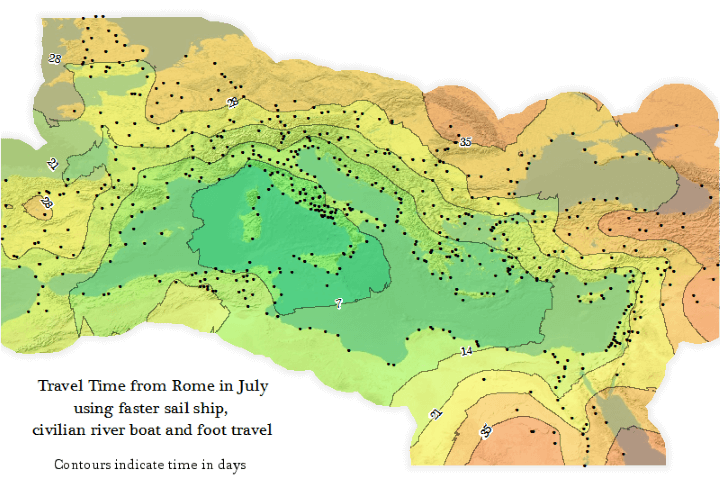
The map above is an Isochrone map which shows how long it would have taken someone to travel from Rome to the farthest reaches of the Roman Empire at its peak (roughly 200 CE/AD).
Travelling within the core of the Empire could have be done in under a week, but travelling all the way to the fringes would have taken someone more than a month.
Contrast that with Travel Times From London in 2016 vs 1914 . By 1914 you could have reached almost any point on earth within 40 days and by 2016 you could reach almost any point on earth within 2 days.
If you’re curious about the project, here’s a very brief introduction:
ORBIS: The Stanford Geospatial Network Model of the Roman World reconstructs the time cost and financial expense associated with a wide range of different types of travel in antiquity. The model is based on a simplified version of the giant network of cities, roads, rivers and sea lanes that framed movement across the Roman Empire. It broadly reflects conditions around 200 CE but also covers a few sites and roads created in late antiquity. The model consists of 632 sites, most of them urban settlements but also including important promontories and mountain passes, and covers close to 10 million square kilometers (~4 million square miles) of terrestrial and maritime space. 301 sites serve as sea ports. The baseline road network encompasses 84,631 kilometers (52,587 miles) of road or desert tracks, complemented by 28,272 kilometers (17,567 miles) of navigable rivers and canals.
You can learn more about the project and play with an interactive version on the ORBIS homepage .
For other maps of the Roman Empire have a look at:
- An Incredibly Detailed Map of the Roman Empire At Its Height in 211AD
- Roman Empire GDP Per Capita Map
- Roman City of Londinium Around AD 200
- A View Of Roman Carthage, Built on the Site of the Previously Destroyed Punic Capital
- Byzantine Constantinople Before It Was Istanbul
- Byzantine Empire’s Linguistic Divisions Under Justinian I c.560CE
And to learn even more about the Roman world have a look at:
- SPQR: A History of Ancient Rome
- Ancient Rome. The Rise And Fall Of An Empire
- Pax Romana: War, Peace and Conquest in the Roman World
Get Our Latest Brilliant Maps In Your Inbox
Other popular maps.

4 Colour Theorem: All The World’s Countries Can Be Coloured Using Only 4 Colours, So That No Two Adjacent Countries Share The Same Colour

European Languages According To The Dutch
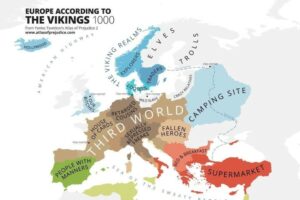
Europe According to the Vikings in 1000 AD
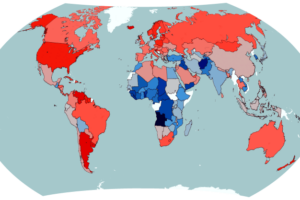
Shocking Men Vs Women Differences In Years Of Education
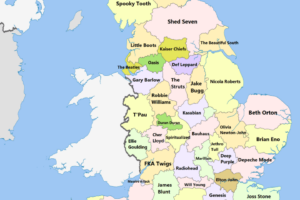
Best Selling Musical Artists By English County of Origin

Pangaea With Current International Borders
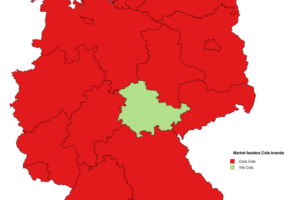
Most Popular Cola Brands in Germany

Interactive Pangaea Map With Modern International Borders
Leave a reply cancel reply.
Your email address will not be published. Required fields are marked *
This site uses Akismet to reduce spam. Learn how your comment data is processed .
- July 1, 2022
- Europe , Now Boarding , Travel Inspiration
Explore Ancient Greece – A 14 days Travel Itinerary

While there are many tours and itineraries which incorporate everything that Greece has to offer, such as the magical Greek Islands, historic locations as well as adventurous locations, we have put together a 14-day ancient Greece travel itinerary that is ideally suited to those who want to get up close and personal with the many ancient ruins and sites that revolve around the countries impressive and long past.
This itinerary will be an exciting opportunity to be guided by a local Destination Expert, who can answer your questions along the way, introduce you to these sites from a local perspective and show you some important hidden gems, which are significant to Greece’s historic past. If you are a history buff and have always wanted to get an in-depth look at the various sites scattered throughout Greece, then this 14-day ancient Greece travel itinerary is for you.
Athens, Delphi, Olympia, Meteora & Santorini
While some of these sites can be explored within a short time, this 14-day ancient Greece travel itinerary ensures that you get to see a variety of the best and most important (and most impressive) ancient sites which are located around the country. Two weeks is a perfect amount of time to enjoy your time, take it all in, and still have time to relax in between all the visits, which is a must when it comes to an itinerary like this. There is so much to look forward to on this immersive 14-day itinerary, so let us show you what you can expect to experience.
Day 1: Athens
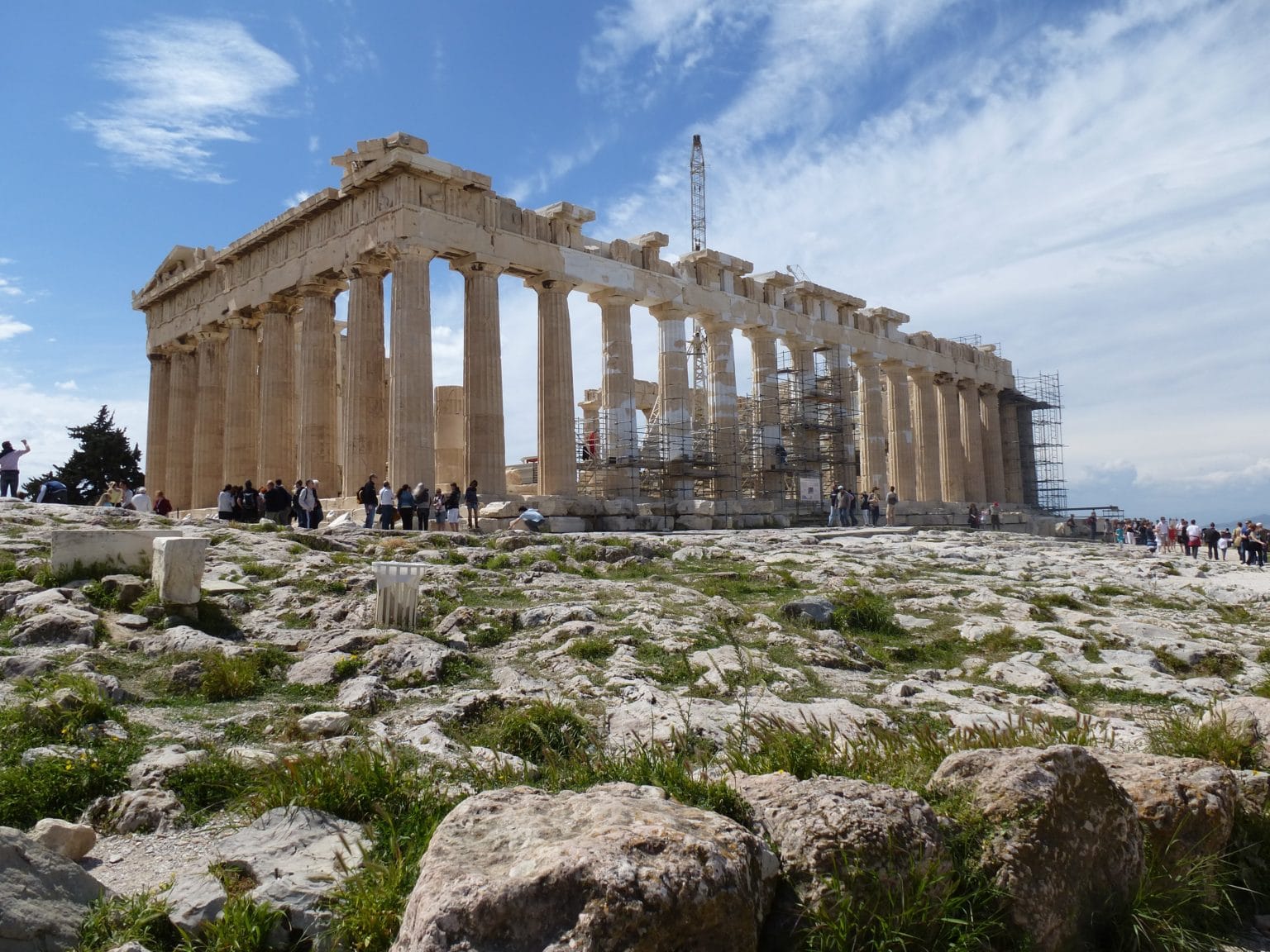
You will begin your journey in the capital of Athens, a city that is one of the oldest in the world. You will have a chance to unwind, explore the streets of the vibrant Plaka neighborhood, as well as indulge in your first of many Greek dinners that evening with a phenomenal view over the Parthenon. Get a good rest tonight, to set yourself up for the following days of history and adventure.
Day 2: Athens
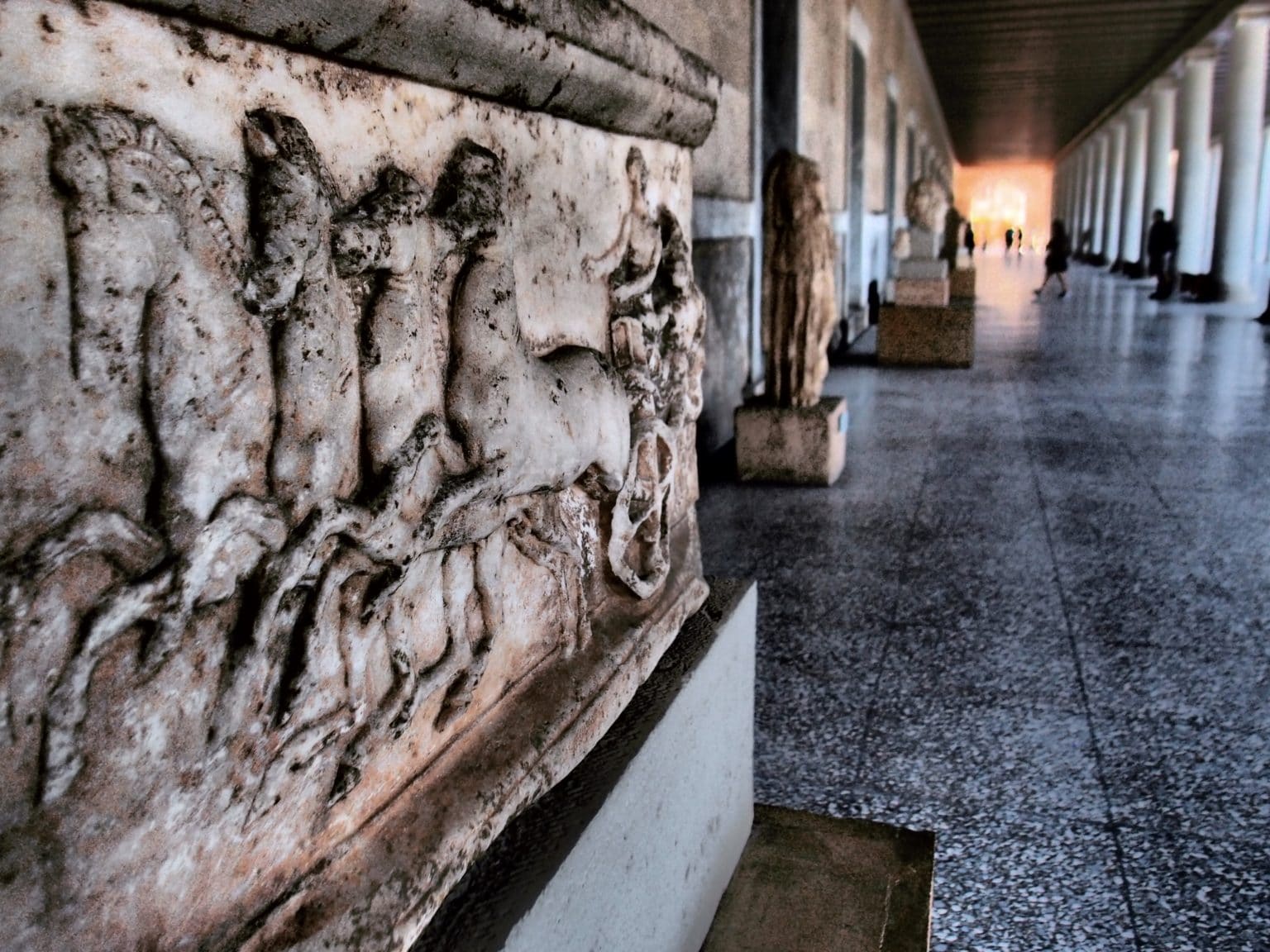
Today will be an immersive experience of Athens and all that it offers, including a city tour, a trip to the Acropolis, and a visit to the Acropolis Museum, which houses all the artifacts ever found at this site. You will get y=to feast your eyes on the Parthenon, the Erechtheion, the Propylaea, the Nike Temple, and while exploring the city you can marvel at the Odeon of Herodes Atticus, the Ancient Agora, and the National Observatory of Athens.
Day 3: Delphi
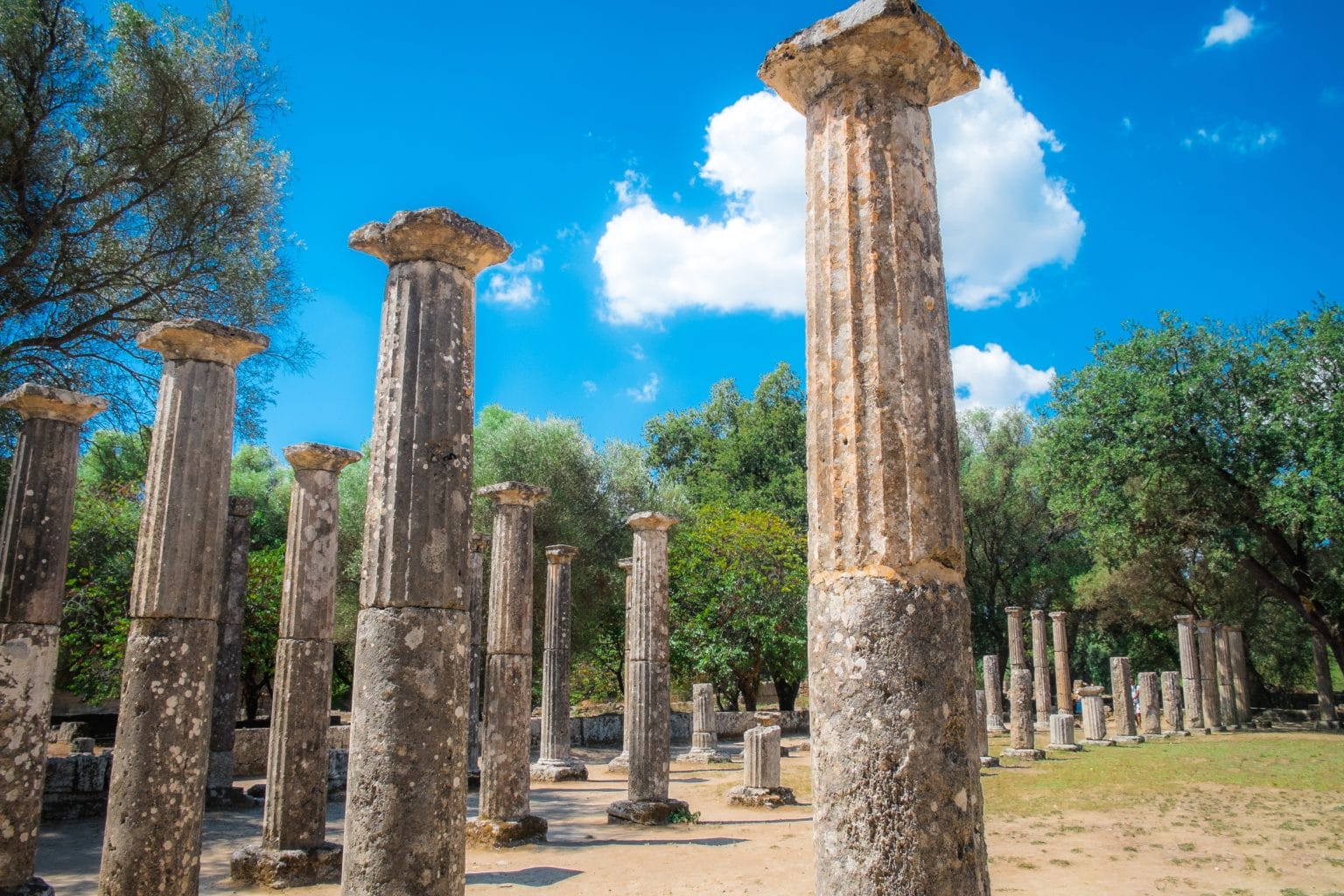
Today you will make your way to Delphi, a place steeped in history, 3,000 years of it to be specific, and history lovers will be in their element with a guided tour of the Archeological Museum of Delphi, the UNESCO World Heritage Site itself as well as the stories behind it all. This impressive archeological site was recognized for its unique place in Ancient Greek mythology, culture, and Hellenic unity and was the home of the Muses where people consulted the Oracle of Delphi for wisdom before any major decisions were made. There is plenty of information to take in today, so take your time and ask plenty of questions.
Day 4: Olympia
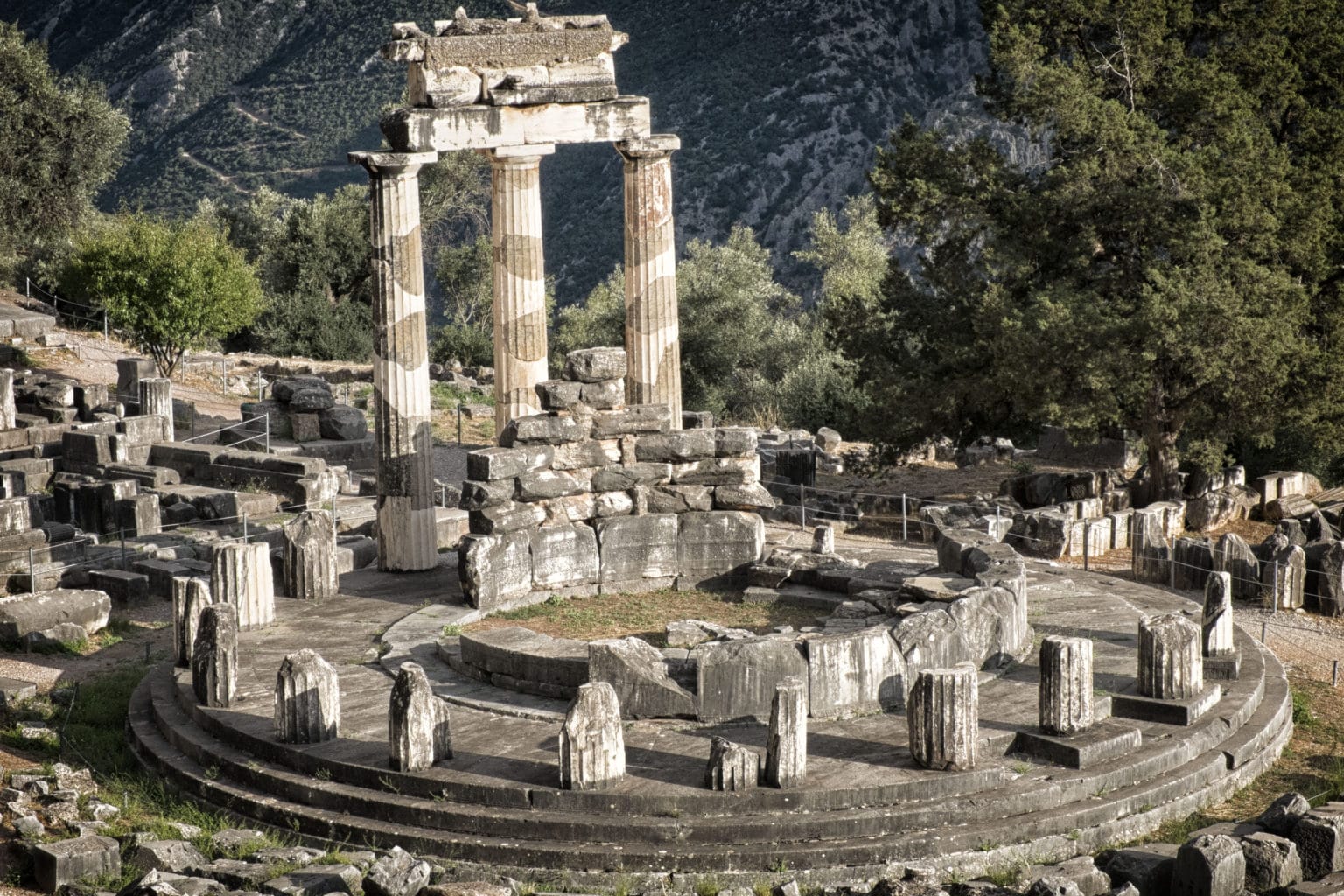
Olympia is one of the most fascinating places on earth and is one that has such a strong historical significance in Greece and throughout the world. No trip to the mainland is complete without a visit to the birthplace of the Olympic Games, which began in the 8th Century BC and lasted until the 4th Century AD. Apart from marveling at one of the Seven Wonders of the Ancient World, you will get a chance to visit the on-site museum, which will provide all the relevant information.
Day 5: Dimoitsana Village
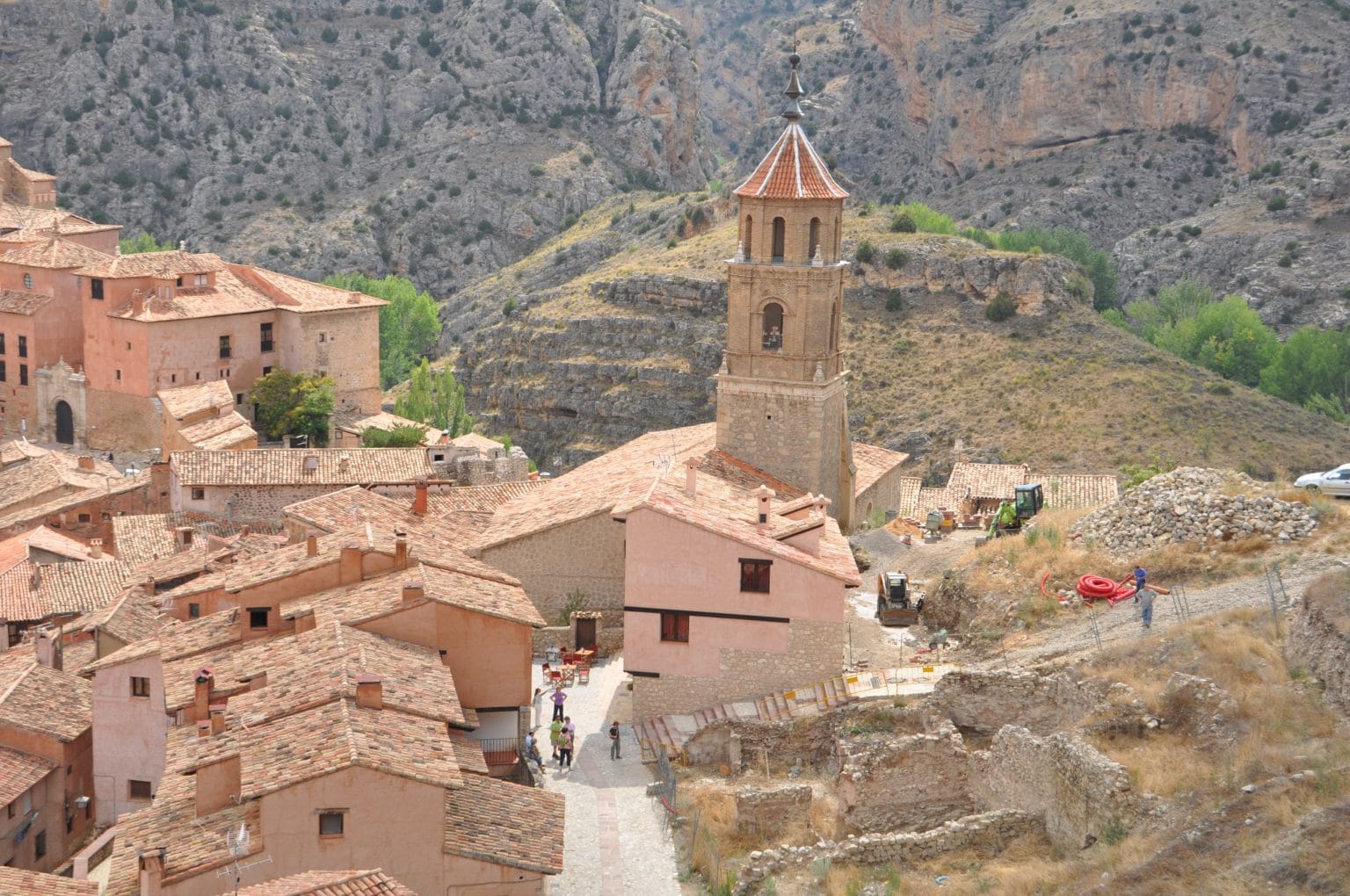
This rural village in the mountains of the Peloponnese was once an important base for revolutionary fighters and is home to an Open-Air Water Powered Museum which can be discovered before some river walking to the town of Stemitsana for an afternoon of leisure. This town is known for its handicrafts and silver smithing, so be sure to wander around and see what gems you can find.
Day 6: Nafplio
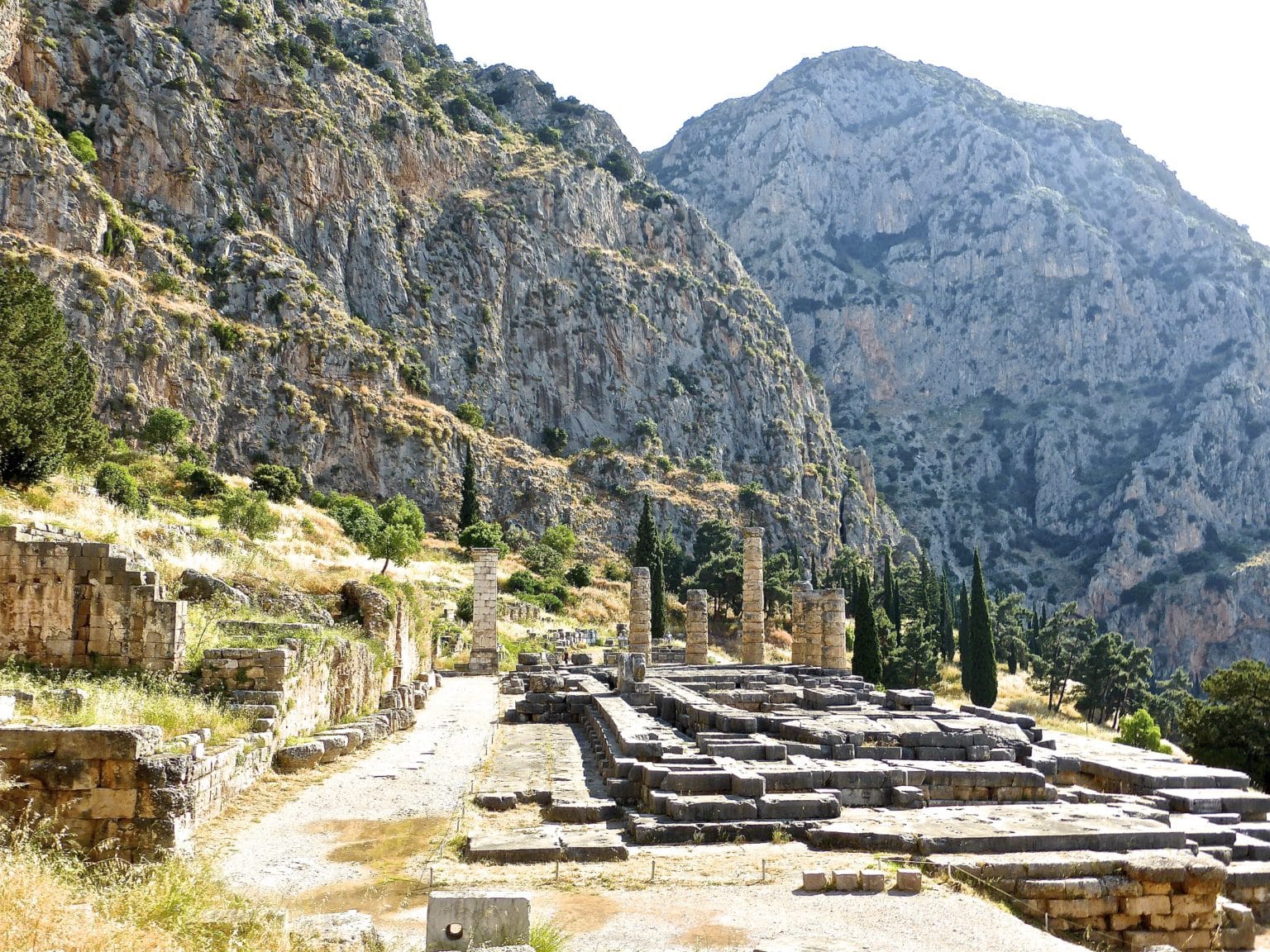
This coastal town is a beauty waiting to be discovered, and not only does it have an impressive hilltop fortress that provides excellent coastal views, but the town itself is a joy to wander around, with plenty of bars, restaurants, and local stores to enjoy. Take some time to enjoy the harbor, follow in the footsteps of history and enjoy some local food and drinks in town with stunning vistas.
Day 7: Ancient Mycenae
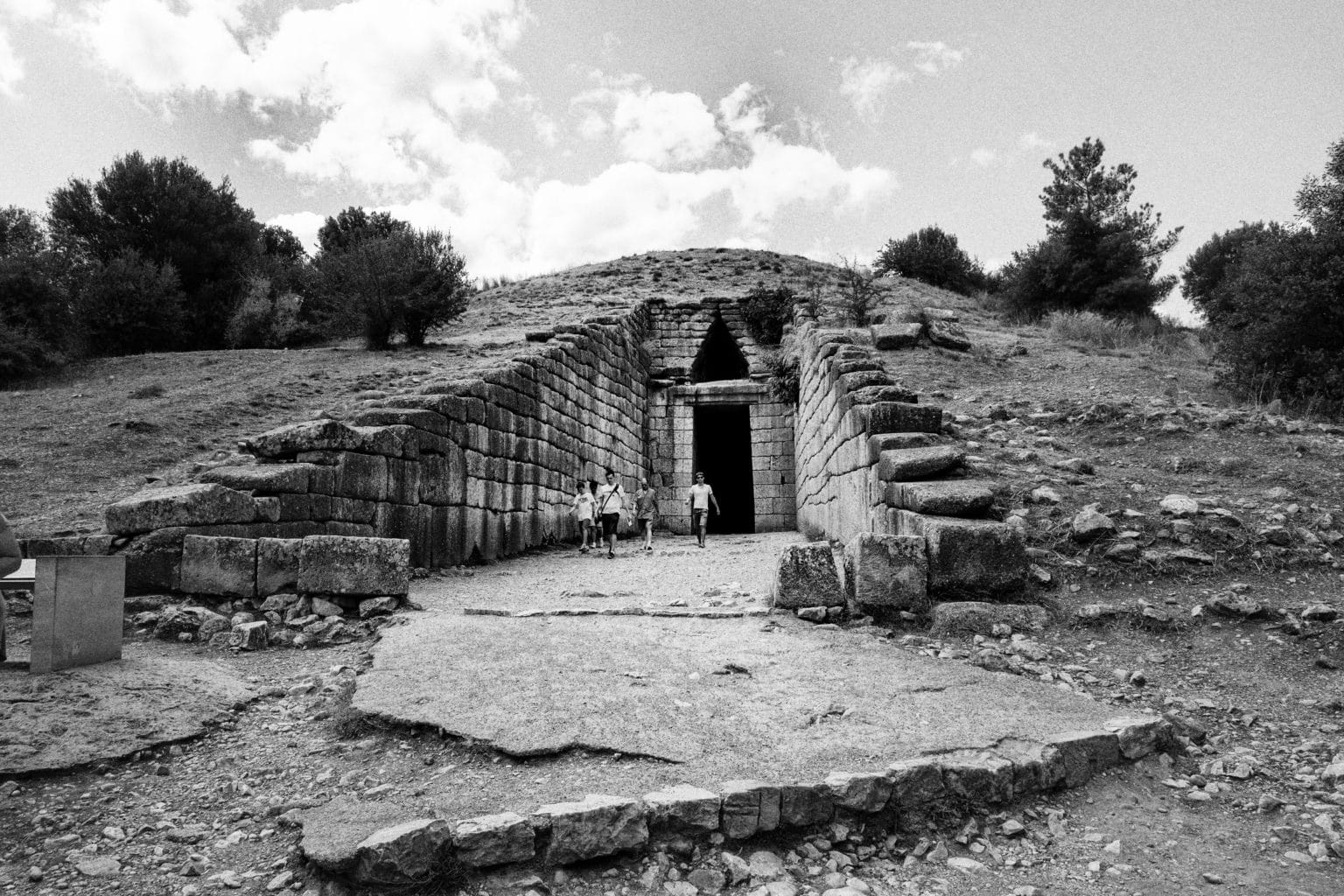
Today you will visit the archaeological site of Mycenae, which is one of the most famous in the country and will be a fantastic experience for anyone with a keen interest in Greek history. This impressive site was recognized by UNESCO for many reasons, and it is one of the most visited ancient sites of Greece, providing a great insight into Mycenae culture and civilization, which dominated mainland Greece at one time.
Day 8: Travel to Santorini

After many days of historic sites, incredible views, and a lot of information, it is time to take the ferry to Santorini, the first island of the trip. This is an ideal place to relax, unwind and experience a part of Greece which differs greatly from the mainland. This will be the ideal chance to get more into the culture and heritage of Greece, giving you a different perspective of the country compared to the ancient Greek way of life you have come to learn about. Experience the history of winemaking, try local food, and enjoy the stunning sunset over the iconic white and blue hillside houses, before diving right back into your ancient Greece travel itinerary with a visit to the Byzantine Castle ruins.
Day 9: Santorini at your leisure

Today is the day you can pick and choose what you feel like doing, and Santorini is an ideal place to suit everyone’s taste, with a variety of beaches to relax on, activities to enjoy, and sights to see – your day can be enjoyed as you please. Some fantastic options include taking a boat trip to the Santorini caldera, doing some hiking, going swimming at one of the many Blue Flag beaches, or strolling around the local shops taking the day slowly.
Day 10: Hiking the Caldera
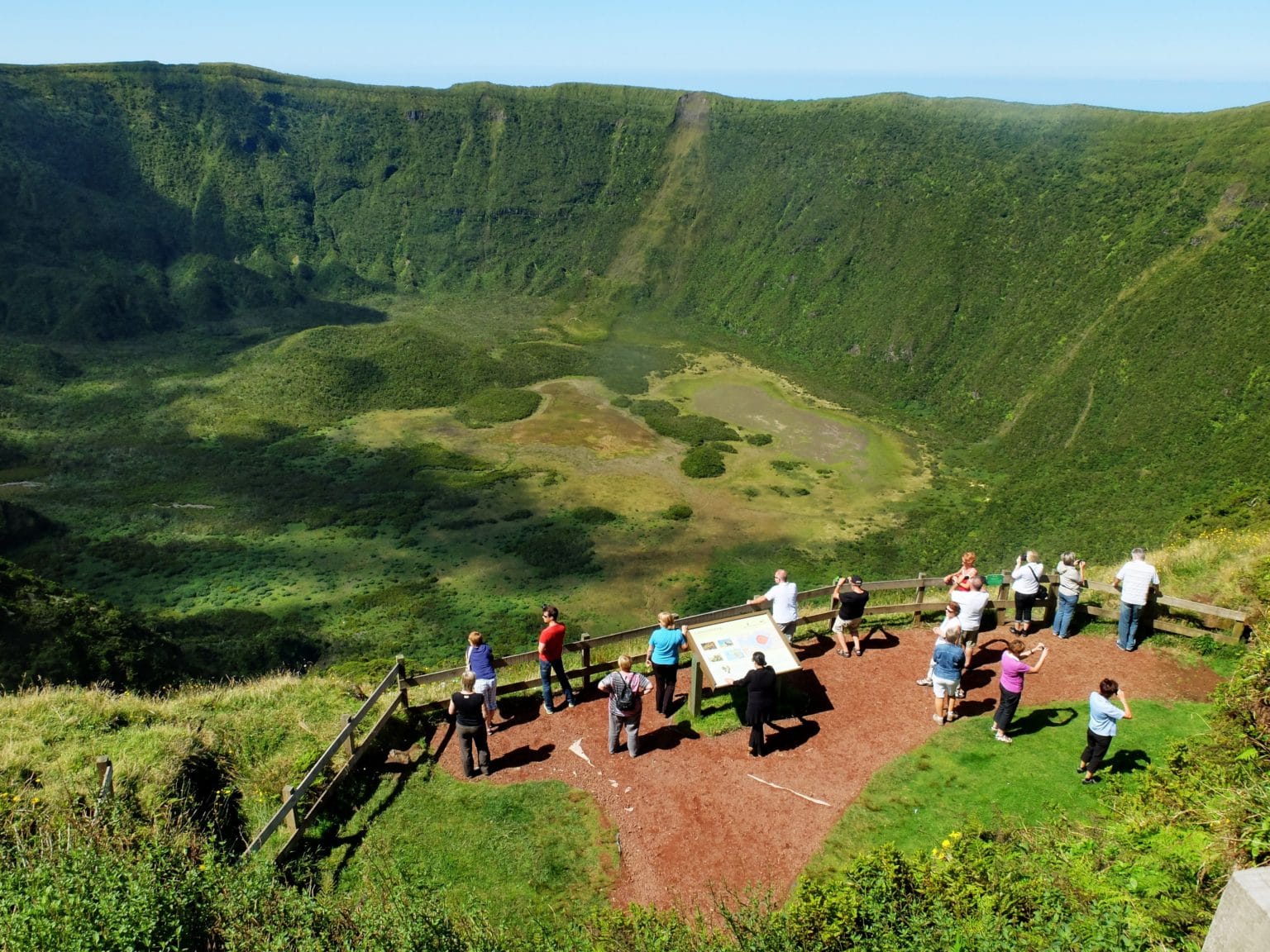
This makes for an adventurous day of exploration, history, and discovery, as well as impressive landscapes and sights to behold. Santorini’s volcanic landscape is best-enjoyed on a hiking adventure, and today you will take on the Fira – Oia hike which will take between 2 – 5 hours and can be taken fast or slow. This hike is suitable for everyone and those looking for more of a challenge can take the extra hour to detour to Skaros Rock, before continuing along the 10.5km (6.5 miles) path.
Day 11: Mykonos
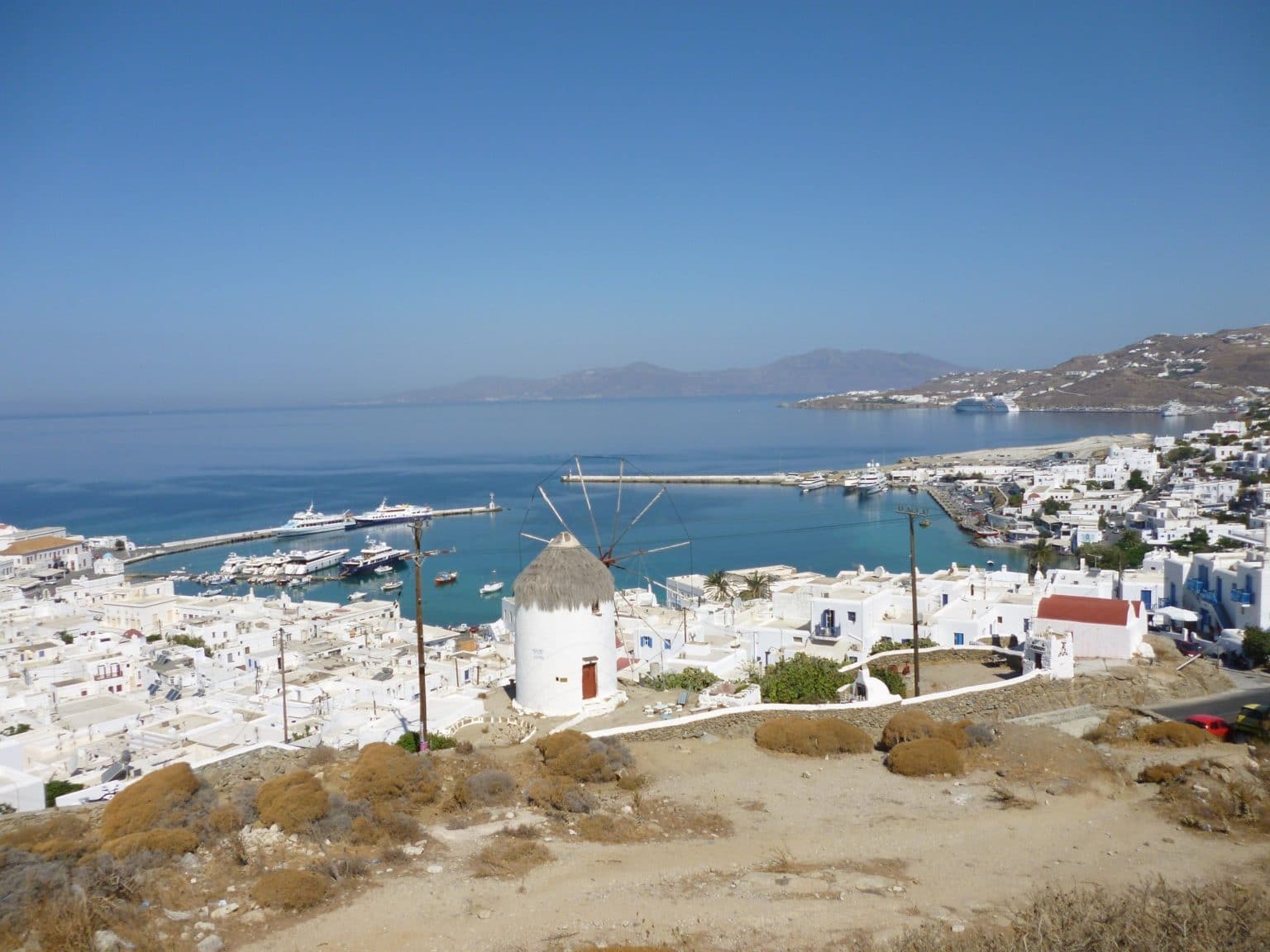
Your next island destination is Mykonos, and although it is renowned for its fantastic beaches, vibrant culture, and nature, there are a host of ancient sites you can choose to explore during your free time. Your first day in Mykonos can be enjoyed by taking in the vibes of the narrow streets, enjoying some local food, and perhaps opting for some adrenaline-filled water activities, before taking on some more ancient adventures tomorrow.

Day 12: Mykonos
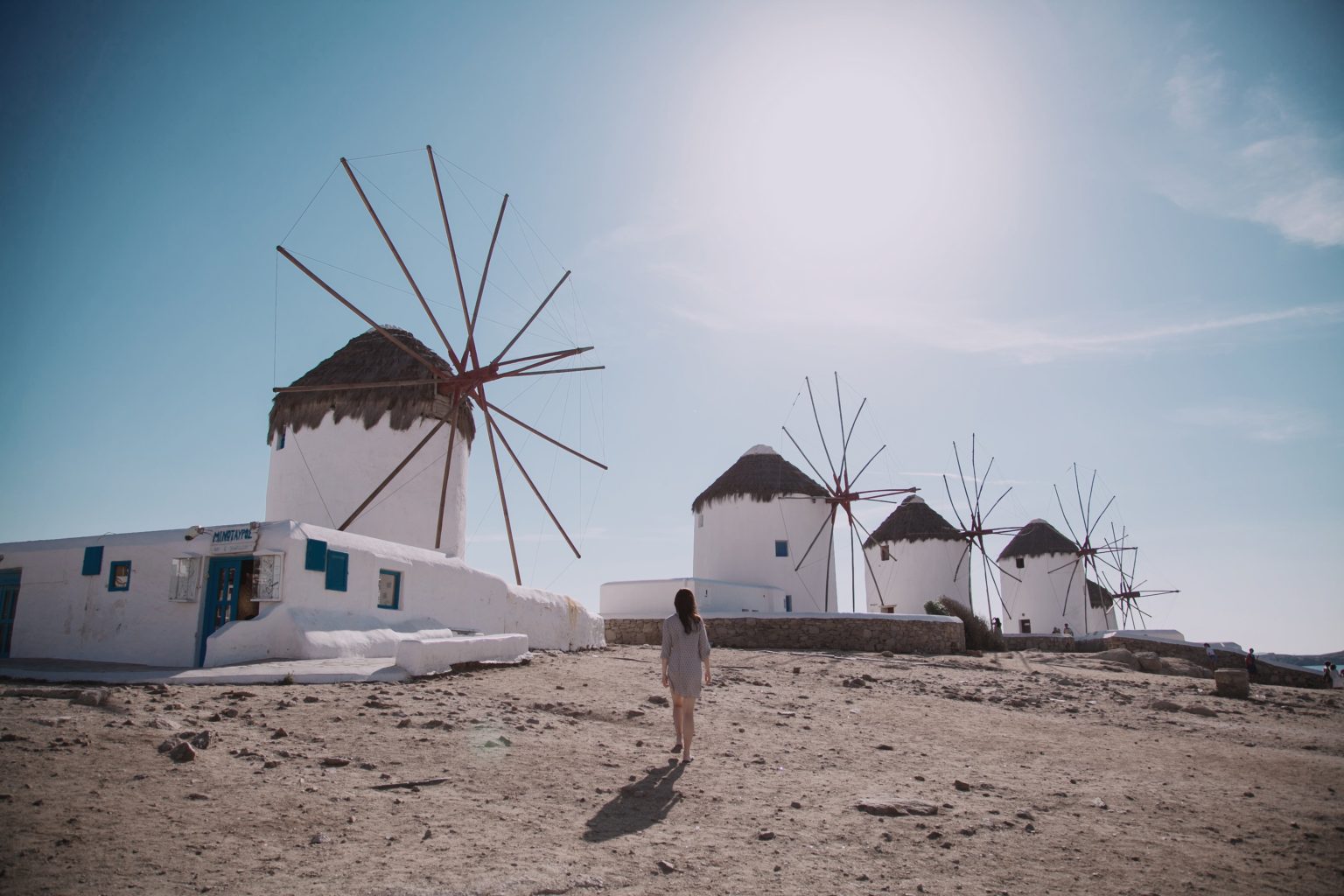
Today you will visit some of the most unspoiled beaches of the island, which you may even get to enjoy completely alone – a rarity on a Greek island. You can visit the Ano Mera village and its open-air market, and if you have some time today you may wish to take the 30-minute boat ride to visit Ancient Delos which served as the religious center of the Aegean and is said to have been the birthplace of the Greek Gods Apollo and Artemis. You can also opt to explore the Mykonos Ancient folklore museum as well as Kastro Panigraki and the archeological site of Ftelia.
Day 13: Return to Athens

This is a great way to end your trip, by spending the day how you like, depending on what you missed out on at the beginning or are interested in seeing this time around. Some great options are to visit the National Archaeology Museum, the ancient marketplace of Agora, the fascinating Byzantium Museum, the frescoed Church of the Holy Apostles and witness the Changing of the Guard at Syntagma Square.
Day 14: Departure from Athens

Your ancient Greece travel itinerary is complete, and you will depart from Athens today, no doubt with many memorable experiences under your belt, as well as a better understanding of what life was like in ancient Greece.
Best suited to Families, solo travelers, couples, and groups with a keen interest in ancient Greek history.
Jade Poleon
Here you can find some amazing travel stories, to tickle your travel bone or just to dream away. Sometimes we travel without moving.

From Milan to Lake Como: An 8-Day Exciting Vacation in Italy
Charming towns, picturesque trails, and hidden treasures

Our Day of the Dead Experience: An Enchanting Celebration
Our family will never forget this spooky adventure

The Local Cuisine of Morocco
Food is an essential part of any trip, and if you are planning to explore Morocco and are a foodie...

Unlock the world’s secrets

- How it Works
- Sustainability
- Start New Trip

Experience the power of the
Historical and spiritual tours.
Embark on a journey through rich world history with modern comforts. Our guided tours offer a step back in time to experience ancient civilizations in breathtaking historical settings. Let us create your historical adventure today!
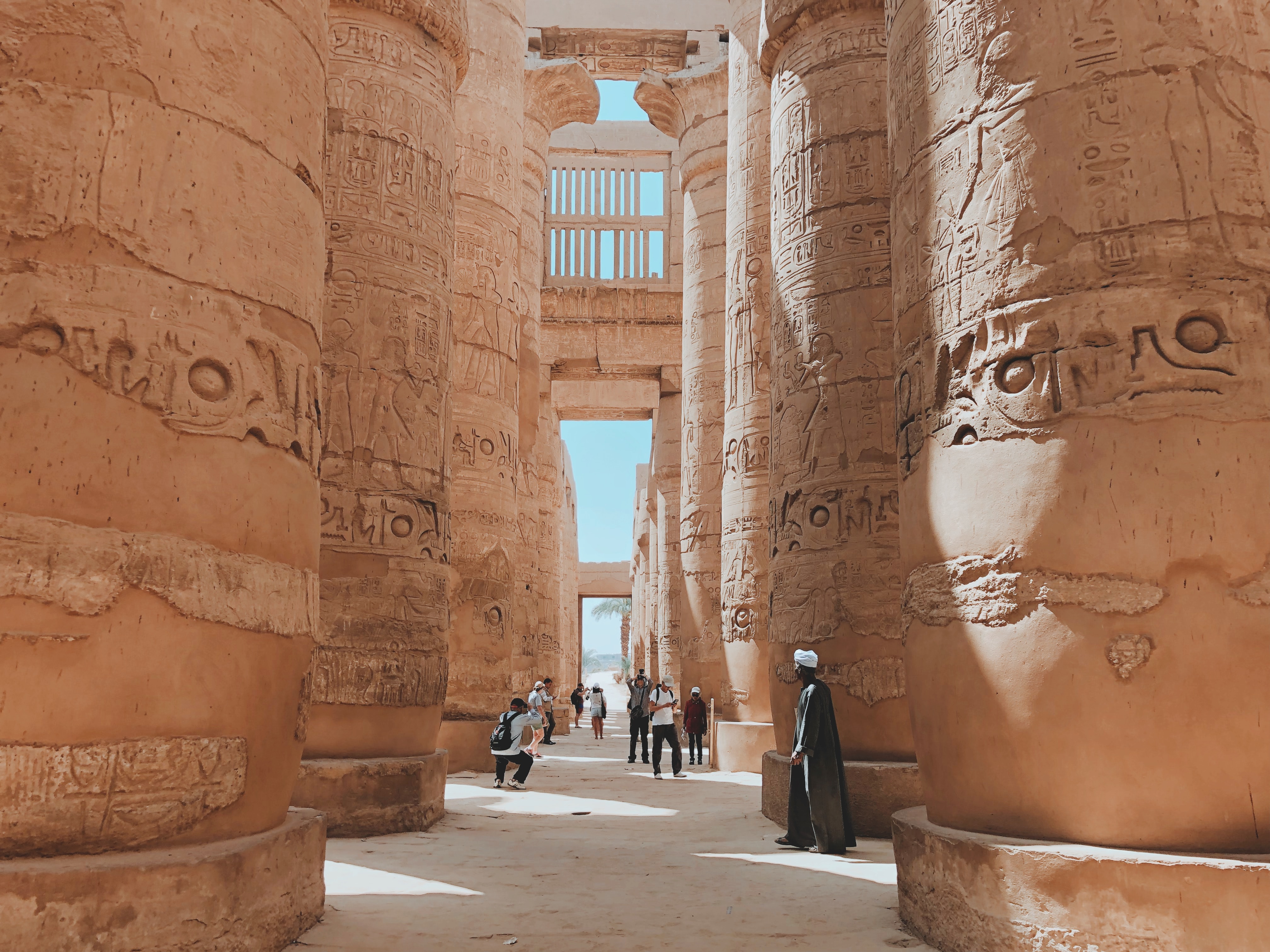
Dubai, Abu Dhabi, Sharjah
6 days, 5 nights.
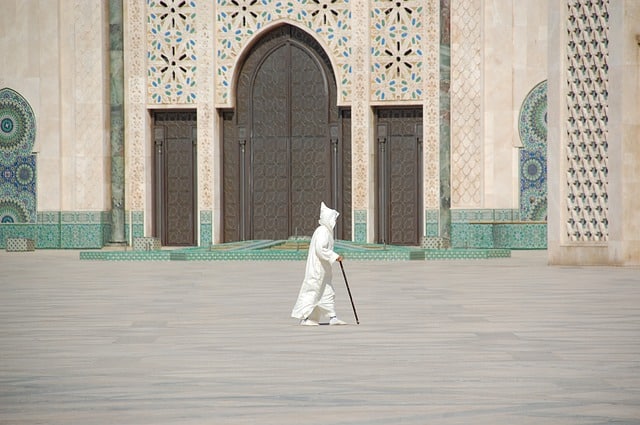
Your changes have been saved
Email Is sent
Please verify your email address.
You’ve reached your account maximum for followed topics.
Read update
See Tomb of Agamemnon: One Of The Largest & Most Elaborate (& It Pre-Dates Ancient Greece)
- The Tomb of Agamemnon in Mycenae, Greece is over 3,000 years old, making it a key monument in Bronze Age history.
- The tomb's architecture is a marvel of ancient design, with a massive corbeled dome and two lintel blocks totaling 120 tons.
- Visiting the Tomb of Agamemnon is a must for history enthusiasts to explore Mycenaean civilization and Greek history.
The Tomb of Agamemnon, also known as the Treasury of Atreus, is a large Bronze Age tomb in Mycenae, Greece. It is the largest and most impressive ancient tomb in Mycenae, Greece and (along with the adjacent Mycenae Acropolis Archeological Site) is one of the top attractions of early Greece before the Classic Period.
The Tomb of Agamemnon is over 3,000 years old and dates from around the time of the Trojan War. Ancient tombs are some of the best monuments to have survived today. Additional preserved ancient funerary monuments range from the famous Great Pyramid of Egypt to a restored Stone Age long barrow in England called Belas Knap .
What makes the Tomb of Agamemnon so important to history? Here's what you should know!
UPDATE: 2024/06/24 18:39 EST BY KRISTYN MEYER
This article was updated on June 24, 2024, to reflect updated information about the tomb and its surrounding area.
Discover The Ancient Acropolis Of Mycenae: Perhaps The Largest City Of Bronze Age Greece
Mycenae and Tiryns are the best peek into the Bronze Age Mycenaean period of Greece & are prominent in the Iliad and Odyssey.
Who Was The Tomb Of Agamemnon Built For?
There have been speculations throughout the years, but are they accurate.
The Iliad heroes, Agamemnon and Menelaus, were the twin sons of Atreus. The 2003 movie Troy starring Brad Pitt is only loosely based on the ancient legend of Troy. According to the legend, Agamemnon was killed by his wife, Clytemnestra, after returning from the Trojan War.
The Tomb of Agamemnon was built between 1300 and 1250 BC and is the largest and most elaborate tomb of its kind, dating from the Aegean Bronze Age. It is located in the ancient city of Mycenae.
It is believed that the ancient Greek city, located near the well-known area of Athens , peaked around 1350 BC and had a peak population of around 30,000. However, despite popular belief, the Tomb of Agamemnon is not actually the burial site of the famous Iliad and the Siege of Troy . Neither is it a treasury nor the tomb of Atreus.
That being said, its size and grandeur would historically suggest that an ancient ruler was buried there. The connection with the mythical kings of Agamemnon and Atreus dates from the 18th century when professional archeology was still in its infancy.
While most researchers agree it was a tomb, to this date no archeological evidence has been found to support that belief.
The Tomb Of Agamemnon Is A Marvel Of Bronze Age Greek Architecture
The tomb is a 'tholos' or beehive tomb and is by far the best preserved of the beehive tombs in mycenae.
When you see the Tomb of Agamemnon, the site will likely surprise you. The main tomb has a circular burial chamber (called a thalamos ) that is topped with a corbeled dome. The dome is the largest known of the ancient world for well over a thousand years until the Roman period.
While the tomb is well-preserved, it is still regarded as a ruin. The facade was once decorated with marble columns and sculptures and is quite impressive at 10.5 meters, or 35 feet high, with the doorway itself rising 5.4 meters or 18 feet.
The two lintel blocks above the doorway are enormous, and it is the heaviest piece of masonry known from Greek architecture.
The innermost lintel block is 8 meters (26 feet) long, 5 meters (16 feet) wide, and around 1.2 meters (4 feet) thick. The block weighs a staggering 120 tons and may have required as many as 1,000 people to lift it into position when it was first constructed.
Compare this massive tomb to the Bin Tepe in Turkey , with its over 100 massive burial mounds.
Olympia Is The Birth Place Of The Olympic Games & Has Many Ancient Greek Ruins To Explore
See the original Olympic stadium at Olympia and discover the sacred origins of the sanctuary dedicated to the god Zeus.
What To Know About Visiting The Tomb Of Agamemnon
Seeing the tomb of agamemnon is a must for anyone interested in ancient greek history.
Mycenae was one of the major centers of Greek civilization before the Greek Dark Ages and the Classic Greek period. The period of Greek history from 1600 BC to 1100 BC is called the Mycenaean period, after the city of Mycenae. Mycenae is located on the Peloponnese Peninsula and can be visited from Athens.
The Tomb of Agamemnon is located only 400 meters (yards) southwest of the Acropolis of Mycenae. Visiting the tomb should be part of visiting the wider Mycenae archeological site. After visiting the Tomb of Agamemnon, pop into the impressive National Archeological Museum in Athens and see artifacts that were previously recovered from the ancient site.
There are many unique things about Greece that will encourage you to visit the country and explore the various towns and cities that contributed to our global history. The Tomb of Agamemnon is just one of many spectacular monuments the country offers.
- Logout Login
- Adventure Holidays
- Weekend Getaways
- Driving Holidays
- Travel News
Top Searches
Delhi Airport Roof Collapse
International Getaways
India Train Routes
Tiger Population Countries
Oldest Waterfall
Expensive Cities 2024
5 ancient cities that are now underwater
Times of India TIMESOFINDIA.COM / Updated : Jun 25, 2024, 14:03 IST
You're Reading
As per the records, many cities ended up submerged due to rising sea levels, natural disasters, or intentional flooding for dam construction over the centuries. These underwater cities serve as powerful reminders of nature's form … Read more
As per the records, many cities ended up submerged due to rising sea levels, natural disasters, or intentional flooding for dam construction over the centuries. These underwater cities serve as powerful reminders of nature's formidable force. Read less
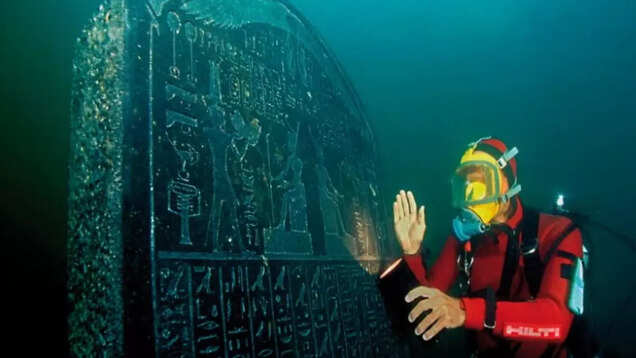
12 oldest cities in the world; know which Indian city is on the list
Dwarka, india, more from travel news.

Baiae, Italy
Lion city, china.
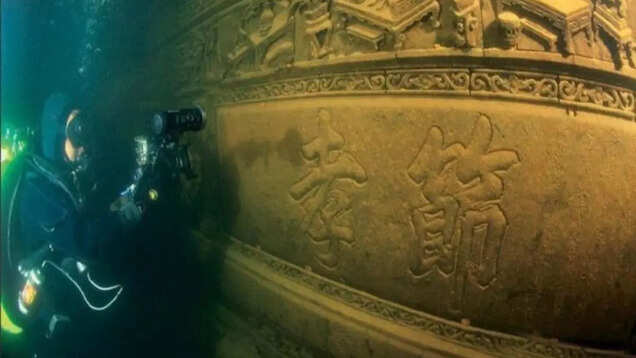
Port Royal, Jamaica
Heracleion, egypt.
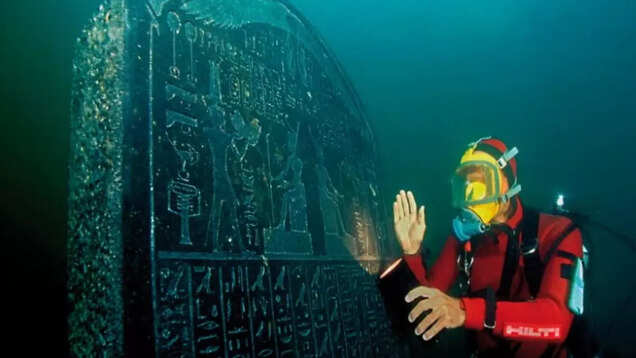
Comments (0)

Refrain from posting comments that are obscene, defamatory or inflammatory, and do not indulge in personal attacks, name calling or inciting hatred against any community. Help us delete comments that do not follow these guidelines by marking them offensive . Let's work together to keep the conversation civil.
Comments ( ) Sort: Newest UpVoted Oldest Discussed Down Voted closecomments

SIGN IN WITH
Or post without registration.

Visual Stories

Popular Galleries

From Pangong to Tekapo, exploring the bluest lakes on Earth TRAVEL TRENDS , WORLD

10 cleanest countries in the world in 2024 TRAVEL TRENDS , WORLD

Chasing tigers: Countries with maximum tiger population TRAVEL TRENDS , WORLD
Trending stories.
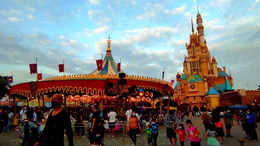
- 6 iconic landmarks in Hong Kong to add to your travel bucket list

Supai, the only place in America where mail is still delivered by mule!

Chaukori - A Himalayan gem worth visiting in every sense!

Most expensive countries in the world

World's 8 most beautiful castles that look straight out of a fairytale
- 1 5 ancient cities that are now underwater
- 2 World's most beautiful places you can't miss
- 3 Hamta Village: A hidden gem waiting to be explored in Himachal Pradesh this summer
- 4 Mussoorie: The hill town’s popular attractions and best time to visit
- 5 Top relaxing weekend escapes from Pune

THE DEFINITIVE GUIDE TO DESTINATIONS, ITINERARIES, THINGS TO DO, RESTAURANTS, NIGHTLIFE and LOTS MORE!
FOLLOW US ON
Places to visit.
- Places to visit in Bangalore
- Places to visit in Mumbai
- Places to visit in Delhi
- Places to visit in Goa
- Hotels in Goa
- Hotels in Jaipur
- Hotels in Shimla
- Hotels in Mumbai
Things To do
- Things to do in Goa
- Things to do in Mumbai
- Things to do in Bangalore
- Things to do in Delhi
Travel Inspiration
- Visa on arrival for Indians
- Honeymoon Places in india
- Hill Stations in India
- Weekend getaways in Mumbai
- Weather in Delhi
- Weather in Chennai
- Weather in Bangalore
- Weather in Mumbai
Best Beaches
- Goa Beaches
- Mumbai Beaches
- Pondicherry Beaches
- Kerala Beaches
- Restaurants in Bangalore
- Restaurants in Chennai
- Restaurants in Pune
- Restaurants in Jaipur
- Hill Station near Delhi
- Winter trip to Ladakh
- Places to visit in Kerala
- Winter Honeymoon Destinations
- UK visa guide for Indians
- Winter Trip to Manali
- Vaishno Devi Yatra
- Special Train Ticket Booking
- HP inter-state Bus
- Honeymoon Destinations India
Latest News
- 5 places to visit in Barbados; the island hosting T20 World Cup finals between India and South Africa
- Bannerghatta Biological Park introduces leopard safari and afforestation efforts
- Lake Titicaca: What’s so special about the highest navigable lake in the world?
- 5 best places near Bengaluru for one-day trips
Congratulations!
You have been successfully added to the mailing list of Times of India Travel. To complete the subscription process, kindly open your inbox and click on the confirmation link which has been emailed to you.
Share with friends
Thank You for sharing! Your friend will receive the article link on email mentioned.
- (For more than one recipient, type addresses separated by commas)
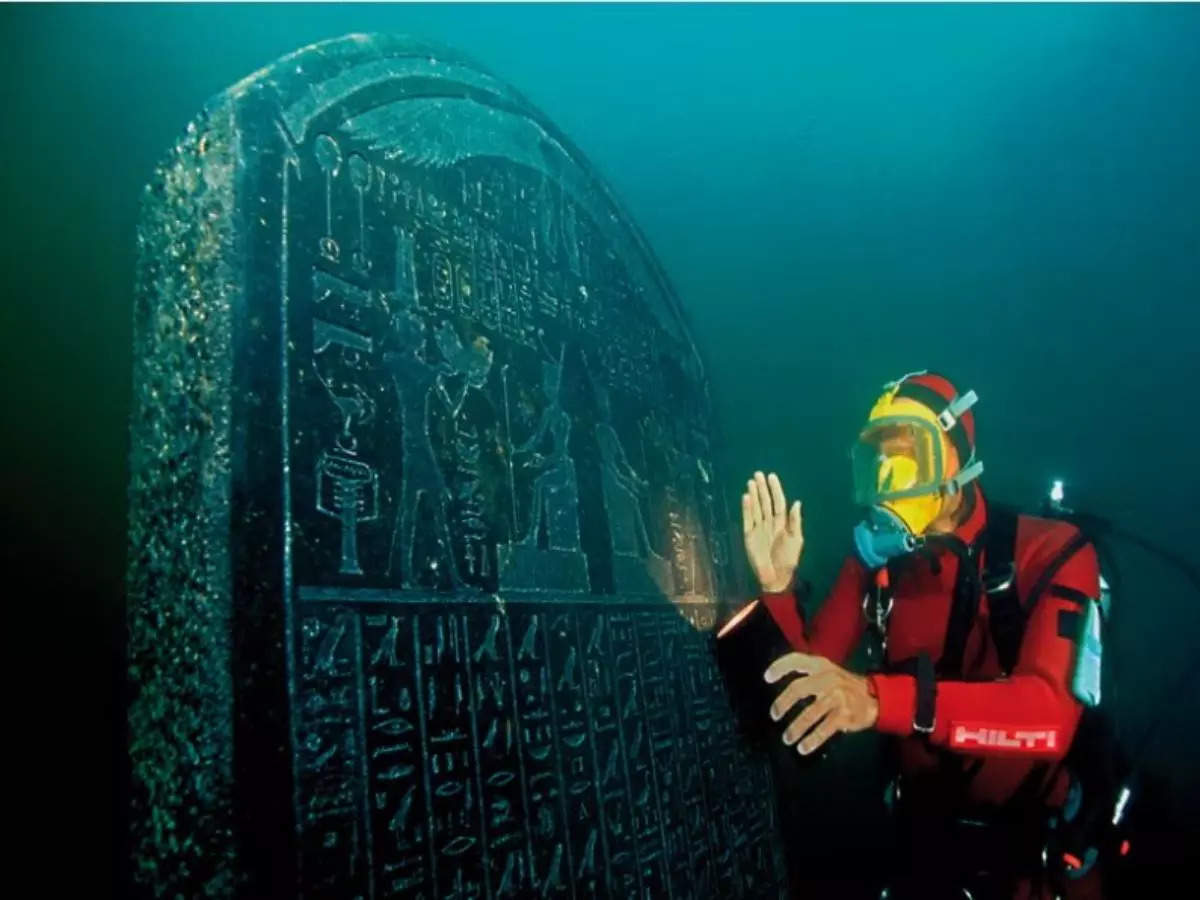
As per the records, many cities ended up submerged due to rising sea levels, natural disasters, or intentional flooding for dam construction over the centuries. These underwater cities serve as power...

The Swedish secret to the perfectly balanced vacation
Getting your Goldilocks on can help you restore a sense of spontaneity to your travels without hitting a wall.
Key takeaways
Summary is AI-generated, newsroom-reviewed.
- “Lagom” is gaining steam as a mind-set that can be applied to travel.
- It’s Swedish for “not too much, not too little.”
- It emphasizes having balance, avoiding stress, packing light and taking breaks (“fika”).
Did our AI help? Share your thoughts.
If you’re the planning type, your vacations may begin to feel so structured that you need a do-nothing holiday by the time you return. Sound familiar? It may be time to consider the Swedish practice of “lagom.”
The word, pronounced lah-gom, means “not too much, not too little.” When applied to a trip, it means striking the ideal balance of exercise, adventure, food and relaxation.
Remember the coziness craze inspired by the Danish concept of “hygge ”? Similarly, lagom has been practiced for generations but is now gaining steam worldwide. Lagom is an overarching mind-set that applies to balancing all aspects of life, but it is ideal for travel.
Helen Russell, journalist and author of “The Atlas of Happiness: The Global Secrets of How to Be Happy ,” says that the word “lagom” derives from the Swedish word “lag,” or “team,” and that Swedish folklore suggests that “laget om” — or “around the team” — was a phrase Vikings used to make sure everyone got their fair share when a horn full of mead was passed around.
There’s no exact science or recipe to lagom; it varies by each individual’s own balance. Lola Akinmade Åkerström, travel photographer and author of the book “Lagom: The Swedish Secret of Living Well ,” says to think of lagom as an internal scale that must always stay balanced. Too much or too little of any one thing stresses the scale.
“Lagom actually means the optimal (not best) solution for maintaining balance and removing stress within your control,” she says. “As a personal ethos, it’s trying to help you live a sustainable life you can comfortably maintain.”
This means that lagom can be as simple as the “just-right” amount of salt in your soup or an entire idea such as eschewing bigger and better. Here are a few practical ways to fold lagom into your travel plans.
Start with a declutter
I grew up in a Southern household devoted to maximalism, so every suitcase-packing session ended with a good sit-and-zip because you never knew when you’d need a silk caftan and feather fascinator. But packing items you don’t need is the antithesis of lagom. Clutter can make a person anxious. Packing light (but smart), as with a travel uniform , better suits lagom travel.
My husband once told me that I have an otherworldly talent of turning our hotel room into a disaster zone in a matter of seconds. But with the practice of lagom, I now spend five minutes organizing my belongings and there’s an instant sense of calm in a new environment.
Akinmade Åkerström says that while traveling, you want to think simple, practical and sturdy, “from the gear you pack, so it lasts for a long time, to the activities you engage in.”
Pause for fika
In Sweden, “fika” is loosely defined as a practice to stop and recharge. And while Swedes do this on a daily basis, a vacation is the perfect time to dip your toe into the concept.
“This social act is often translated as taking a break several times during the day to socialize with friends, loved ones and colleagues over cups of coffee and pastries like cinnamon buns,” Akinmade Åkerström says.
“The unspoken reason why we fika is to center and reconnect with ourselves.”
Fika means swapping your order-ahead Starbucks latte for a sit-and-chat over a drink in a real mug. For solo travelers, it’s a fine time to people-watch in a new environment.
In its simplest form, fika is about recharging — perhaps by sitting for half an hour to rest your tired feet, or taking a refreshing nap before your next tour.
Leave room for spontaneity
Confession: I used to rely heavily on my No-Fun-Type-A Travel Planning Document, a spreadsheet that documented down-to-the-minute plans for every single day of our vacation. A sample:
- 6 a.m. Wake up everyone!
- 6:30 a.m. Please shove breakfast in your face, and make it snappy.
- 6:35 a.m. Leave hotel for a must-do tour. (Don’t be late!)
- Noon: Exhausted, but who cares because we have coveted restaurant lunch reservations!
- 3 p.m. Not hungry? It doesn’t matter — we have a food tour on tap.
- 4 p.m. Wanna nap? Too bad, it’s museum time.
- 5 p.m. Happy hour? What’s that? No one here is happy.
I’ve since pared down my planning to a skeletal version that contains important details and a few plans but also some room for relaxation or spontaneity.
My husband and I have adopted a new acronym that fits with lagom travel: T-WOO, for “The world is our oyster.” In other words, no plans!
This approach has led to glorious days spent zooming around Laos on a motorbike, stumbling upon perfectly briny oysters near a peat-fed stove in Ireland, and making a last-minute decision to drive the Mississippi Blues Trail and finding live music in a smoky juke joint.
Spread out the indulgences
I don’t have enough fingers to count the number of times I’ve overeaten (and over-imbibed) on vacation. I wish I could turn back the clock and tell 21-year-old me that “all-you-can-drink mimosas” doesn’t mean you actually have to drink all the mimosas.
With lagom, the idea is to savor. Swedes have a diet rich in whole grains, lean proteins, veggies and berries — but they also have a serious sweet tooth (as in those beloved cinnamon buns for fika).
So eat the rich dessert and drink the beautifully made cocktail or mocktail, but do so with a sense of balance. For me, this means putting the brakes on at the breakfast buffet so that I can splurge on the multicourse prix fixe dinner.
Exercise — but also rest
I’ve always envied a skier’s vacation that includes a vigorous day of swooshing down the slopes and then the reward of an après-ski hot toddy and a warm soak.
Lagom allows you to forgo the hotel gym and instead enjoy the offerings of your destination. I like to think of it as making exercise local: a jog along the sea in San Juan, Puerto Rico; a hike in a Swiss forest; a bike ride in Amsterdam .
Aside from T-WOO, Russell suggests we embrace the letters WWASD: What Would a Swede Do? In short: Be mindful of biting off more than you can chew.
“To vacation like a Viking, lagom-style, think WWASD — is your cup really half-empty, or is there, in fact, just enough?” Russell says.
Anne Roderique-Jones is a travel writer who splits her time between New York and New Orleans. You can follow her on Instagram: @anniemarie_ .
More travel tips
Vacation planning: Start with a strategy to maximize days off by taking PTO around holidays. Experts recommend taking multiple short trips for peak happiness . Want to take an ambitious trip? Here are 12 destinations to try this year — without crowds.
Cheap flights: Follow our best advice for scoring low airfare , including setting flight price alerts and subscribing to deal newsletters. If you’re set on an expensive getaway, here’s a plan to save up without straining your credit limit.
Airport chaos: We’ve got advice for every scenario , from canceled flights to lost luggage . Stuck at the rental car counter? These tips can speed up the process. And following these 52 rules of flying should make the experience better for everyone.
Expert advice: Our By The Way Concierge solves readers’ dilemmas , including whether it’s okay to ditch a partner at security, or what happens if you get caught flying with weed . Submit your question here . Or you could look to the gurus: Lonely Planet and Rick Steves .


IMAGES
VIDEO
COMMENTS
Travel opportunities within the ancient Greek world largely depended on status and profession; nevertheless, a significant proportion of the population could, and did, travel across the Mediterranean to sell their wares, skills, go on religious pilgrimage, see sporting events or even travel simply for the pleasure of seeing the magnificent sights of the ancient world.
Travel in classical antiquity over long distances was a specialised undertaking. Most travel was done in the interest of warfare, diplomacy, general state building, or trade. Social motivations for travel included visiting religious sites, festivals such as the Olympics, and health-related reasons.Most travel was difficult and expensive, due to the danger of violence, the scarcity of well ...
Funeral relief (2nd century ) depicting an Ancient Roman carriage. (CC BY-SA 3.0) Romans would travel in a raeda, a carriage with four noisy iron-shod wheels, many wooden benches inside for the passengers, a clothed top (or no top at all) and drawn by up to four horses or mules. The raeda was the equivalent of the bus today and Roman law ...
17. Petra, Jordan - A Historical Location Carved in Rose. Hidden within the rugged cliffs of Jordan, Petra's rose-red stone facades hold secrets of an ancient civilization. A UNESCO World Heritage Site and one of the New Seven Wonders of the World, the abandoned city of Petra draws travelers from far and wide.
In fact, travel was not possible for most people in ancient times. Travel was often difficult and full of dangers such as disease, starvation, dehydration, or death by wild animals. Because of this, travel was often seen as too risky unless absolutely necessary, such as for relocation, or religious, political, or medical purposes.
travel in the company of an esteemed expert: All our tours that include visits to Pompeii are led by expert Guide Lecturers. Our roster of experts ranges from published authors to a specialist in ancient glass, and from an archaeologist who has excavated in Pompeii, to a Roman Empire specialist with a particular interest in Roman coinage.
Ancient Greece. Ancient Greece or Classical Greece was a civilization which emerged around the 8th century BC, and was annexed by the Roman Empire in the second century BC. Ancient Greece is remembered for its architecture, philosophy and other ideas, which became the foundation of modern Europe.
In the heart of modern Athens, the iconic rock of the ancient Acropolis rises to greet every new visitor in turn.The cornerstone of European civilisation, it is still a marvel, a reminder of what mankind is capable. You'll finally see with your own eyes the creations of Athens' Golden Age: the Parthenon, the Propylaia, the Temple of Athena Nike, the Erechtheum with its famous Caryatids.
After familiarizing yourself with the model's structure and functionality, use the map to explore the ancient world. ORBIS has been created to foster new ways of studying the ancient world. ... as a whole by identifying the relative position of particular elements of the network and illustrating the impact of travel speed and especially ...
After, travel by coach to the Peloponnese, a peninsula separated from the mainland by the Corinth Canal. On the way, stop to see the ruins and museum of Ancient Corinth, a once-thriving city that was demolished by the Romans in 146 B.C. only to be rebuilt a century later. It was here that Saint Paul wrote his two letters, First and Second ...
23 amazing ancient cities. 1 of 24. CNN —. Ancient sites that have survived centuries, or even millennia, haven't fared so well in the 21st century. The destruction at Palmyra in Syria, the ...
The earliest settlements in Cyprus appeared during the Neolithic era, around 7000-6000 BCE. With the development of copper between 3900 BCE and 2500 BCE, a flourishing trade brought wealth and prosperity to the island. Cyprus became a leading commercial centre between the Near East and the West. However, the event that stamped permanently the ...
2. Machu Picchu. Machu Picchu is an extraordinary ancient stone city along the Inca Trail in Peru. Believed to have been constructed by the Inca Yupanqui people sometime during the mid-15th century, the ruins of Machu Picchu sit high atop a granite mountain. Some of the most impressive structures include the semi-circular Temple of the Sun, the ...
A Smithsonian Magazine Contributing Writer, Tony Perrottet is the author of five travel and history books, including Pagan Holiday: On the Trail of Ancient Roman Tourists and The Sinner's Grand ...
This ancient 140-mile (225-kilometer) highway ran between Angkor, Cambodia, and Phimai, Thailand, and was sacred to the Cambodian empire's "god-kings," who traveled the highway visiting ...
There are many references to travel in the literature of the ancient world. You only have to think of work like Homer's epic poem, The Odyssey, composed almost 3,000 years ago, to realise that ...
Heidi Köpp-Junk of Universität Trier wrote: "Travel was a crucial element of ancient Egyptian culture. An extensive traffic system by land and by water already existed as early as the Old Kingdom, including various means of transport that did not fundamentally change right through to the New Kingdom. Traveling activity attested for various ...
Tourism in ancient Rome was limited to the Roman upper class due to its expense and long travel times. Travel was made difficult due to shipwrecks, storms, poor maps, and a lack of modern transportation methods.Common destinations for ancient Roman tourists were Greece, Egypt, and the coast of Campania.Roman tourists sought out sites in Greece of cultural and historical importance, such as the ...
Explore ancient civilizations and historical wonders with expert guides. Embark on world culture tours with National Geographic. Expert guides explain historic treasures & archaeological wonders.
Map created by Stanford University's ORBIS project. The map above is an Isochrone map which shows how long it would have taken someone to travel from Rome to the farthest reaches of the Roman Empire at its peak (roughly 200 CE/AD). Travelling within the core of the Empire could have be done in under a week, but travelling all the way to the ...
The world is full of ancient history! Ancient ruins are everywhere in the six primarily populated continents. Follow these travel tips for visiting ancient sites and cultural heritage landmarks.. For instance, there are many ancient Roman sites in Europe.The Middle East also has sites that date past Biblical times, as does Asia.In the United States, you can visit ancient tribal sites, such as ...
Greece is known for many things, and the country's history is one of the main reasons that people travel from all over the world. With an array of impressive sites, ancient ruins, museums, and stories to see and hear, Greece is a perfect place to step back in time and learn about the ancient world. Let us guide you with a 14-day ancient Greece travel itinerary ideal focused on ancient Greece.
Venture into Nature's Unseen Realms with Our New Book Atlas Obscura: Wild Life Pre-Order Now. So wrote Greek geographer Pausanias, one of the very first travel writers, in his second-century book ...
An ancient beach that was destroyed by the eruption of Mount Vesuvius nearly 2,000 years ago has reopened to the public after restoration works. The beach at the Herculaneum archaeological park is ...
The ancients were way ahead of us. Pondering what we now call the Seven Wonders of the Ancient World, the Greek writer Philo of Byzantium (circa 5th or 6th century CE, and the second writer to ...
Best of Greece. Explore the fascinating of ancient Greece and learn about the the country's great history during our 6 days trip and explore the highlights of Athens and enjoy visiting the amazing Parthenon and the world-famous Acropolis and the Roman Temple of Ancient Zeus, then visit Cape Sounio and travel to the location of Greece's famous Oracle at Delphi, and learn about it's mythology!
The Tomb of Agamemnon was built between 1300 and 1250 BC and is the largest and most elaborate tomb of its kind, dating from the Aegean Bronze Age. It is located in the ancient city of Mycenae. It is believed that the ancient Greek city, located near the well-known area of Athens, peaked around 1350 BC and had a peak population of around 30,000.
Terminal 1 roof collapse at Delhi Airport: Important travel advisory for passengers; More News. Rooted in Hindu mythology, Dwarka is believed to be the fabled city associated with Lord Krishna, as ...
The Therapy Room at Argos in Cappadocia. Argos in Cappadocia. The caves that comprise this spa, which opened in April, combine with five mansions dating from the 1800's to create the 17,244 ...
Following the ancient Swedish philosophy of lagom means striking the ideal balance of exercise, adventure, food and relaxation. ... Anne Roderique-Jones is a travel writer who splits her time ...